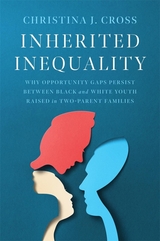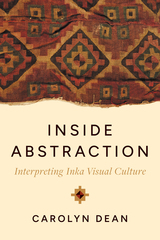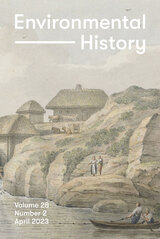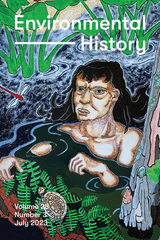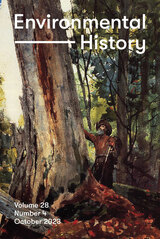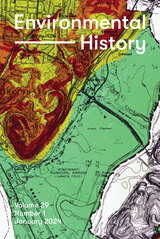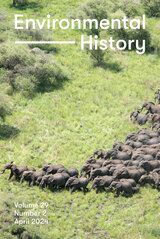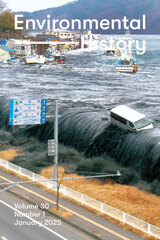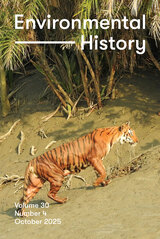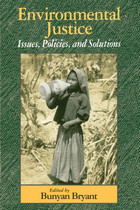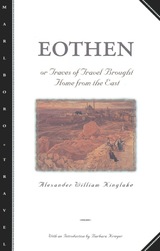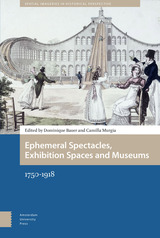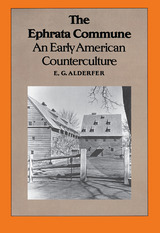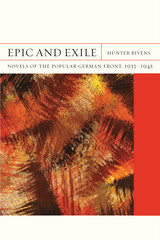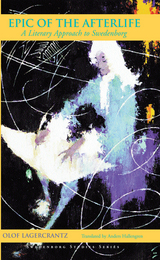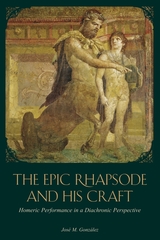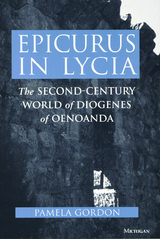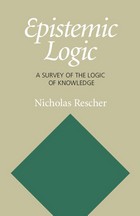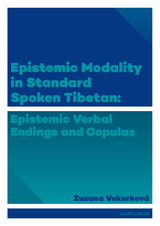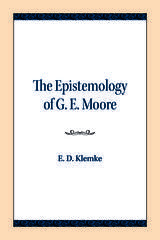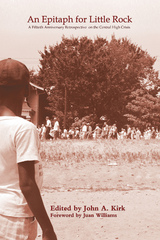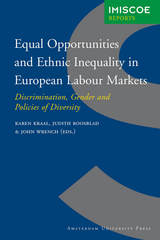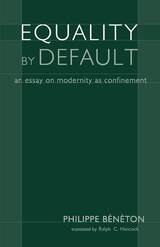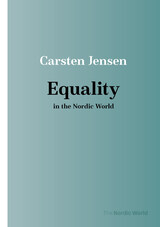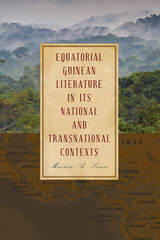Environmental History, volume 28 number 2 (April 2023)
The University of Chicago Press
University of Chicago Press Journals, 2023 This is volume 28 issue 2 of Environmental History. Environmental History (EH) is the world’s leading scholarly journal in environmental history and the journal of record in the field. Scholarship published in EH explores the changing relationships between humans and the environment over time. This interdisciplinary journal brings together insights from geography, anthropology, the natural sciences, and many other disciplines to inform historical scholarship.
Environmental History, volume 28 number 3 (July 2023)
The University of Chicago Press
University of Chicago Press Journals, 2023 This is volume 28 issue 3 of Environmental History. Environmental History (EH) is the world’s leading scholarly journal in environmental history and the journal of record in the field. Scholarship published in EH explores the changing relationships between humans and the environment over time. This interdisciplinary journal brings together insights from geography, anthropology, the natural sciences, and many other disciplines to inform historical scholarship.
Environmental History, volume 28 number 4 (October 2023)
The University of Chicago Press
University of Chicago Press Journals, 2023 This is volume 28 issue 4 of Environmental History. Environmental History (EH) is the world’s leading scholarly journal in environmental history and the journal of record in the field. Scholarship published in EH explores the changing relationships between humans and the environment over time. This interdisciplinary journal brings together insights from geography, anthropology, the natural sciences, and many other disciplines to inform historical scholarship.
Environmental History, volume 29 number 1 (January 2024)
The University of Chicago Press
University of Chicago Press Journals, 2024 This is volume 29 issue 1 of Environmental History. Environmental History (EH) is the world’s leading scholarly journal in environmental history and the journal of record in the field. Scholarship published in EH explores the changing relationships between humans and the environment over time. This interdisciplinary journal brings together insights from geography, anthropology, the natural sciences, and many other disciplines to inform historical scholarship.
Environmental History, volume 29 number 2 (April 2024)
The University of Chicago Press
University of Chicago Press Journals, 2024 This is volume 29 issue 2 of Environmental History. Environmental History (EH) is the world’s leading scholarly journal in environmental history and the journal of record in the field. Scholarship published in EH explores the changing relationships between humans and the environment over time. This interdisciplinary journal brings together insights from geography, anthropology, the natural sciences, and many other disciplines to inform historical scholarship.
Environmental History, volume 29 number 3 (July 2024)
The University of Chicago Press
University of Chicago Press Journals, 2024 This is volume 29 issue 3 of Environmental History. Environmental History (EH) is the world’s leading scholarly journal in environmental history and the journal of record in the field. Scholarship published in EH explores the changing relationships between humans and the environment over time. This interdisciplinary journal brings together insights from geography, anthropology, the natural sciences, and many other disciplines to inform historical scholarship.
Environmental History, volume 29 number 4 (October 2024)
The University of Chicago Press
University of Chicago Press Journals, 2024 This is volume 29 issue 4 of Environmental History. Environmental History (EH) is the world’s leading scholarly journal in environmental history and the journal of record in the field. Scholarship published in EH explores the changing relationships between humans and the environment over time. This interdisciplinary journal brings together insights from geography, anthropology, the natural sciences, and many other disciplines to inform historical scholarship.
Environmental History, volume 30 number 1 (January 2025)
The University of Chicago Press
University of Chicago Press Journals, 2025 This is volume 30 issue 1 of Environmental History. Environmental History (EH) is the world’s leading scholarly journal in environmental history and the journal of record in the field. Scholarship published in EH explores the changing relationships between humans and the environment over time. This interdisciplinary journal brings together insights from geography, anthropology, the natural sciences, and many other disciplines to inform historical scholarship.
Environmental History, volume 30 number 2 (April 2025)
The University of Chicago Press
University of Chicago Press Journals, 2025 This is volume 30 issue 2 of Environmental History. Environmental History (EH) is the world’s leading scholarly journal in environmental history and the journal of record in the field. Scholarship published in EH explores the changing relationships between humans and the environment over time. This interdisciplinary journal brings together insights from geography, anthropology, the natural sciences, and many other disciplines to inform historical scholarship.
Environmental History, volume 30 number 3 (July 2025)
The University of Chicago Press
University of Chicago Press Journals, 2025 This is volume 30 issue 3 of Environmental History. Environmental History (EH) is the world’s leading scholarly journal in environmental history and the journal of record in the field. Scholarship published in EH explores the changing relationships between humans and the environment over time. This interdisciplinary journal brings together insights from geography, anthropology, the natural sciences, and many other disciplines to inform historical scholarship.
Environmental History, volume 30 number 4 (October 2025)
The University of Chicago Press
University of Chicago Press Journals, 2025 This is volume 30 issue 4 of Environmental History. Environmental History (EH) is the world’s leading scholarly journal in environmental history and the journal of record in the field. Scholarship published in EH explores the changing relationships between humans and the environment over time. This interdisciplinary journal brings together insights from geography, anthropology, the natural sciences, and many other disciplines to inform historical scholarship.
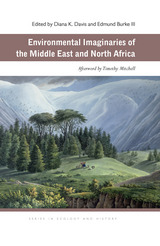 Environmental Imaginaries of the Middle East and North Africa
Diana K. Davis
Ohio University Press, 2011 The landscapes of the Middle East have captured our imaginations throughout history. Images of endless golden dunes, camel caravans, isolated desert oases, and rivers lined with palm trees have often framed written and visual representations of the region. Embedded in these portrayals is the common belief that the environment, in most places, has been deforested and desertified by centuries of misuse. It is precisely such orientalist environmental imaginaries, increasingly undermined by contemporary ecological data, that the eleven authors in this volume question. This is the first volume to critically examine culturally constructed views of the environmental history of the Middle East and suggest that they have often benefitted elites at the expense of the ecologies and the peoples of the region. The contributors expose many of the questionable policies and practices born of these environmental imaginaries and related histories that have been utilized in the region since the colonial period. They further reveal how power, in the form of development programs, notions of nationalism, and hydrological maps, for instance, relates to environmental knowledge production. Contributors: Samer Alatout, Edmund Burke III, Shaul Cohen, Diana K. Davis, Jennifer L. Derr, Leila M. Harris, Alan Mikhail, Timothy Mitchell, Priya Satia, Jeannie Sowers, and George R. Trumbull IV
 The Environmental Imagination: Thoreau, Nature Writing, and the Formation of American Culture
Lawrence Buell
Harvard University Press, 1996 With the environmental crisis comes a crisis of the imagination, a need to find new ways to understand nature and humanity's relation to it. This is the challenge Lawrence Buell takes up in The Environmental Imagination, the most ambitious study to date of how literature represents the natural environment. With Thoreau's Walden as a touchstone, Buell gives us a far-reaching account of environmental perception, the place of nature in the history of western thought, and the consequences for literary scholarship of attempting to imagine a more "ecocentric" way of being. In doing so, he provides a major new understanding of Thoreau's achievement and, at the same time, a profound rethinking of our literary and cultural reflections on nature.
The green tradition in American writing commands Buell's special attention, particularly environmental nonfiction from colonial times to the present. In works by writers from Crevecoeur to Wendell Berry, John Muir to Aldo Leopold, Rachel Carson to Leslie Silko, Mary Austin to Edward Abbey, he examines enduring environmental themes such as the dream of relinquishment, the personification of the nonhuman, an attentiveness to environmental cycles, a devotion to place, and a prophetic awareness of possible ecocatastrophe. At the center of this study we find an image of Walden as a quest for greater environmental awareness, an impetus and guide for Buell as he develops a new vision of environmental writing and seeks a new way of conceiving the relation between human imagination and environmental actuality in the age of industrialization. Intricate and challenging in its arguments, yet engagingly and elegantly written, The Environmental Imagination is a major work of scholarship, one that establishes a new basis for reading American nature writing.
 Environmental Injustices, Political Struggles: Race, Class and the Environment
David E. Camacho, ed.
Duke University Press, 1998 In the United States, few issues are more socially divisive than the location of hazardous waste facilities and other environmentally harmful enterprises. Do the negative impacts of such polluters fall disproportionately on African Americans, Hispanics, Native Americans, and Asian Americans? Environmental Injustices, Political Struggles discusses how political, economic, social, and cultural factors contribute to local government officials’ consistent location of hazardous and toxic waste facilities in low-income neighborhoods and how, as a result, low-income groups suffer disproportionately from the regressive impacts of environmental policy. David E. Camacho’s collection of essays examines the value-laden choices behind the public policy that determines placement of commercial environmental hazards, points to the underrepresentation of people of color in the policymaking process, and discusses the lack of public advocates representing low-income neighborhoods and communities. This book combines empirical evidence and case studies—from the failure to provide basic services to the “colonias” in El Paso County, Texas, to the race for water in Nevada—and covers in great detail the environmental dangers posed to minority communities, including the largely unexamined communities of Native Americans. The contributors call for cooperation between national environmental interest groups and local grassroots activism, more effective incentives and disincentives for polluters, and the adoption by policymakers of an alternative, rather than privileged, perspective that is more sensitive to the causes and consequences of environmental inequities. Environmental Injustices, Political Struggles is a unique collection for those interested in the environment, public policy, and civil rights as well as for students and scholars of political science, race and ethnicity, and urban and regional planning. Contributors. C. Richard Bath, Kate A. Berry, John G. Bretting, David E. Camacho, Jeanne Nienaber Clarke, Andrea K. Gerlak, Peter I. Longo, Diane-Michele Prindeville, Linda Robyn, Stephen Sandweiss, Janet M. Tanski, Mary M. Timney, Roberto E. Villarreal, Harvey L. White
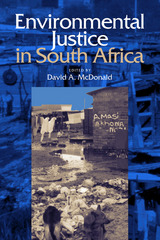 Environmental Justice in South Africa
David A. McDonald
Ohio University Press, 2002 Environmental Justice in South Africa provides a systematic overview of the first ten years of postapartheid environmental politics. Written by leading activists and academics in the field, this edited collection offers the first critical perspective of environmental justice theory and practice in South Africa. Accessible and wide-ranging in its coverage, the book offers a benchmark analysis of the environmental justice movement today as well as an assessment of where it may be headed in the future.
Beginning with a history of the environmental justice movement in the country, the book explores a range of conceptual and practical questions: How does environmental justice relate to issues of marginalization and poverty in South Africa? What are the links between environmental justice and other schools of environmental thought? Is the legal system an appropriate tool for addressing environmental equity? How do race, class, and gender intersect in the South African environmental context?
The second half of the book is a more concrete exploration of environmental (in)justice in the country. These chapters are interspersed with real-life stories of struggles by workers and communities for environmental change. The book is an invaluable resource for South African and international audiences interested in the growing, and increasingly global, environmental justice movement.
Environmental Justice: Issues, Policies, and Solutions
Edited by Bunyan Bryant
Island Press, 1995 In Environmental Justice, leading thinkers of the environmental justice movement take a direct look at the failure of "top down" public policy to effectively deal with issues of environmental equity. The book provides a startling look at pressing social and environmental problems and charts a course for future action. Among the topics considered are: the history of the social justice movement the role of the professional in working with community groups methods of dealing with environmental problems at the international level participatory national policy for environmental education, energy, industrial development, and housing and sustainable development. Contributors include Robert Bullard, Deeohn Ferris, Tom B.K. Goldtooth, David Hahn-Baker, Beverly Wright, Ivette Perfecto, Patrick West, and others.
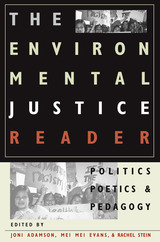 The Environmental Justice Reader: Politics, Poetics, and Pedagogy
Edited by Joni Adamson, Mei Mei Evans, and Rachel Stein
University of Arizona Press, 2002 From the First National People of Color Congress on Environmental Leadership to WTO street protests of the new millennium, environmental justice activists have challenged the mainstream movement by linking social inequalities to the uneven distribution of environmental dangers. Grassroots movements in poor communities and communities of color strive to protect neighborhoods and worksites from environmental degradation and struggle to gain equal access to the natural resources that sustain their cultures. This book examines environmental justice in its social, economic, political, and cultural dimensions in both local and global contexts, with special attention paid to intersections of race, gender, and class inequality. The first book to link political studies, literary analysis, and teaching strategies, it offers a multivocal approach that combines perspectives from organizations such as the Southwest Network for Environmental and Economic Justice and the International Indigenous Treaty Council with the insights of such notable scholars as Devon Peña, Giovanna Di Chiro, and Valerie Kuletz, and also includes a range of newer voices in the field. This collection approaches environmental justice concerns from diverse geographical, ethnic, and disciplinary perspectives, always viewing environmental issues as integral to problems of social inequality and oppression. It offers new case studies of native Alaskans' protests over radiation poisoning; Hispanos' struggles to protect their land and water rights; Pacific Islanders' resistance to nuclear weapons testing and nuclear waste storage; and the efforts of women employees of maquiladoras to obtain safer living and working environments along the U.S.-Mexican border. The selections also include cultural analyses of environmental justice arts, such as community art and greening projects in inner-city Baltimore, and literary analyses of writers such as Jimmy Santiago Baca, Linda Hogan, Barbara Neely, Nez Perce orators, Ken Saro-Wiwa, and Karen Yamashita—artists who address issues such as toxicity and cancer, lead poisoning of urban African American communities, and Native American struggles to remove dams and save salmon. The book closes with a section of essays that offer models to teachers hoping to incorporate these issues and texts into their classrooms. By combining this array of perspectives, this book makes the field of environmental justice more accessible to scholars, students, and concerned readers.
 Environmental Land Use Planning and Management
John Randolph
Island Press, 2003 Environmental Land Use Planning and Management is a unique new textbook that presents a diverse, comprehensive, and coordinated approach to issues of land use planning and management and their impacts on the environment. It builds on recent advances in environmental science, engineering, and geospatial information technologies to provide students with the scientific foundation they need to understand both natural land systems and engineering approaches that can mitigate impacts of land use practices. While offering a base of knowledge in planning theory and natural science, its primary emphasis is on describing and explaining emerging approaches, methods, and techniques for environmental land use planning, design, and policy. The book is divided into two parts. Part I, "Environmental Land Use Management," introduces broad concepts of environmental planning and describes management approaches. Those approaches include collaborative environmental management, land conservation, environmental design, government land use management, natural hazard mitigation, and ecosystem and watershed management. Part II, "Environmental Land Use Principles and Planning Analysis," focuses on land analysis methods, such as geospatial data and geographic information systems (GIS); soils and slope analysis; assessment of stormwater quantity and quality; land use and groundwater protection; ecological assessment for vegetation, wetlands, and habitats; and integrated analytical techniques like land suitability analysis, carrying capacity studies, and environmental impact assessment. Environmental Land Use Planning and Managementoffers a unique interdisciplinary perspective with an emphasis on application. It is an important new text for advanced undergraduate and graduate courses in environmental planning, landscape architecture, geography, environmental studies, and natural resource management, and a valuable resource for professionals and others concerned with issues of environmental planning and land use.
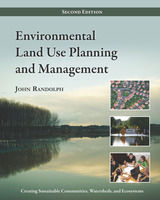 Environmental Land Use Planning and Management: Second Edition
John Randolph
Island Press, 2011 Environmental Land Use Planning and Management offers students, instructors, and professionals a comprehensive and practical foundation for building sustainable communities through integrated planning. Widely recognized as a leading resource in the field, this second edition strengthens its interdisciplinary approach with updated research, new case studies, and expanded content on pressing environmental challenges.
Organized into three parts, the book provides a clear roadmap for understanding and applying core principles. Part I introduces environmental planning and land use fundamentals, with an emphasis on collaboration and systems thinking. Part II explores tools and topics essential to sustainable land use, including soils and topography, hydrology, stormwater management, biodiversity, and climate change—with a new chapter connecting land use to energy, air quality, and greenhouse gas emissions. Part III offers guidance on managing watersheds, conserving ecosystems, and mitigating natural hazards to support long-term community resilience.
This edition has been thoughtfully revised based on instructor feedback, with reorganized content for improved clarity and usability. Informative sidebars highlight key federal and local policies, real-world problems, and solutions grounded in current practice.
Whether used in the classroom or the field, Environmental Land Use Planning and Management provides the foundation for making informed decisions that protect ecosystems, reduce risk, and support sustainable development.
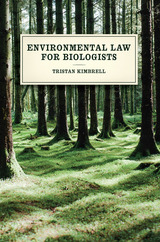 Environmental Law for Biologists
Tristan Kimbrell
University of Chicago Press, 2016 Environmental law has an unquestionable effect on the species, ecosystems, and landscapes that biologists study—and vice-versa, as the research of these biologists frequently informs policy. But because many scientists receive little or no legal training, we know relatively little about the precise ways that laws affect biological systems—and, consequently, about how best to improve these laws and better protect our natural resources.
With Environmental Law for Biologists, ecologist and lawyer Tristan Kimbrell bridges this gap in legal knowledge. Complete with a concise introduction to environmental law and an appendix describing the most important federal and international statutes and treaties discussed, the book is divided into four broad parts: laws that focus on individual species, like invasive species policies, the Endangered Species Act, and international treaties such as CITES; laws that focus on land, from federal public lands to agricultural regulations and urban planning; laws that focus on water, such as the Clean Water Act; and laws that focus on air, such as the Clean Air Act and international measures meant to mitigate global climate change. Written for working biologists and students alike, this book will be a catalyst for both more effective policy and enhanced research, offering hope for the manifold frictions between science and the law.
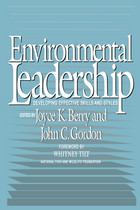 Environmental Leadership: Developing Effective Skills And Styles
Edited by John C. Gordon and Joyce K. Berry; Foreword by Whitney Tilt
Island Press, 1993 Stormwater management as art? Absolutely. Rain is a resource that should be valued and celebrated, not merely treated as an urban design problem— and yet, traditional stormwater treatment methods often range from ugly to forgettable. Artful Rainwater Design shows that it's possible to effectively manage runoff while also creating inviting, attractive landscapes.
This beautifully illustrated, comprehensive guide explains how to design creative, yet practical, landscapes that treat on-site stormwater management as an opportunity to enhance site design. Artful Rainwater Design has three main parts: first, the book outlines five amenity-focused goals that might be highlighted in a project: education, recreation, safety, public relations, and aesthetic appeal. Next, it focuses on techniques for ecologically sustainable stormwater management that complement the amenity goals. Finally, it features diverse case studies that show how designers around the country are implementing principles of artful rainwater design.
Artful Rainwater Design is a must-have resource for landscape architects, urban designers, civil engineers, and architects who won't let stormwater regulations cramp their style, and who understand that for a design to truly be sustainable, people must appreciate and love it. It is a tool for creating landscapes that celebrate rain for the life-giving resource it is— and contribute to more sustainable, healthy, and even fun, built environments.
The Environmental Legacy of War on the Hungarian-Ottoman Frontier, c. 1540-1690
András Vadas
Amsterdam University Press, 2023 This book is the first monographic attempt to follow the environmental changes that took place in the frontier zone of the Ottoman Empire and the Kingdom of Hungary in the sixteenth and seventeenth centuries. On the one hand, it looks at how the Ottoman–Hungarian wars affected the landscapes of the Carpathian Basin – specifically, the frontier zone. On the other hand, it examines how the environment was used in the military tactics of the opposing realms. By taking into consideration both perspectives, this book intends to pursue the dynamic interplay between war, environment, and local society in the early modern period.
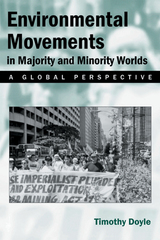 Environmental Movement in Majority and Minority Worlds: A Global Perspective
Doyle, Timothy
Rutgers University Press, 2004 Environmental movements are among the most vibrant, diverse, and powerful social movements occurring today, across all corners of the globe. They range dramatically from government lobbyists raising campaign funds to save the North American spotted owl; to “Green Warriors” engaging in guerrilla conflict in the mountains of the Philippines; to small landholders and indigenous peoples vowing to die by meeting the waters of the Narmada River in India as it rises due to its damming.
Drawing on his primary fieldwork in six countries, environmental researcher Timothy Doyle argues that there is, in fact, no one global environmental movement; rather, there are many, and the differences among them far outweigh their similarities. Movements in the third world—such as those in India and the Philippines —tend to be oriented around issues of human health, shelter, food security, and survival; while those of the developed world—for example, the United States, England, Germany, and Australia —can afford to focus on post-materialist issues such as wilderness concerns and animal rights. Doyle also demonstrates that the consequences of these campaigns are as wide-ranging as their motives and methods.
Taking a much-needed step beyond the wealth of nation-centered accounts of environmentalism, this book makes an important contribution to studies concerned with global environmental problems and politics.
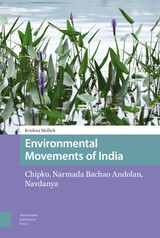 Environmental Movements of India: Chipko, Narmada Bachao Andolan, Navdanya
Krishna Mallick
Amsterdam University Press, 2021 In her detailed retelling of three iconic movements in India, Professor Emerita Krishna Mallick, PhD, gives hope to grassroots activists working toward environmental justice. Each movement deals with a different crisis and affected population: Chipko, famed for tree-hugging women in the Himalayan forest; Narmada, for villagers displaced by a massive dam; and Navdanya, for hundreds of thousands of farmers whose livelihoods were lost to a compact made by the Indian government and neoliberal purveyors of genetically modified organisms (GMOs). Relentlessly researched, Environmental Movements of India: Chipko, Narmada Bachao Andolan, Navdanya presents these movements in a framework that explores Hindu Vedic wisdom, as well as Development Ethics, Global Environment Ethics, Feminist Care Ethics, and the Capability Approach. At a moment when the climate threatens populations who live closest to nature – and depend upon its fodder for heat, its water for life, and its seeds for food – Mallick shows how nonviolent action can give poor people an effective voice.
Environmental Physiology of the Amphibians
Edited by Martin E. Feder and Warren W. Burggren
University of Chicago Press, 1992 Through its emphasis on recent research, its many summary tables, and its bibliography of more than 4,000 entries, this first modern, synthetic treatment of comparative amphibian environmental physiology emerges as the definitive reference for the field. Forty internationally respected experts review the primary data, examine current research trends, and identify productive avenues for future research.
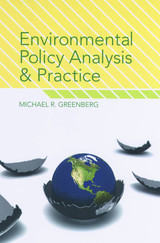 Environmental Policy Analysis and Practice
Greenberg, Michael R
Rutgers University Press, 2008 Pressing environmental challenges are frequently surrounded with stakeholders on all sides of the issues. Opinions expressed by government agencies, the private sector, special interests, nonprofit communities, and the media, among others can quickly cloud the dialogue, leaving one to wonder how policy decisions actually come about. In Environmental Policy Analysis and Practice, Michael R. Greenberg cuts through the complicated layers of bureaucracy, science, and the public interest to show how all policy considerations can be broken down according to six specific factors: 1) the reaction of elected government officials, 2) the reactions of the public and special interests, 3) knowledge developed by scientists and engineers, 4) economics, 5) ethical imperatives, and 6) time pressure to make a decision. The book is organized into two parts, with the first part defining and illustrating each one of these criteria. Greenberg draws on examples such as nuclear power, pesticides, brownfield redevelopment, gasoline additives, and environmental cancer, but focuses on how these subjects can be analyzed rather than exclusively on the issues themselves. Part two goes on to describe a set of over twenty tools that are used widely in policy analysis, including risk assessment, environmental impact analysis, public opinion surveys, cost-benefit analysis, and others. These tools are described and then illustrated with examples from part one. Weaving together an impressive combination of practical advice and engaging first person accounts from government officials, administrators, and leaders in the fields of public health and medicine, this clearly written volume is poised to become a leading text in environmental policy.
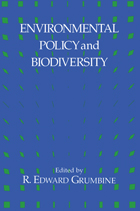 Environmental Policy and Biodiversity
Edited by R. Edward Grumbine
Island Press, 1994 Scientists and policymakers must work together if solutions to the biodiversity crisis are to be found. Yet all too often, scientific data are unknown or incomprehensible to policymakers, and political realities are not fully appreciated by scientists. Environmental Policy and Biodiversity addresses that problem by presenting both an overview of important concepts in the field of conservation biology and an examination of the strengths and limitations of the policymaking process. Topics covered include: - the ethical and scientific bases of conservation biology
- the effectiveness of existing environmental policy in protecting biodiversity
- case studies from California, the Great Lakes region, southern Appalachia, and the Florida panhandle
- an examination of overall environmental policy goals and processes
Featuring provocative and clearly argued essays from a range of disciplines, Environmental Policy and Biodiversity provides resource professionals with valuable insight into conservation issues, and can serve as a useful tool in both graduate and undergraduate courses in conservation biology and environmental policy.
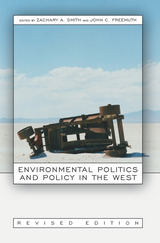 Environmental Politics and Policy in the West, Revised Edition
Zachary A. Smith
University Press of Colorado, 2007 Population growth and industrial development have put the wide-open spaces and natural resources that define the West under immense stress. Vested interests clash and come to terms over embattled resources such as water, minerals, and even open space. The federal government controls 40 to 80 percent of the land base in many western states; its sway over the futures of the West's communities and environment has prompted the development of unique policies and politics in the West.
Zachary A. Smith and John Freemuth bring together a roster of top scholars to explicate the issues noted above as well as other key questions in this new edition of Environmental Politics and Policy in the West, which was first published in 1993. This thoroughly revised and updated edition offers a comprehensive and current survey.
Contributors address the policy process as it affects western states, how bureaucracy and politics shape environmental dialogues in the West, how western states innovate environmental policies independently of Washington, and how and when science is involved (or ignored) in management of the West's federal lands. Experts in individual resource areas explore multifaceted issues such as the politics of dam removal and restoration, wildlife resource concerns, suburban sprawl and smart growth, the management of hard-rock mining, and the allocation of the West's tightly limited water resources. Contributors include: Leslie R. Alm, Carolyn D. Baber, Walter F. Baber, Robert V. Bartlett, Hugh Bartling, Matthew A. Cahn, R. McGreggor Cawley, Charles Davis, Sandra Davis, John C. Freemuth, Sheldon Kamieniecki, Matt Lindstrom, William R. Mangun, Denise McCain-Tharnstrom, Daniel McCool, Jaina L. Moan, and Zachary A. Smith.
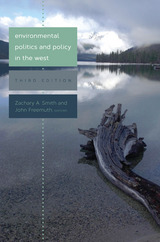 Environmental Politics and Policy in the West, Third Edition
Zachary A. Smith
University Press of Colorado, 2016 Population growth, industrial development, and renewed resource extraction have put the wide-open spaces and natural resources that define the West under immense stress. Vested interests clash and come to terms over embattled resources such as water, minerals, and even open space. The federal government controls 40 to 80 percent of the land base in many western states, so its sway over the future of the West’s communities and environments has prompted the development of unique policies and politics.
In the third edition of Environmental Politics and Policy in the West, Zachary A. Smith and John C. Freemuth bring together a roster of top scholars to explicate the key issues involved. The volume has been completely updated to cover rapidly changing developments in the West, including climate change, land management politics and policy, science controversies, western water and river restoration, tribal sovereignty issues, the management of endangered species, and renewable energy development. Contributors also address how bureaucracy and politics shape environmental dialogues and explore multifaceted issues such as the politics of dam removal and restoration, wildlife resource concerns, suburban sprawl and smart growth, the management of renewable resources, public land reform and science, tribal sovereignty and energy, and the allocation of the West’s tightly limited water resources.
This timely new edition offers a comprehensive and current survey of influential western policy and environmental issues. It will be of great use to students of environmental studies and also public and environmental policy, as well as activists and professionals working in the environmental arena.
Contributors: Leslie R. Alm, Carolyn D. Baber, Walter F. Baber, Robert V. Bartlett, Hugh Bartling, Matthew A. Cahn, R. McGreggor Cawley, Charles Davis, Sandra Davis, John C. Freemuth, Sheldon Kamieniecki, Matt Lindstrom, William R. Mangun, Denise McCain-Tharnstrom, Daniel McCool, Jaina L. Moan, Zachary A. Smith
 The Environmental Politics and Policy of Western Public Lands
Erika Allen Wolters
Oregon State University Press, 2020 The management of public lands in the West is a matter of long-standing and oft-contentious debates. The government must balance the interests of a variety of stakeholders, including extractive industries like oil and timber; farmers, ranchers, and fishers; Native Americans; tourists; and environmentalists. Local, state, and government policies and approaches change according to the vagaries of scientific knowledge, the American and global economies, and political administrations. Occasionally, debates over public land usage erupt into major incidents, as with the armed occupation of Malheur National Wildlife Refuge in 2016.
While a number of scholars work on the politics and policy of public land management, there has been no central book on the topic since the publication of Charles Davis's Western Public Lands and Environmental Politics (Westview, 2001). In The Environmental Politics and Policy of Western Public Lands, Erika Allen Wolters and Brent Steel have assembled a stellar cast of scholars to consider long-standing issues and topics such as endangered species, land use, and water management while addressing more recent challenges to western public lands like renewable energy siting, fracking, Native American sovereignty, and land use rebellions. Chapters also address the impact of climate change on policy dimensions and scope.
 Environmental Politics and Policy: Theories and Evidence
James P. Lester, ed.
Duke University Press, 1995 Completely revised throughout, and including five new chapters, this second edition of Environmental Politics and Policy provides an updated review and synthesis of the political science literature on the subject of environmental politics and policy. Various chapters by leading scholars in the field analyze and describe the role of public opinion, interest groups, political parties, Congress, the Executive Branch, the Courts, and elites as they have influenced the formation of U.S. environmental policies over the past twenty-five years. The book also provides ideas for future research and will stimulate thinking about the subject in the 1990s and beyond. From reviews of the First Edition:
"All the authors in this collection of essays are well known in the field of environmental policy. Their breadth of knowledge, and diversity of perspectives, permit a rich and comprehensive coverage of the scholarly work in this field."—Daniel McCool, Journal of Politics "An excellent collection of readings with a strong emphasis on institutional analysis as an approach to environmental policy in the United States."—Robert Paehlke, Natural Resources and Environmental Administration "No better review of the political science of environmental policy-making has yet been published."—Christopher J. Bailey, Environmental Politics Contributors. David Colnic, Douglas Costain, John S. Dryzek, Riley E. Dunlap, Helen M. Ingram, Sheldon Kamieniecki, Michael E. Kraft, James P. Lester, Dean E. Mann, Evan J. Ringquist, Walter A. Rosenbaum, Mark E. Rushefsky, Gerald B. Thomas, Lettie M. Wenner
 Environmental Politics and the Creation of a Dream: Establishing the Apostle Islands National Lakeshore
Harold C. Jordahl
University of Wisconsin Press, 2011 The Apostle Islands National Lakeshore is a breathtakingly beautiful archipelago of twenty-two islands in Lake Superior, just off the tip of northern Wisconsin. For years, the national park has been a favorite destination for tourists and locals alike, but the remarkable story behind its creation is little known. In Environmental Politics and the Creation of a Dream, Harold Jordahl, one of the primary advocates for designating the islands as a national park, discloses the full story behind the effort to preserve their natural beauty for posterity. He describes in detail the political and bureaucratic complexities of the national lakeshore campaign, augmented by his own personal recollections and those of such prominent figures as Wisconsin Senator Gaylord Nelson and President John F. Kennedy. Writing in collaboration with Annie Booth, Jordahl recounts how activists, legislators, media, local residents, and other players shaped the islands’ future establishment as a national park.
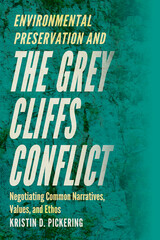 Environmental Preservation and the Grey Cliffs Conflict: Negotiating Common Narratives, Values, and Ethos
Kristin D. Pickering
Utah State University Press, 2024 Based on a qualitative, ethnographic, observational case study approach, Environmental Preservation and the Grey Cliffs Conflictpresents an analysis of the conflict negotiation between the U.S. Army Corps of Engineers and a local community that struggled to address a deteriorating Corps-managed recreational lake area in Tennessee known as “Grey Cliffs.” Viewing the dispute from the perspective of a new member of the community and a specialist in technical communication and professional writing, Kristin Pickering provides a unique perspective on this communication process.
Though environmental degradation and unauthorized use threatened the Grey Cliffs recreational lake area to the point that the Corps considered closure, community members valued it highly and wanted to keep it open. The community near this damaged and crime-ridden area needed help rejuvenating its landscape and image, but the Corps and community were sharply divided on how to maintain this beloved geographic space because of the stakeholders’ different cultural backgrounds and values, as well as the narratives used to discuss them. By co-constructing and aligning narratives, values, and ethos over time—a difficult and lengthy process—the Corps and community succeeded, and Grey Cliffs remains open to all. Focusing on field notes, participant interviews, and analysis of various texts created throughout the conflict, Pickering applies rhetorical analysis and a grounded theory approach to regulation, identity, sustainability, and community values to analyze this communication process.
Illustrating the positive change that can occur when governmental organizations and rural communities work together to construct shared values and engage in a rhetoric of relationship that preserves the environment, Environmental Preservation and the Grey Cliffs Conflict provides key recommendations for resolving environmental conflicts within local communities, especially for those working in technical and professional communication, organizational communication, environmental science, and public policy.
Environmental Program Evaluation: A Primer
Edited by Gerrit Knaap and Tschango John Kim: Foreword by Ravinder K. Jain
University of Illinois Press, 1998 This pioneer work in a complex, interdisciplinary, and still-developing field explores the prospects for a more comprehensive approach to evaluating environmental programs. Experts in the fields of biology, chemistry, ecology, economics, management, planning, sociology, political science, and public administration provide coherent, integrated perspectives on the task of environmental program evaluation. The essays are organized thematically, covering institutional, scientific, economic, and administrative topics. The volume will be a valuable text for practitioners, regulators, policymakers, and scholars in the fields of program evaluation, environmental policy, and environmental science.
 Environmental Regulations and Housing Costs
Arthur C. Nelson, John Randolph, Joseph M. Schilling, Jonathan Logan, James M. McElfish, Jr., and Newport Partners LLC
Island Press, 2009 Many communities across the nation still lack affordable housing. And many officials continue to claim that “affordable housing” is an oxymoron. Building inexpensively is impossible, they say, because there are too many regulations. Required environmental impact statements and habitat protection laws, they contend, drive up the costs of construction. But is this actually true? In a comprehensive study of the question, the authors of this eye-opening book separate fact from myth. With admirable clarity, they describe the policy debate from its beginning, review the economic theory, trace the evolution of development regulation, and summarize the major research on the topic. In addition, they offer their own research, accompanied by a case study of two strikingly different Washington, D.C., suburbs. They also include results of focus groups conducted in Dallas, Denver, and Tucson. The authors find that environmental regulatory costs—as a share of total costs and processes—are about the same now as they were thirty years ago, even though there are far more regulations today. They find, too, that environmental regulations may actually create benefits that could improve the value of housing. Although they conclude that regulations do not appear to drive up housing costs more now than in the past, they do offer recommendations of ways in which the processes associated with regulations—including review procedures—could be improved and could result in cost savings. Intended primarily for professionals who are involved in, or impacted by, regulations—from public officials, planners, and engineers to housing developers and community activists—this book will provide useful insights and data to anyone who wants to know if (and how) American housing can actually be made “affordable.”
Environmental Restoration: Science And Strategies For Restoring The Earth
Edited by John Berger
Island Press, 1990 Environmental Restoration is the product of a ground-breaking conference on ecological restoration, held in January 1988 at the University of California, Berkeley. It offers an overview from the nation's leading experts of the most current techniques of restoration, including examples of the complex and subtle biological interactions we must understand to ensure success. Chapters cover restoration of agricultural lands, barrens, coastal ecosystems, prairies, and range lands. Additional sections address temperate forests and watersheds, mined lands, soil bioengineering, urban issues including waste treatment and solid, toxic, and radioactive waste management. The book also covers restoration of aquatic systems, includes chapters on strategic planning and land acquisition, and provides examples of successful projects.
 Environmental Safety of Genetically Engineered Crops
Rebecca Grumet
Michigan State University Press, 2010 Since the mid-1990s, when the technology was first introduced, the cultivation of genetically engineered (GE) crops has grown exponentially. In the U.S. alone, adoption rates for transgenic cotton, corn, and soybeans are between 70–90%. Across the globe, 14 million farmers grow GE crops in more than twenty countries. Yet many countries are discussing and debating the use and adoption of GE technology because of concerns about their impact on the environment and human health. Now, in this comprehensive handbook, a team of international experts present the scientific basis for GE crops, placing them in the context of current agricultural systems, and examining the potential environmental risks posed by their deployment. An integrated approach to an increasingly hot and globally debated topic, the book considers the past, present, and future of GE crops, and offers an invaluable perspective for regulation and policy development.
 Environmental Security
Simon Dalby
University of Minnesota Press, 2002 A critical look at the relationship between environmental degradation and international relations. Since the end of the Cold War, environmental matters-especially the international implications of environmental degradation-have figured prominently in debates about rethinking security. But do the assumptions underlying such discussions hold up under close scrutiny? In this first treatment of environmental security from a truly critical perspective, Simon Dalby shows how attempts to explain contemporary insecurity falter over unexamined notions of both environment and security. Adding environmental history, aboriginal perspectives, and geopolitics to the analysis explicitly suggests that the growing disruptions caused by a carbon-fueled and expanding modernity are at the root of contemporary difficulties. Environmental Security argues that rethinking security means revisiting questions of how we conceive identities as endangered and how we perceive threats to these identities. The book clearly demonstrates that the conceptual basis for critical security studies requires an extended engagement with political theory and with the assumptions of the modern subject as progressive political agent. Viewed thus on a global scale, the environmental security discourse raises profoundly troubling political questions as to who we are and what kind of world we are collectively making in our efforts to be secure.
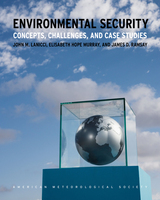 Environmental Security: Concepts, Challenges, and Case Studies
Edited by John M. Lanicci, Elisabeth Hope Murray, and James D. Ramsay
American Meteorological Society, 2019 Security threats today are increasingly complex, dynamic, and asymmetric, and can affect environmental factors like energy, water, and food supply. As a result, it is becoming evident that the traditional model of nation-state based security is incomplete, and that purely military capabilities, though necessary, are insufficient to protect the United States and other democracies from the array of threats that challenge liberty and the free flow of people and commerce. A more complete picture of modern national security requires a more complete integration of the question of environmental security.
The purpose of text is to better address the many aspects of environmental security and to represent this major area of academic research in an introductory text format that can be used in the rapidly growing number of homeland security studies programs as well as related degree programs. The concepts, challenges, and case studies in this text vitally extended such curricula, giving students a deeper appreciation for the critical role environmental security plays in overall state security, as well as for our nation, our way of life, and indeed for the human race at large.
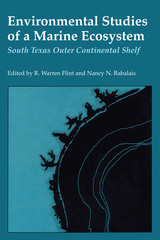 Environmental Studies of a Marine Ecosystem: South Texas Outer Continental Shelf
Edited by R. Warren Flint and Nancy N. Rabalais
University of Texas Press, 1981 Environmental Studies of a Marine Ecosystem reports the temporal and spatial variation of both the living and nonliving resources of the south Texas outer continental shelf. As the last major study to have been conducted before the Ixtoc oil spill in 1979, it is of great importance as a record of the baseline conditions and ecosystem characteristics for both biologists and chemists studying the effects of the Campeche disaster on the marine environment. The book is the culmination of three years of field studies conducted for the Bureau of Land Management and contains information on the climatology, hydrology, and sedimentology of the region as well as data on the pelagic and benthic biota, environmental hydrocarbons and trace metals, and the microbiology of the area. In addition to the ecosystem description, the data are integrated to expose ecological relationships that exist and to identify those specific variables which are most important for the assessment and management of environmentally damaging impacts to the area.
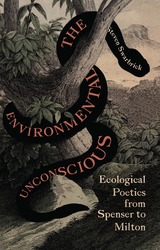 The Environmental Unconscious: Ecological Poetics from Spenser to Milton
Steven Swarbrick
University of Minnesota Press, 2023 Bringing psychoanalysis to bear on the diagnosis of ecological crisis
Why has psychoanalysis long been kept at the margins of environmental criticism despite the many theories of eco-Marxism, queer ecology, and eco-deconstruction available today? What is unique, possibly even traumatic, about eco-psychoanalysis? The Environmental Unconscious addresses these questions as it provides an innovative and theoretical account of environmental loss focused on the counterintuitive forms of enjoyment that early modern poetry and psychoanalysis jointly theorize. Steven Swarbrick urges literary critics and environmental scholars fluent in the new materialism to rethink notions of entanglement, animacy, and consciousness raising. He introduces concepts from psychoanalysis as keys to understanding the force of early modern ecopoetics. Through close readings of Edmund Spenser, Walter Ralegh, Andrew Marvell, and John Milton, he reveals a world of matter that is not merely hyperconnected, as in the new materialism, but porous and off-kilter. And yet the loss these poets reveal is central to the enjoyment their works offer—and that nature offers. As insightful as it is engaging, The Environmental Unconscious offers a provocative challenge to ecocriticism that, under the current regime of fossil capitalism in which everything solid interconnects, a new theory of disconnection is desperately needed. Tracing the propulsive force of the environmental unconscious from the early modern period to Freudian and post-Freudian theories of desire, Swarbrick not only puts nature on the couch in this book but also renews the psychoanalytic toolkit in light of environmental collapse.
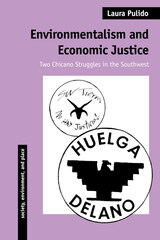 Environmentalism and Economic Justice: Two Chicano Struggles in the Southwest
Laura Pulido
University of Arizona Press, 1996 Ecological causes are championed not only by lobbyists or hikers. While mainstream environmentalism is usually characterized by well-financed, highly structured organizations operating on a national scale, campaigns for environmental justice are often fought by poor or minority communities. Environmentalism and Economic Justice is one of the first books devoted to Chicano environmental issues and is a study of U.S. environmentalism in transition as seen through the contributions of people of color. It elucidates the various forces driving and shaping two important examples of environmental organizing: the 1965-71 pesticide campaign of the United Farm Workers and a grazing conflict between a Hispano cooperative and mainstream environmentalists in northern New Mexico. The UFW example is one of workers highly marginalized by racism, whose struggle--as much for identity as for a union contract--resulted in boycotts of produce at the national level. The case of the grazing cooperative Ganados del Valle, which sought access to land set aside for elk hunting, represents a subaltern group fighting the elitism of natural resource policy in an effort to pursue a pastoral lifestyle. In both instances Pulido details the ways in which racism and economic subordination create subaltern communities, and shows how these groups use available resources to mobilize and improve their social, economic, and environmental conditions. Environmentalism and Economic Justice reveals that the environmental struggles of Chicano communities do not fit the mold of mainstream environmentalism, as they combine economic, identity, and quality-of-life issues. Examination of the forces that create and shape these grassroots movements clearly demonstrates that environmentalism needs to be sensitive to local issues, economically empowering, and respectful of ethnic and cultural diversity.
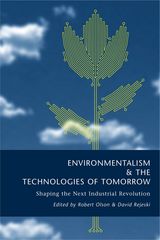 Environmentalism and the Technologies of Tomorrow: Shaping The Next Industrial Revolution
Edited by Robert Olson and David Rejeski
Island Press, 2005 We sit at the doorstep of multiple revolutions in robotic, genetic, information, and communication technologies, whose powerful interactions promise social and environmental transformations we are only beginning to understand. How can we anticipate their impacts and ensure that these new technologies help move us in a more sustainable direction? Environmentalism and the Technologies of Tomorrow is a collection of essays by leading scientists, technologists, and thinkers that examine the nature of current technological changes, their environmental implications, and possible strategies for the transition to a sustainable future. It offers a baseline understanding of new technological developments, as well as important insights for moving beyond business-as-usual by developing more anticipatory approaches to environmental protection and more comprehensive strategies for promoting the transformation of technology. Among the contributors are Brad Allenby, David Bell, Steward Brand, Michael Braungart, Lester Brown, Joanne Ciulla, Denis Hayes, Hazel Henderson, Amory Lovins, William McDonough, Gary Marchant, David Ronfeldt, John Seely-Brown, Gus Speth, and Timothy Sturgeon.
 Environmentalism in Landscape Architecture
Michel Conan
Harvard University Press, 2000 More than forty years after the first signs of a new era in environmental thinking, landscape architects and the public at large continue to engage in ethical, practical, and metaphysical debates on what environmentalism really is and what it should be. This exchange of ideas has been characterized more by passion than by clarity, with definitive and persuasive answers hard to come by.
The papers presented in this volume range from proposals for new design approaches, historical analysis of the relationship between the practice of landscape architecture and environmentalism, to the theories of early practitioners of landscape architecture imbued by an environmentalist outlook.
The issues above are addressed through topics as eclectic as the design of American zoos, the establishment of the Tennessee Valley Authority, road design and maintenance in Texas, and criticism of relationships between the words and works of select landscape architects. This volume provides a fresh approach to encounters between environmentalism and landscape architecture by reframing the issues through self-reflection instead of strategic debate.
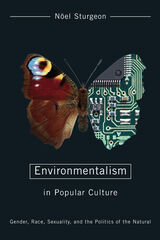 Environmentalism in Popular Culture: Gender, Race, Sexuality, and the Politics of the Natural
Noël Sturgeon
University of Arizona Press, 2009 In this thoughtful and highly readable book, Noël Sturgeon illustrates the myriad and insidious ways in which American popular culture depicts social inequities as “natural” and how our images of “nature” interfere with creating solutions to environmental problems that are just and fair for all. Why is it, she wonders, that environmentalist messages in popular culture so often “naturalize” themes of heroic male violence, suburban nuclear family structures, and U.S. dominance in the world? And what do these patterns of thought mean for how we envision environmental solutions, like “green” businesses, recycling programs, and the protection of threatened species?
Although there are other books that examine questions of culture and environment, this is the first book to employ a global feminist environmental justice analysis to focus on how racial inequality, gendered patterns of work, and heteronormative ideas about the family relate to environmental questions. Beginning in the late 1980s and moving to the present day, Sturgeon unpacks a variety of cultural tropes, including ideas about Mother Nature, the purity of the natural, and the allegedly close relationships of indigenous people with the natural world. She investigates the persistence of the “myth of the frontier” and its extension to the frontier of space exploration. She ponders the popularity (and occasional controversy) of penguins (and penguin family values) and questions assumptions about human warfare as “natural.”
The book is intended to provoke debates—among college students and graduate students, among their professors, among environmental activists, and among all citizens who are concerned with issues of environmental quality and social equality.
 Environmentality: Technologies of Government and the Making of Subjects
Arun Agrawal
Duke University Press, 2005 In Kumaon in northern India, villagers set hundreds of forest fires in the early 1920s, protesting the colonial British state’s regulations to protect the environment. Yet by the 1990s, they had begun to conserve their forests carefully. In his innovative historical and political study, Arun Agrawal analyzes this striking transformation. He describes and explains the emergence of environmental identities and changes in state-locality relations and shows how the two are related. In so doing, he demonstrates that scholarship on common property, political ecology, and feminist environmentalism can be combined—in an approach he calls environmentality—to better understand changes in conservation efforts. Such an understanding is relevant far beyond Kumaon: local populations in more than fifty countries are engaged in similar efforts to protect their environmental resources. Agrawal brings environment and development studies, new institutional economics, and Foucauldian theories of power and subjectivity to bear on his ethnographical and historical research. He visited nearly forty villages in Kumaon, where he assessed the state of village forests, interviewed hundreds of Kumaonis, and examined local records. Drawing on his extensive fieldwork and archival research, he shows how decentralization strategies change relations between states and localities, community decision makers and common residents, and individuals and the environment. In exploring these changes and their significance, Agrawal establishes that theories of environmental politics are enriched by attention to the interconnections between power, knowledge, institutions, and subjectivities.
 Environmentally Devastated Neighborhoods: Perceptions, Policies, and Realities
Greenberg, Michael
Rutgers University Press, 1996 Only 3% of all Americans believe they live in bad neighborhoods. But 30% to 45% of those who live in places with crime and illegal drug sales, rats and stray dogs, hazardous waste sites, factory pollution, and abandoned and blighted buildings rate their neighborhood as poor quality. Even when these neighborhoods have good schools, parks, and other amenities, their resident's ratings do not go up. This holds true no matter who is asked - young, old, men or women, middle class, working class, or on welfare. Local health and planning officials corroborate resident perceptions. It is particularly noticeable that stress from living near a toxic waste site - the hazard that gets the biggest attention in terms of dollars spent - is low on the resident's list of fears about their neighborhoods. They'd much prefer to see the money put to fixing the immediate dangers on their block. But because federal and state government policies for protecting public health, lowering crime, and saving the environment are divided into separate bureaucratic cubby-holes, effective planning to improve these stressed neighborhoods is difficult. Beginning with the call for a definition of "environment" that fits the realities of these places, the authors argue for and propose policy initiatives that address all the desperate needs of these beleaguered neighborhoods. This book is essential reading for students, academics, and professionals in environmental studies, public health, urban studies and planning, as well as grassroots community organizers.
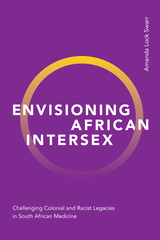 Envisioning African Intersex: Challenging Colonial and Racist Legacies in South African Medicine
Amanda Lock Swarr
Duke University Press, 2023 Since the 1600s, travelers, scientists, and doctors have claimed that “hermaphroditism” and intersex are disproportionately common among black South Africans. In Envisioning African Intersex Amanda Lock Swarr debunks this claim by interrogating contemporary intersex medicine and demonstrating its indivisibility from colonial ideologies and scientific racism. Tracing the history of racialized research that underpins medical and scientific premises of gendered bodies, Swarr analyzes decolonial actions by intersex South Africans from the 1990s to the present, centering the work of organizers such as Sally Gross, the first openly intersex activist in Africa and a global pioneer of intersex legislation. Swarr also explores African social media activism that advocates for intersex justice and challenges the mistreatment of South African Olympian Caster Semenya. Throughout, Swarr shows how activists displace doctors’ impositions to fashion self-representation. By unseating colonial visions of gender, intersex South Africans are actively disrupting medical violence, decolonizing gender binaries, and inciting policy changes.
All author royalties from Envisioning African Intersex will be donated to Intersex South Africa.
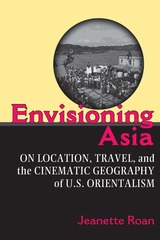 Envisioning Asia: On Location, Travel, and the Cinematic Geography of U.S. Orientalism
Jeanette Roan
University of Michigan Press, 2010 "Whereas some other scholars read selected films mainly to illustrate political arguments, Roan never loses sight of the particularities of film as a distinctive cultural form and practice. Her drive to see 'cinema as a mechanism of American orientalism' results in not just a textual analysis of these films, but also a history of their material production and distribution."
---Josephine Lee, University of Minnesota "Envisioning Asia offers an exciting new contribution to our understandings of the historical developments of American Orientalism. Jeannette Roan deftly situates changing cinematic technologies within the context of U.S. imperial agendas in this richly nuanced analysis of 'shooting on location' in Asia in early 20th century American cinema."
---Wendy Kozol, Oberlin College "Through her vivid illustration of the role of American cinema in the material, visual, and ideological production of Asia, Jeanette Roan takes the reader on a journey to Asia through a very different route from the virtual travel taken by the viewers of the films she discusses."
---Mari Yoshihara, University of Hawai'i at Manoa The birth of cinema coincides with the beginnings of U.S. expansion overseas, and the classic Hollywood era coincides with the rise of the United States as a global superpower. In Envisioning Asia, Jeanette Roan argues that throughout this period, the cinema's function as a form of virtual travel, coupled with its purported "authenticity," served to advance America's shifting interests in Asia. Its ability to fulfill this imperial role depended, however, not only on the cinematic representations themselves but on the marketing of the films' production histories---and, in particular, their use of Asian locations. Roan demonstrates this point in relation to a wide range of productions, offering an engaging and useful survey of a largely neglected body of film. Not only that, by focusing on the material practices involved in shooting films on location---that is, the actual travels, negotiations, and labor of making a film---she moves beyond formal analysis to produce a richly detailed history of American interests, attitudes, and cultural practices during the first half of the twentieth century. Jeanette Roan is Adjunct Professor of Visual Studies at California College of the Arts and author of "Exotic Explorations: Travels to Asia and the Pacific in Early Cinema" in Re/collecting Early Asian America: Essays in Cultural History (2002). Cover art: Publicity still, Tokyo File 212 (Dorrell McGowan and Stuart McGowan, 1951). The accompanying text reads: "Hundreds of spectators gather on the sidelines as technicians prepare to photograph a parade scene in 'Tokyo File 212,' a Breakston-McGowan Production filmed in Japan for RKO Radio distribution." Courtesy of the Academy of Motion Picture Arts and Sciences.
 Envisioning Brazil: A Guide to Brazilian Studies in the United States
Edited by Marshall C. Eakin and Paulo Roberto de Almeida
University of Wisconsin Press, 2005 Envisioning Brazil is a comprehensive and sweeping assessment of Brazilian studies in the United States. Focusing on synthesis and interpretation and assessing trends and perspectives, this reference work provides an overview of the writings on Brazil by United States scholars since 1945.
"The Development of Brazilian Studies in the United States," provides an overview of Brazilian Studies in North American universities. "Perspectives from the Disciplines" surveys the various academic disciplines that cultivate Brazilian studies: Portuguese language studies, Brazilian literature, art, music, history, anthropology, Amazonian ethnology, economics, politics, and sociology. "Counterpoints: Brazilian Studies in Britain and France" places the contributions of U.S. scholars in an international perspective. "Bibliographic and Reference Sources" offers a chronology of key publications, an essay on the impact of the digital age on Brazilian sources, and a selective bibliography.
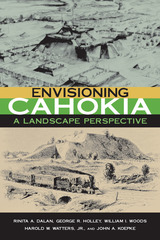 Envisioning Cahokia: A Landscape Perspective
Rinita A. Dalan, George R. Holley, William I. Woods, Harold W. Watters, Jr., and John A. Koepke
Northern Illinois University Press, 2003
The massive earthen mounds of ancient Cahokia in southwestern Illinois form the largest and most complex archaeological site in the United States. Here, at the center of a vibrant Native American culture, a settlement of Mississippian Indians grew, prospered, and declined. Tracing perceptions of the Cahokian landscape from the times of Indians and explorers to the present, Envisioning Cahokia details the archaeology of North America's largest prehistoric urban center.
Illustrated with a variety of images, this unique book provides new insights into Cahokian lifeways, land use, and culture through a landscape approach that explores the interrelationship of environment and society. Using the latest data from remote sensing and archaeological field studies, the authors examine such structures as the immense Grand Plaza and the impressive mounds used for both community ceremonies and burials. These mounds and other features of Cahokia form a political and social map, revealing a rich and elaborate culture. The authors show how settlement and ceremonial patterns defined power structures and belief systems, and suggest ways Cahokians may have perceived their place in the physical and spiritual worlds.
Tracing the history of the Cahokians and their landscape, Envisioning Cahokia leads readers to a new awareness of a culture that will forever inspire wonder and respect.
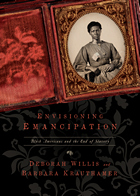 Envisioning Emancipation: Black Americans and the End of Slavery
Deborah Willis
Temple University Press, 2017 The Emancipation Proclamation is one of the most important documents in American history. As we commemorate its 150th anniversary, what do we really know about those who experienced slavery? In their pioneering book, Envisioning Emancipation, renowned photographic historian Deborah Willis and historian of slavery Barbara Krauthamer have amassed 150 photographs—some never before published—from the antebellum days of the 1850s through the New Deal era of the 1930s. The authors vividly display the seismic impact of emancipation on African Americans born before and after the Proclamation, providing a perspective on freedom and slavery and a way to understand the photos as documents of engagement, action, struggle, and aspiration. Envisioning Emancipation illustrates what freedom looked like for black Americans in the Civil War era. From photos of the enslaved on plantations and African American soldiers and camp workers in the Union Army to Juneteenth celebrations, slave reunions, and portraits of black families and workers in the American South, the images in this book challenge perceptions of slavery. They show not only what the subjects emphasized about themselves but also the ways Americans of all colors and genders opposed slavery and marked its end. Filled with powerful images of lives too often ignored or erased from historical records, Envisioning Emancipation provides a new perspective on American culture.
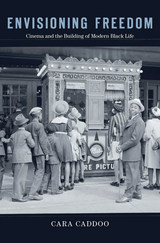 Envisioning Freedom: Cinema and the Building of Modern Black Life
Cara Caddoo
Harvard University Press, 2014 Viewing turn-of-the-century African American history through the lens of cinema, Envisioning Freedom examines the forgotten history of early black film exhibition during the era of mass migration and Jim Crow. By embracing the new medium of moving pictures at the turn of the twentieth century, black Americans forged a collective—if fraught—culture of freedom.
In Cara Caddoo’s perspective-changing study, African Americans emerge as pioneers of cinema from the 1890s to the 1920s. Across the South and Midwest, moving pictures presented in churches, lodges, and schools raised money and created shared social experiences for black urban communities. As migrants moved northward, bound for Chicago and New York, cinema moved with them. Along these routes, ministers and reformers, preaching messages of racial uplift, used moving pictures as an enticement to attract followers.
But as it gained popularity, black cinema also became controversial. Facing a losing competition with movie houses, once-supportive ministers denounced the evils of the “colored theater.” Onscreen images sparked arguments over black identity and the meaning of freedom. In 1910, when boxing champion Jack Johnson became the world’s first black movie star, representation in film vaulted to the center of black concerns about racial progress. Black leaders demanded self-representation and an end to cinematic mischaracterizations which, they charged, violated the civil rights of African Americans. In 1915, these ideas both led to the creation of an industry that produced “race films” by and for black audiences and sparked the first mass black protest movement of the twentieth century.
 Envisioning Global LGBT Human Rights: (Neo)colonialism, Neoliberalism, Resistance and Hope
Edited by Nancy Nicol, Adrian Jjuuko, Richard Lusimbo, Nick Mulé, Susan Ursel, Amar Wahab, and Phyllis Waugh
University of London Press, 2018 Customers based in the US and Canada, please order from: https://www.sas.ac.uk/envisionthisAmerica Envisioning Global LGBT Human Rights: (Neo)colonialism, Neoliberalism, Resistance and Hope is an outcome of a five-year international collaboration among partners that share a common legacy of British colonial laws that criminalise same-sex intimacy and gender identity/expression. The project sought to facilitate learning from each other and to create outcomes that would advance knowledge and social justice. The project was unique, combining research and writing with participatory documentary filmmaking. This visionary politics infuses the pages of the anthology. The chapters are bursting with invaluable first hand insights from leading activists at the forefront of some of the most fiercely fought battlegrounds of contemporary sexual politics in India, the Caribbean and Africa. As well, authors from Canada, Botswana and Kenya examine key turning points in the advancement of SOGI issues at the United Nations, and provide critical insights on LGBT asylum in Canada. Authors also speak to a need to reorient and decolonise queer studies, and turn a critical gaze northwards from the Global South. It is a book for activists and academics in a range of disciplines from postcolonial and sexualities studies to filmmaking, as well as for policy-makers and practitioners committed to envisioning, and working for, a better future. Customers in the USA and Canada can purchase the book from here: https://bit.ly/2KBk0V2
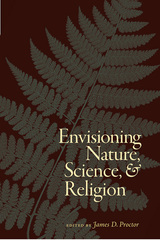 Envisioning Nature, Science, and Religion
Jim Proctor
Templeton Press, 2009 Contemporary scholarship has given rise to several modes of understanding biophysical and human nature, each entangled with related notions of science and religion. Envisioning Nature, Science, and Religion represents the culmination of three years of collaboration by an international group of fourteen natural scientists, social scientists, humanists, and theologians. The result is an intellectually stimulating volume that explores how the ideas of nature pertain to science and religion. Editor James D. Proctor has gathered sixteen in-depth essays, each examining and comparing five central metaphors or "visions" of biophysical and human nature. These visions are evolutionary nature, emergent nature, malleable nature, nature as sacred, and nature as culture. The book's diverse contributors offer a wide variety of unique perspectives on these five visions, spanning the intellectual spectrum and proposing important and often startling implications for religion and science alike. Throughout the essays, the authors do a great deal of cross-referencing and engaging each other's ideas, creating a cohesive dialogue on the visions of nature.
Envisioning Nature, Science, and Religion offers a blend of scholarly rigor and readable prose that will be appreciated by anyone engaged in the fields of religion, philosophy, and the natural sciences.
 Envisioning New Jersey: An Illustrated History of the Garden State
Lurie, Maxine N
Rutgers University Press, 2016 Winner of the 2018 Award of Merit and the 2018 Leadership in History Award from the American Association for State and Local History
Winner of the 2017 New Jersey Studies Academic Alliance Author Award
See New Jersey history as you read about it! Envisioning New Jersey brings together 650 spectacular images that illuminate the course of the state’s history, from prehistoric times to the present. Readers may think they know New Jersey’s history—the state’s increasing diversity, industrialization, and suburbanization—but the visual record presented here dramatically deepens and enriches that knowledge. Maxine N. Lurie and Richard F. Veit, two leading authorities on New Jersey history, present a smorgasbord of informative pictures, ranging from paintings and photographs to documents and maps. Portraits of George Washington and Molly Pitcher from the Revolution, battle flags from the War of 1812 and the Civil War, women air raid wardens patrolling the streets of Newark during World War II, the Vietnam War Memorial—all show New Jerseyans fighting for liberty. There are also pictures of Thomas Mundy Peterson, the first African American to vote after passage of the Fifteenth Amendment; Paul Robeson marching for civil rights; university students protesting in the 1960s; and Martin Luther King speaking at Monmouth University. The authors highlight the ethnic and religious variety of New Jersey inhabitants with images that range from Native American arrowheads and fishing implements, to Dutch and German buildings, early African American churches and leaders, and modern Catholic and Hindu houses of worship. Here, too, are the great New Jersey innovators from Thomas Edison to the Bell Labs scientists who worked on transistors. Compiled by the authors of New Jersey: A History of the Garden State, this volume is intended as an illustrated companion to that earlier volume. Envisioning New Jersey also stands on its own because essays synthesizing each era accompany the illustrations. A fascinating gold mine of images from the state’s past, Envisioning New Jersey is the first illustrated book on the Garden State that covers its complete history, capturing the amazing transformation of New Jersey over time. View sample pages (http://issuu.com/rutgersuniversitypress/docs/lurie_veit_envisioning_sample) Thanks to the New Jersey Historical Commission, the New Jersey Council for the Humanities, and generous individual donors for making this project possible.
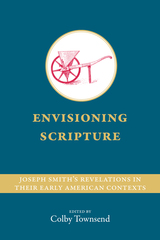 Envisioning Scripture: Joseph Smith’s Revelations in Their Early American Contexts
Colby Townsend
Signature Books, 2022 The first fifty years of United States history was a period of seemingly endless possibility. With the birth of a new country during the age of revolutions came new religions, new literary genres, new political parties, temperance and abolitionist societies, and the expansion of print and marketing networks that would dramatically change the course of the century. Envisioning Scripture: Joseph Smith’s Revelations in Their Early American Contexts brings together ten essays from leading scholars on the history of early American religion and print culture. Covering issues of gender, race, prophecy, education, scripture, real and narrative time, authority and power, and apocalypticism, the essays invite the reader—scholar, student, etc.—to expand their knowledge of early Mormon history by grasping more fully the American contexts that Mormonism grew out of.
Contributors include Catherine A. Brekus, William Davis, Elizabeth Fenton, Kathleen Flake, Paul Gutjahr, Jared Hickman, Susan Juster, Seth Perry, Laura Thiemann Scales, and Roberto A. Valdeón.
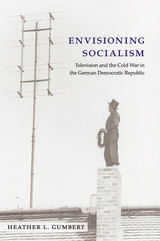 Envisioning Socialism: Television and the Cold War in the German Democratic Republic
Heather L. Gumbert
University of Michigan Press, 2014 Envisioning Socialism examines television and the power it exercised to define the East Germans’ view of socialism during the first decades of the German Democratic Republic. In the first book in English to examine this topic, Heather L. Gumbert traces how television became a medium prized for its communicative and entertainment value. She explores the difficulties GDR authorities had defining and executing a clear vision of the society they hoped to establish, and she explains how television helped to stabilize GDR society in a way that ultimately worked against the utopian vision the authorities thought they were cultivating. Gumbert challenges those who would dismiss East German television as a tool of repression that couldn’t compete with the West or capture the imagination of East Germans. Instead, she shows how, by the early 1960s, television was a model of the kind of socialist realist art that could appeal to authorities and audiences. Ultimately, this socialist vision was overcome by the challenges that the international market in media products and technologies posed to nation-building in the postwar period. A history of ideas and perceptions examining both real and mediated historical conditions, Envisioning Socialism considers television as a technology, an institution, and a medium of social relations and cultural knowledge. The book will be welcomed in undergraduate and graduate courses in German and media history, the history of postwar Socialism, and the history of science and technologies.
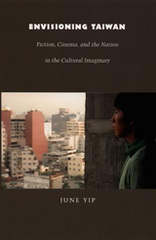 Envisioning Taiwan: Fiction, Cinema, and the Nation in the Cultural Imaginary
June Yip
Duke University Press, 2004 In discussions of postcolonial nationhood and cultural identity, Taiwan is often overlooked. Yet the island—with its complex history of colonization—presents a particularly fascinating case of the struggle to define a “nation.” While the mainland Chinese government has been unequivocal in its resistance to Taiwanese independence, in Taiwan, government control has gradually passed from mainland Chinese immigrants to the Taiwanese themselves. Two decades of democratization and the arrival of consumer culture have made the island a truly global space. Envisioning Taiwan sorts through these complexities, skillfully weaving together history and cultural analysis to give a picture of Taiwanese identity and a lesson on the usefulness and the limits of contemporary cultural theory. Yip traces a distinctly Taiwanese sense of self vis-à-vis China, Japan, and the West through two of the island’s most important cultural movements: the hsiang-t’u (or “nativist”) literature of the 1960s and 1970s, and the Taiwanese New Cinema of the 1980s and 1990s. At the heart of the book are close readings of the work of the hsiang-t’u writer Hwang Chun-ming and the New Cinema filmmaker Hou Hsiao-hsien. Key figures in Taiwan’s assertion of a national identity separate and distinct from China, both artists portray in vibrant detail daily life on the island. Through Hwang’s and Hou’s work and their respective artistic movements, Yip explores “the imagining of a nation” on the local, national, and global levels. In the process, she exposes a perceptible shift away from traditional models of cultural authenticity toward a more fluid, postmodern hybridity—an evolution that reflects both Taiwan’s peculiar multicultural reality and broader trends in global culture.
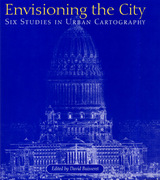 Envisioning the City: Six Studies in Urban Cartography
Edited by David Buisseret
University of Chicago Press, 1998 Churchman or merchant, soldier or sanitary engineer, everyone who lives in a city sees it differently. Envisioning the City explores how these points of urban view have been expressed in city plans. Ranging from vertical plans to bird's-eye views, profiles, and three-dimensional models, these diverse maps all show cities "the way people want to see them."
Whether a Chinese vertical city plan from the first millennium B.C. or a bird's-eye view appended to a fifteenth-century edition of Ptolemy's Geography, the type of plan chosen and its focus reflected the aspects of a city that the map's creators wished to highlight. For instance, maps of seventeenth-century cities emphasized impregnable fortifications as a deterrent to potential attackers. And Daniel Burnham's famous 1909 Plan of Chicago used a distinct representational style to "sell" his version of the new Chicago.
Although city plans are among the oldest maps known, few books have been devoted to them. Historians of cartography and geography, architects, and urban planners will all enjoy this profusely illustrated volume.
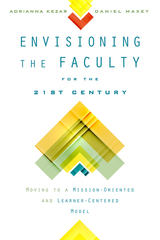 Envisioning the Faculty for the Twenty-First Century: Moving to a Mission-Oriented and Learner-Centered Model
Kezar, Adrianna
Rutgers University Press, 2016 The institution of tenure—once a cornerstone of American colleges and universities—is rapidly eroding. Today, the majority of faculty positions are part-time or limited-term appointments, a radical change that has resulted more from circumstance than from thoughtful planning. As colleges and universities evolve to meet the changing demands of society, how might their leaders design viable alternative faculty models for the future? Envisioning the Faculty for the Twenty-First Century weighs the concerns of university administrators, professors, adjuncts, and students in order to critically assess emerging faculty models and offer informed policy recommendations. Cognizant of the financial pressures that have led many universities to favor short-term faculty contracts, higher education experts Adrianna Kezar and Daniel Maxey assemble a top-notch roster of contributors to investigate whether there are ways to modify the existing system or promote new faculty models. They suggest how colleges and universities might rethink their procedures for faculty development, hiring, scheduling, and evaluation in order to maintain a campus environment that still fosters faculty service and student-centered learning.
Even as it asks urgent questions about how to retain the best elements of American higher education, Envisioning the Faculty for the Twenty-First Century also examines the opportunities that systemic changes might create. Ultimately, it provides some starting points for how colleges and universities might best respond to the rapidly evolving needs of an increasingly global society.
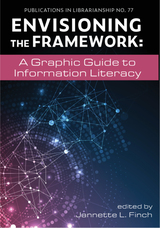 Envisioning the Framework
Jannette Finch
Association of College & Research Libraries, 2021 Data visualization—making sense of the world through images that tell a story—has a history that parallels human existence. The strength of visualization lies in its ability to reveal truth out of information that may remain hidden in lines of text, large data sets, or complex ideas. The Framework for Information Literacy for Higher Education presents complex threshold concepts, developed intentionally without prescriptive lists of skills and with flexible options for implementation, which can be explored and understood through visualization. Envisioning the Framework offers a visual opportunity for thought, discovery, and sense-making of the Framework and its concepts. Seventeen chapters packed with full-color illustrations and tables explore topics including: - LibGuides creation through conceptual integration with the Framework
- fostering interdisciplinary transference
- the convergence of metaliteracy with the Framework
- teaching multimodalities and data visualization
- mapping a culturally responsive information literacy journal for international students
Chapters include content for credit-bearing information courses, one-shots, and teaching first-year students. Twenty-first-century information literacy involves the metaliterate learner, reflects seismic changes in the duties and roles of teaching librarians, requires new partnerships with faculty and instructional designers, and emphasizes continuous assessment practices. Envisioning the Framework can help you use symbols and visuals for deeper understanding of the Framework, to map the Framework with teaching and learning objectives, and to tell a coherent story to students featuring the frames and the Framework.
 Envoy to the Archives: Ruth Anna Fisher and Hidden Transatlantic History
William L. Fox
University of Massachusetts Press, 2026 How a pioneering manuscript librarian and intellectual uncovered buried records that reshaped America’s past
As the London-based agent of the US Library of Congress, Ruth Anna Fisher (1886–1975) profoundly shaped the field of US history. Working at the British Museum and Public Record Office between the world wars, she was responsible for a vast program of identifying and copying up to a million documents related to American history, with prescient attention to the transatlantic slave trade. This monumental achievement has provided countless scholars access to source materials that might have remained hidden in repositories throughout Britian without Fisher’s brilliant discernment and tireless labor.
In Envoy to the Archives, William L. Fox offers the first full-length biography of this remarkable American intellectual. Born to a prominent African American family in northern Ohio, Fisher was keenly aware of racial issues throughout her life. She was associated with key thinkers in the Harlem Renaissance and the twentieth century transatlantic world, including W. E. B. Du Bois, Harold Laski, and J. Franklin Jameson. A trailblazer in historical research, Fisher was among a small group of Black women who first joined the ranks of professional library work, and her efforts in London coincided with the creation and consolidation of the US National Archives in the 1930s. She also mastered technologies that were new at the time, including photostat reproduction and microfilm—precursors to the many historical digitization projects of our own era. This engrossing biography adds to the growing body of work centered on Black women archivists, librarians, and curators. Fox draws on a wide range of archival sources, including the personal papers of prominent Black thinkers (Fisher’s were destroyed in the bombing of London in 1940), and various institutional records at the Library of Congress and the Carnegie Institution of Washington. Fox also knew Fisher personally, adding warmth and insight into this captivating portrait.
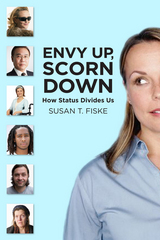 Envy Up, Scorn Down: How Status Divides Us
Susan T. Fiske
Russell Sage Foundation, 2011 An insightful examination of why we compare ourselves to those above and below us. The United States was founded on the principle of equal opportunity for all, and this ethos continues to inform the nation's collective identity. In reality, however, absolute equality is elusive. The gap between rich and poor has widened in recent decades, and the United States has the highest level of economic inequality of any developed country. Social class and other differences in status reverberate throughout American life, and prejudice based on another's perceived status persists among individuals and groups. In Envy Up, Scorn Down, noted social psychologist Susan Fiske examines the psychological underpinnings of interpersonal and intergroup comparisons, exploring why we compare ourselves to those both above and below us and analyzing the social consequences of such comparisons in day-to-day life. What motivates individuals, groups, and cultures to envy the status of some and scorn the status of others? Who experiences envy and scorn most? Envy Up, Scorn Down marshals a wealth of recent psychological studies as well as findings based on years of Fiske's own research to address such questions. She shows that both envy and scorn have distinctive biological, emotional, cognitive, and behavioral characteristics. And though we are all "wired" for comparison, some individuals are more vulnerable to these motives than others. Dominant personalities, for example, express envy toward high-status groups such as the wealthy and well-educated, and insecurity can lead others to scorn those perceived to have lower status, such as women, minorities, or the disabled. Fiske shows that one's race or ethnicity, gender, and education all correlate with perceived status. Regardless of whether one is accorded higher or lower status, however, all groups rank their members, and all societies rank the various groups within them. We rate each group as either friend or foe, able or unable, and accordingly assign them the traits of warmth or competence. The majority of groups in the United States are ranked either warm or competent but not both, with extreme exceptions: the homeless or the very poor are considered neither warm nor competent. Societies across the globe view older people as warm but incompetent. Conversely, the very rich are generally considered cold but highly competent. Envy Up, Scorn Down explores the nuances of status hierarchies and their consequences and shows that such prejudice in its most virulent form dehumanizes and can lead to devastating outcomes—from the scornful neglect of the homeless to the envious anger historically directed at Tutsis in Rwanda or Jews in Europe. Individuals, groups, and even cultures will always make comparisons between and among themselves. Envy Up, Scorn Down is an accessible and insightful examination of drives we all share and the prejudice that can accompany comparison. The book deftly shows that understanding envy and scorn—and seeking to mitigate their effects—can prove invaluable to our lives, our relationships, and our society.
Eothen: Traces of Travel Brought Home from the East
Alexander William Kinglake
Northwestern University Press, 1997 In the autumn of 1834, Alexander Kinglake and John Savile set out together for Turkey and the Levant. When Savile was summoned home Kinglake, accompanied only by his guide and interpreter, went on by ship to Cyprus and Beirut, then to the Holy Land, Cairo, and Damascus. On his own in a foreign world, Kinglake used the solitary travel for prolonged self-scrutiny, and ultimately for liberation.
Eothen has the freshness of the immediate and the new. Kinglake kept it free of the details of geography, history, science, politics, religion, and statistics; it is far less about the countries and the cities he passes through that it is about himself. This is what makes Eothen a modern travel book, possibly the first and certainly one of the greatest of its kind.
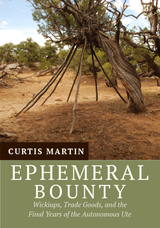 Ephemeral Bounty: Wickiups, Trade Goods, and the Final Years of the Autonomous Ute
Curtis Martin
University of Utah Press, 2016 The study of the last remaining Ute wickiups, or brush shelters, along with the historic artifacts found with them has uncovered an understudied chapter of Native American history—the early years of contact with European invaders and the final years of Ute sovereignty. Ephemeral Bounty is the result of this archaeological research and its findings on the protohistoric and early historic Ute Indians of Colorado.
The Colorado Wickiup Project is documenting ephemeral wooden features such as wickiups, tree-platforms, and brush horse corrals that remain scattered throughout the mesas, canyons, and mountains of the state. They date from when European newcomers first arrived with a bounty of new things—horses, metal knives and axes, guns, and brightly colored glass beads—which were readily adopted by the Utes. The Project is unique in using the techniques of metal detection, historic trade ware analysis, and tree-ring dating of metal ax–cut wickiup poles to distinguish the Ute sites from historic Euro–American ones. Through this analysis, researchers have demonstrated that not all Utes left Colorado for the reservations in Utah during the “final removal” in 1881, as has been generally believed. A significant number remained on their homelands well into the early decades of the twentieth century, building brush shelters and living much as they had for generations, but with new tools and weapons. Appendix B Form: Aboriginal Wooden Feature Component Form
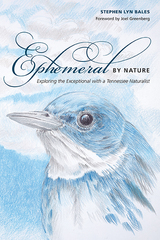 Ephemeral by Nature: Exploring the Exceptional with a Tennessee Naturalist
Stephen Lyn Bales
University of Tennessee Press, 2017 “Reading Ephemeral by Nature is the next best thing to talking a walk with Stephen Lyn Bales. In addition to describing the plants and animals readers will encounter, Bales scouts out hidden side trails. A look at jack-in-the-pulpit will turn up dinosaurs, Darwin, and Finding Nemo, and consideration of cerulean warblers will lead to coffee in Columbia and a discussion of why the sky is blue. Each chapter begins with one of his delightful drawings, and you’ll find Bales’ artistic eye is as discerning and detailed as his writing.”—Patricia K. Lichen, author of Passionate Slugs and Hollywood Frogs and Kidnapping the Wild One
In this captivating collection of twelve essays, a testament to a lifetime’s fascination with the outdoors and its myriad wonders, naturalist Stephen Lyn Bales examines a variety of flora and fauna that in one way or another can be described as “ephemeral”—that is, fleeting, short-lived, or transient.
Focusing on his native East Tennessee, Bales introduces us to several oddities, including the ghost plant, a wispy vascular plant that resembles a rooster’s tail and grows mainly in areas devoid of sunlight; the Appalachian panda, an ancestor of today’s red panda that wandered the region millions of years ago and whose fossil remains have only recently been discovered; and the freshwater jellyfish, a tiny organism that is virtually invisible except for those hot summer days when clusters of them bloom into shimmering “medusae,” sometimes by the thousands. Other essays consider such topics as the plight of the monarch butterfly, a gorgeous insect whose populations have dropped by 90 percent in only the last two decades; the reintroduction of the lake sturgeon, one of nature’s most primitive and seldom-seen fish, into the waters of the Tennessee Valley; and the surprising emergence of coyote-wolf and coyote-dog hybrids in the eastern states.
Written with insight, humor, and heart, Ephemeral by Nature is as entertaining as it is instructive. Along with a wealth of biological details—and his own handsome pen-and-ink drawings—Bales fills the book with delightful anecdotes of field trips, species-protection efforts, and those thrilling occasions when some elusive member of the natural order shows itself to us, if only for a brief moment.
Stephen Lyn Bales, senior naturalist at Ijams Nature Center in Knoxville, is the author of Natural Histories: Stories from the Tennessee Valley and Ghost Birds: Jim Tanner and the Quest for the Ivory-billed Woodpecker, 1935–1941, both published by the University of Tennessee Press.
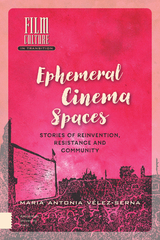 Ephemeral Cinema Spaces: Stories of Reinvention, Resistance and Community
Maria Vélez-Serna
Amsterdam University Press, 2020 With changing technologies and social habits, the communal cinema experience would seem to be a legacy from another era. However, the 2010s saw a surge in interest for screening films in other temporary public settings. This desire to turn ruins, pubs, galleries, parks, village halls, and even boats into ephemeral cinema spaces is a search for ways of being and working together, using cinema as a framework for social encounter. This book documents contemporary practices of pop-up and sitespecific cinema exhibition in the UK (with a focus on Scotland), tracing their links with historical forms of non-theatrical exhibition such as public hall cinema and fairground bioscopes. Through archival research, observation and interviews with film exhibitors and programmers, the book explores how exhibitors create ephemeral social spaces, how they negotiate the various uses and configurations of films and venues, and how they reinvent cinemagoing from its margins.
 Ephemeral City: A People's History of Chicago's Century of Progress World's Fair
Lindsay Fullerton
University of Illinois Press, 2025 Less celebrated than the 1893 Chicago World’s Fair, the 1933–1934 Century of Progress Exposition brought visitors face-to-face with gleaming American consumerism in the midst of the Great Depression. Lindsay Fullerton draws on a wealth of personal photographs, scrapbooks, oral histories, and writings to illuminate the wildly different experiences of fairgoers against the backdrop of a city steeped in poverty and segregation. The Exposition took place amidst massive changes sparked by expansion of mass media, Franklin Roosevelt’s election, the repeal of Prohibition, and the Great Migration. A diverse cross-section of Chicagoans informs Fullerton’s history of the event in the context of the fast-changing America of the interwar era. These personal accounts tell stories of how attendees interpreted their own experiences while being surrounded by whiz-bang products and full-throated evangelism on the benefits of progress. A colorful people’s history, Ephemeral City takes readers inside the other Chicago World’s Fair and how visitors interacted with a pivotal moment in American history.
Ephemeral Spectacles, Exhibition Spaces and Museums: 1750-1918
Dominique Bauer
Amsterdam University Press, 2021 This book examines ephemeral exhibitions from 1750 to 1918. In an era of acceleration and elusiveness, these transient spaces functioned as microcosms in which reality was shown, simulated, staged, imagined, experienced and known. They therefore had a dimension of spectacle to them, as the volume demonstrates. Against this backdrop, the different chapters deal with a plethora of spaces and spatial installations: the Wunderkammer, the spectacle garden, cosmoramas and panoramas, the literary space, the temporary museum, and the alternative exhibition space.
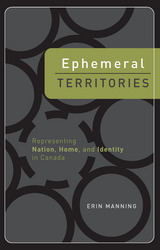 Ephemeral Territories: Representing Nation, Home, and Identity in Canada
Erin Manning
University of Minnesota Press, 2003 Explores questions of identity and belonging through the lens of Canadian cultural production What does it mean to be at home? In a critical engagement with notions of territory, identity, racial difference, separatism, multiculturalism, and homelessness, this book delves into the question of what it means to belong—in particular, what it means to be at home in Canada. Ephemeral Territories weaves together many narratives and representations of Canadian identity—from political philosophy and cultural theory to art and films such as Srinivas Krishna’s Lulu, Clement Virgo’s Rude, and Charles Biname’s Eldorado—to develop and complicate familiar views of identity and selfhood. Canadian identity has historically been linked to a dual notion of culture traceable to the French and English strains of Canada’s colonial past. Erin Manning subverts this binary through readings that shift our attention from nationalist constructions of identity and territory to a more radical and pluralizing understanding of the political. As she brings together issues specific to Canada (such as Quebec separatism and Canadian landscape painting) and concerns that are more transnational (such as globalization and immigration), Manning emphasizes the truly cross-cultural nature of the problems of racism, gender discrimination, and homelessness. Thus this impassioned reading of Canadian texts also makes an important contribution to philosophical, cultural, and political discourses across the globe.
 Ephesos, Metropolis of Asia: An Interdisciplinary Approach to Its Archaeology, Religion, and Culture
Helmut Koester
Harvard University Press This volume brings together studies of Ephesos—a major city in the Greco-Roman period and a primary center for the spread of Christianity into the Western world—by an international array of scholars from the fields of classics, fine arts, history of religion, New Testament, ancient Christianity, and archaeology. The studies were presented at a spring 1994 Harvard Divinity School symposium on Ephesos, focusing on the results of one hundred years of archaeological work at Ephesos by members of the Austrian Archaeological Institute.
The contributors to this volume discuss some of the most interesting and controversial results of recent investigations: the Processional Way of Artemis, the Hadrianic Olympieion and the Church of Mary, the so-called Temple of Domitian, and the heroes Androkolos and Arsinoe.
Since very little about the Austrian excavations at Ephesos has been published in English, this volume should prove useful in introducing the archaeology of this metropolis to a wider readership.
The Ephrata Commune: An Early American Counterculture
E.G. Alderfer
University of Pittsburgh Press, 1985 Tells of the founding and subsequent history of Ephrata, a mystical religious community that flourished in eastern Pennsylvania in the mid-eighteenth century. Its leader, Conrad Beissel, a German Pietist who came to America in 1720 seeking spiritual peace and solitude. Settled in Lancaster County, his talents and charisma attracted other German settlers who shared his vision of a community built in the image of apostolic Christianity.
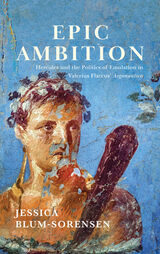 Epic Ambition: Hercules and the Politics of Emulation in Valerius Flaccus' Argonautica
Jessica Blum-Sorensen
University of Wisconsin Press, 2023 By the time the Roman poet Valerius Flaccus wrote in the first century CE, the tale of Jason and his famous ship the Argo had been retold so often it was a byword for poetic banality. Why, then, did Valerius construct his epic Argonautica? In this innovative analysis, Jessica Blum-Sorensen argues that it was precisely the myth’s overplayed nature that appealed to Valerius, operating in and responding to a period of social and political upheaval. Seeking to comment obliquely on Roman reliance on mythic exempla to guide action and expected outcomes, there was no better vessel for his social and political message than the familiar Argo.
Focusing especially on Hercules, Blum-Sorensen explores how Valerius’ characters—and, by extension, their Roman audience—misinterpret exemplars of past achievement, or apply them to sad effect in changed circumstances. By reading such models as normative guides to epic triumph, Valerius’ Argonauts find themselves enacting tragic outcomes: effectively, the characters impose their nostalgic longing for epic triumph on the events before them, even as Valerius and his audience anticipate the tragedy awaiting his heroes. Valerius thus questions Rome’s reliance on the past as a guide to the present, allowing for doubt about the empire’s success under the new Flavian regime. It is the literary tradition’s exchange between triumphant epic and tragedy that makes the Argo’s voyage a perfect vehicle for Valerius’ exploration: the tensions between genres both raise and prohibit resolution of anxieties about how the new age—mythological or real—will turn out.
Epic and Exile: Novels of the German Popular Front, 1933-1945
Hunter Bivens
Northwestern University Press, 2015 The antifascist exile beginning in 1933 led to a cooling among the émigrés of the artistic and literary modernist experiments of the Weimar Republic and to a return to realism and the traditional novel form. Epic and Exile examines the Popular Front– oriented cultural initiatives of the 1930s less in terms of their political strategy than in their function as a cultural and literary program for the exiles, implying a specific relationship to questions of artistic form, historical conceptions, and indeed the political as such. A popular front aesthetics is, Bivens argues, realist and modernist at once, and, in its focus on the opacities and contradictions of everyday life as a historical formation, it is particularly concerned with problems of the epic form.
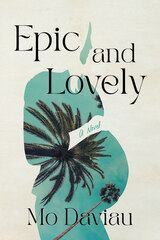 Epic and Lovely: A Novel
Mo Daviau
West Virginia University Press, 2025 Epic and Lovely is the swan song of Nina Simone Blaine, the daughter of a long-dead 1950s Vegas crooner and a Texas beauty queen forty years his junior. In the wake of her unexpected divorce, Nina returns to her hometown of Los Angeles to spend her final days with The Friends of the Good Thumb, a support group for patients with A12 Fibrillin Deficiency Syndrome, a genetic disorder that affects children of much-older fathers, causes several physical deformities, and results in death around the age of forty.
Written as a deathbed letter to the UCLA physician who has tracked Nina and the other Good Thumbs throughout their lives, Nina recounts her final days with the group and with Cole, the charismatic, sadistic fellow A12er with whom she has fallen madly in love, who charms and harms her in equal measures. An unlikely alliance with a tech billionaire, the return of her estranged mother, and the birth of the baby she never thought she’d have force Nina to reckon with the triumphs and mistakes of her life and to fight to leave her child in good hands.
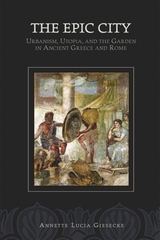 The Epic City: Urbanism, Utopia, and the Garden in Ancient Greece and Rome
Annette L. Giesecke
Harvard University Press, 2007 As Greek and Trojan forces battled in the shadow of Troy's wall, Hephaistos created a wondrous, ornately decorated shield for Achilles. At the Shield's center lay two walled cities, one at war and one at peace, surrounded by fields and pasturelands. Viewed as Homer's blueprint for an ideal, or utopian, social order, the Shield reveals that restraining and taming Nature would be fundamental to the Hellenic urban quest. It is this ideal that Classical Athens, with her utilitarian view of Nature, exemplified. In a city lacking pleasure gardens, it was particularly worthy of note when Epicurus created his garden oasis within the dense urban fabric. The disastrous results of extreme anthropocentrism would promote an essentially nostalgic desire to break down artificial barriers between humanity and Nature. This new ideal, vividly expressed through the domestication of Nature in villas and gardens and also through primitivist and Epicurean tendencies in Latin literature, informed the urban endeavors of Rome.
 The Epic Histories (Buzandaran Patmut‘iwnk‘): Attributed to P‘awstos Buzand
Nina G. Garsoïan
Harvard University Press, 1989 The late fifth-century anonymous Epic Histories, formerly known as the History of Armenia attributed to another unknown P‘awstos (Faustos) Buzand, form the earliest historical work written in Armenian. They are the main source for our knowledge of social structure, beliefs and customs of early Christian Armenia, and especially of the profound and lasting influence of Zoroastrian Persia on the recently converted country. This influence is evident in the very composition of the work, which owes as much to the lost oral tradition of the Iranian epic as to more familiar Classical and early Christian models.
Hence, it is unmatched for the reconstruction of the ambivalent world of the Near East in Late Antiquity at the cross roads between Classical and Iranian civilizations. Since no scholarly translation of this work into any Western language has been attempted for more than a century, much of its contribution has remained beyond the reach of most scholars. The aim of the present publication is to fill this lacuna by complementing the translation of the original Armenian text with a Commentary and Appendices that are intended to serve not only Armenian scholars but Classicists and Iranians alike.
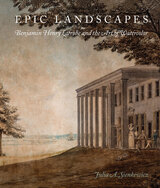 Epic Landscapes: Benjamin Henry Latrobe and the Art of Watercolor
Julia Sienkewicz
University of Delaware Press, 2011 Epic Landscapes is the first study devoted to architect Benjamin Henry Latrobe’s substantial artistic oeuvre from 1795, when he set sail from Britain to Virginia, to late 1798, when he relocated to Pennsylvania. Thus, this book offers the only extended consideration of Latrobe’s Virginian watercolors, including a series of complex trompe l’oeil studies and three significant illustrated manuscripts. Though Latrobe’s architecture is well known, his watercolors have received little critical attention. Epic Landscapes rediscovers Latrobe’s watercolors as an ambitious body of work and reconsiders the close relationship between the visual and spatial sensibility of these images and his architectural designs. It also offers a fresh analysis of Latrobe within the context of creative practice in the Atlantic world at the end of the eighteenth century as he explored contemporary ideas concerning the form of art for Republican society and the social impacts of revolution.
Published by University of Delaware Press. Distributed worldwide by Rutgers University Press.
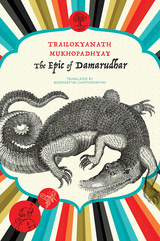 The Epic of Damarudhar
Trailokyanath Mukhopadhyay
Seagull Books, 2020 Originally published between 1910 and 1917, and collected in book form in 1923, The Epic of Damarudhar story cycle occupies an important and unique position in the history of Bengali literature. Tackling cosmology and mythology, class and caste abuse, nativist demagoguery and the harsh reality of rural poverty, all by means of unrelentingly fierce black comedy, Trailokyanath Mukhopadhyay’s cycle of seven stories featuring the raconteur Damarudhar remains prescient social commentary to this day.
With its generic fusion of tall tales, science, myth, politics, and the absurd, the work also announces the emergence of the genre of modern fantasy in Bengal. A detailed introduction, bibliography, and extensive annotation bring to life the context for these stories, highlighting key intertexts, political nuances, and important mythological references. This volume also contains the first translation of a rare biographical piece on the author, which includes long autobiographical parts written by Trailokyanath himself. Carefully translated and thoroughly researched, this volume will introduce a trenchant Indian voice to the English-language readership.
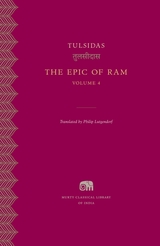 The Epic of Ram
Tulsidas
Harvard University Press, 2016 The authoritative new translation of the epic Ramayana, as retold by the sixteenth-century poet Tulsidas and cherished by millions to this day.
The Epic of Ram presents a new translation of the Rāmcaritmānas of Tulsidas (1543–1623). Written in Avadhi, a literary dialect of classical Hindi, the poem has become the most beloved retelling of the ancient Ramayana story across northern India. A devotional work revered and recited by millions of Hindus today, it is also a magisterial compendium of philosophy and lore and a literary masterpiece.
The fourth volume turns to the story of Ram’s younger half-brother Bharat. Despite efforts to place him on the throne of Avadh, Bharat refuses, ashamed that Ram has been exiled. In Bharat’s poignant pilgrimage to the forest to beg the true heir to return, Tulsidas draws an unforgettable portrait of devotion and familial love.
This new translation into free verse conveys the passion and momentum of the inspired poet and storyteller. It is accompanied by the most widely accepted edition of the Avadhi text, presented in the Devanagari script.
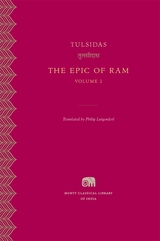 The Epic of Ram
Tulsidas
Harvard University Press, 2016 The authoritative new translation of the epic Ramayana, as retold by the sixteenth-century poet Tulsidas and cherished by millions to this day.
The Epic of Ram presents a new translation of the Rāmcaritmānas of Tulsidas (1543–1623). Written in Avadhi, a literary dialect of classical Hindi, the poem has become the most beloved retelling of the ancient Ramayana story across northern India. A devotional work revered and recited by millions of Hindus today, it is also a magisterial compendium of philosophy and lore and a literary masterpiece.
In the second volume, prompted by the tyranny of the demon king Ravan, Ram decides to be born on earth. Tulsidas lovingly details Ram’s infancy, childhood, and youthful adventures, the winning of Princess Sita as his bride, and the celebration of their marriage.
This new translation into free verse conveys the passion and momentum of its inspired poet and storyteller. It is accompanied by the most widely accepted edition of the Avadhi text, presented in the Devanagari script.
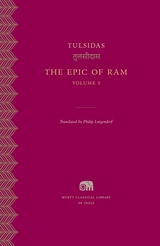 The Epic of Ram
Tulsidas
Harvard University Press, 2016 The authoritative new translation of the epic Ramayana, as retold by the sixteenth-century poet Tulsidas and cherished by millions to this day.
The Epic of Ram presents a new translation of the Rāmcaritmānas of Tulsidas (1543–1623). Written in Avadhi, a literary dialect of classical Hindi, the poem has become the most beloved retelling of the ancient Ramayana story across northern India. A devotional work revered and recited by millions of Hindus today, it is also a magisterial compendium of philosophy and lore and a literary masterpiece.
The third volume details the turbulent events surrounding the scheming of Prince Ram’s stepmother, who thwarts his installation on the throne of Avadh. Ram calmly accepts fourteen years of forest exile and begins his journey through the wilderness accompanied by his wife, Sita, and younger brother Lakshman. As they walk the long road, their beauty and serenity bring joy to villagers and sages dwelling in the forest.
This new translation into free verse conveys the passion and momentum of the inspired poet and storyteller. It is accompanied by the most widely accepted edition of the Avadhi text, presented in the Devanagari script.
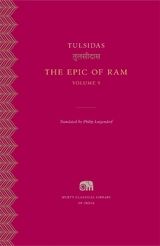 The Epic of Ram
Tulsidas
Harvard University Press, 2016 The authoritative new translation of the epic Ramayana, as retold by the sixteenth-century poet Tulsidas and cherished by millions to this day.
The Epic of Ram presents a new translation of the Rāmcaritmānas of Tulsidas (1543–1623). Written in Avadhi, a literary dialect of classical Hindi, the poem has become the most beloved retelling of the ancient Ramayana story across northern India. A devotional work revered and recited by millions of Hindus today, it is also a magisterial compendium of philosophy and lore and a literary masterpiece.
Volume 5 encompasses the story’s three middle episodes—Ram’s meetings with forest sages, his battles with demons, the kidnapping of his wife, his alliance with a race of marvelous monkeys—and climaxes with the god Hanuman’s heroic journey to the island city of Lanka to locate and comfort Sita.
This new translation into free verse conveys the passion and momentum of the inspired poet and storyteller. It is accompanied by the most widely accepted edition of the Avadhi text, presented in the Devanagari script.
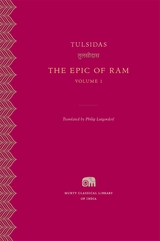 The Epic of Ram
Tulsidas
Harvard University Press, 2016 The authoritative new translation of the epic Ramayana, as retold by the sixteenth-century poet Tulsidas and cherished by millions to this day.
The Epic of Ram presents a new translation of the Rāmcaritmānas of Tulsidas (1543–1623). Written in Avadhi, a literary dialect of classical Hindi, the poem has become the most beloved retelling of the ancient Ramayana story across northern India. A devotional work revered and recited by millions of Hindus today, it is also a magisterial compendium of philosophy and lore and a literary masterpiece.
This volume presents Tulsidas’s grand introduction to the Ram story, replete with philosophical and theological meditations and tales of gods, sages, and royalty. Here, the stage is set for the advent and divine mission of Ram.
This new translation into free verse conveys the passion and momentum of its inspired poet and storyteller. It is accompanied by the most widely accepted edition of the Avadhi text, presented in the Devanagari script.
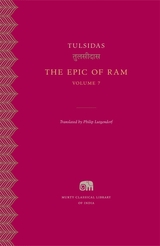 The Epic of Ram
Tulsidas
Harvard University Press, 2016 The authoritative new translation of the epic Ramayana, as retold by the sixteenth-century poet Tulsidas and cherished by millions to this day.
The Epic of Ram presents a new translation of the Rāmcaritmānas of Tulsidas (1543–1623). Written in Avadhi, a literary dialect of classical Hindi, the poem has become the most beloved retelling of the ancient Ramayana story across northern India. A devotional work revered and recited by millions of Hindus today, it is also a magisterial compendium of philosophy and lore, and a literary masterpiece.
The seventh volume completes Tulsidas’s grand epic. Ram reunites with his family in Ayodhya and assumes the throne, beginning his long, utopian reign. He also delivers ethical and spiritual teachings to his brothers and subjects. Then, a fascinating narrator—an immortal sage embodied in a lowly crow—reflects on Ram’s life story while recounting how he acquired wisdom, despite setbacks, on his own mystical and devotional quest across aeons.
This new translation into free verse conveys the passion and momentum of the inspired poet and storyteller. It is accompanied by the most widely accepted edition of the Avadhi text, presented in the Devanagari script.
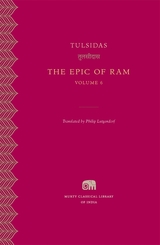 The Epic of Ram
Tulsidas
Harvard University Press, 2016 The authoritative new translation of the epic Ramayana, as retold by the sixteenth-century poet Tulsidas and cherished by millions to this day.
The Epic of Ram presents a new translation of the Rāmcaritmānas of Tulsidas (1543–1623). Written in Avadhi, a literary dialect of classical Hindi, the poem has become the most beloved retelling of the ancient Ramayana story across northern India. A devotional work revered and recited by millions of Hindus today, it is also a magisterial compendium of philosophy and lore, and a literary masterpiece.
In the sixth volume, Ram and his devoted allies fight the army of Ravan in a climactic battle that ends with the death of the demon king. Ram reunites with Sita, and—after her fidelity is confirmed by the burning of an illusory double—they board a flying palace to return to the city of Ayodhya, where Bharat has been waiting anxiously as his brother Ram’s fourteen-year exile nears its end.
This new translation into free verse conveys the passion and momentum of the inspired poet and storyteller. It is accompanied by the most widely accepted edition of the Avadhi text, presented in the Devanagari script.
EPIC OF THE AFTERLIFE: A LITERARY APPROACH TO SWEDENBORG
OLOF LAGERCRANTZ
Swedenborg Foundation Publishers, 2002
As a poet and storyteller, Olaf Lagercrantz approaches the works of Swedish scientist-turned-seer with the eyes of an artist, exploring the complex philosophy of one of Sweden's most famous sons with curiosity and open wonder. Lagercrantz examines Swedenborg's life, his experiences in heaven and hell, and writings about faith, the nature of the universe, and human relationships as works of literature, casting a new light on Swedenborg's ideas that often differs from the usual theological interpretations.
 Epic of the Dispossessed: Derek Walcott's Omeros
Robert D. Hamner
University of Missouri Press, 1997 In Epic of the Dispossessed, Robert D. Hamner offers an insightful, well-researched analysis of Omeros, the masterful epic poem by 1992 Nobel Laureate Derek Walcott. Rich and various, Omeros is an innovative extension of the epic tradition. Despite Walcott's insistence that he violates the formulaþhe notes his autobiographical presence in the poem and the absence of classical heroic figures and epic battlesþthe poem incorporates fragments of all the definitive characteristics of the genre. Hamner establishes that through its self-reflexive textuality, Omeros complements the time-honored tradition of the epic by giving voice to the marginalized peoples of the New World. Hamner briefly explains his perception of the epic tradition and its viability in contemporary literature. He examines Walcott's writing career and traces his development of devices, themes, techniques, and a narrative style essential to epic poetry. Although Walcott could not have fully anticipated Omeros, a retrospective view of his writing reveals the consistent accumulation of the skills and broad scope required for such an undertaking. Hamner attempts also to show that Walcott has incorporated into his personal style not only the more obvious aspects of his formal education but also uniquely West Indian cultural material and forms of expression. Hamner describes Omeros as an epic of the dispossessed because each of its protagonists is a castaway in one sense or another. Regardless of whether their ancestry is traced to the classical Mediterranean, Europe, Africa, or confined to the Americas, they are transplanted individuals whose separate quests all center on the fundamental human need to strike roots in a place where one belongs. Walcott's vivid, lyrical verse is visually compelling and aurally appealing. He is, however, a richly complex, allusive writer dealing with a wide range of profound human problems. Given the exciting climate of postcolonial and postmodern criticism, Walcott offers students and scholars unparalleled opportunities for challenging, creatively interpretive insights. Epic of the Dispossessed will be a valuable companion to the work that may prove to be Walcott's crowning achievement. The fresh and original Omeros stands on its own merits; nevertheless, it deserves to be examined in light of both Western tradition and its Caribbean context.
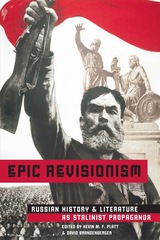 Epic Revisionism: Russian History and Literature as Stalinist Propaganda
Edited by Kevin M. F. Platt and David Brandenberger
University of Wisconsin Press, 2006 Focusing on a number of historical and literary personalities who were regarded with disdain in the aftermath of the 1917 revolution—figures such as Peter the Great, Ivan the Terrible, Alexander Pushkin, Leo Tolstoy, and Mikhail Lermontov—Epic Revisionism tells the fascinating story of these individuals’ return to canonical status during the darkest days of the Stalin era. An inherently interdisciplinary project, Epic Revisionism features pieces on literary and cultural history, film, opera, and theater. This volume pairs scholarly essays with selections drawn from Stalin-era primary sources—newspaper articles, unpublished archival documents, short stories—to provide students and specialists with the richest possible understanding of this understudied phenomenon in modern Russian history. “These scholars shed a great deal of light not only on Stalinist culture but on the politics of cultural production under the Soviet system.”—David L. Hoffmann, Slavic Review
The Epic Rhapsode and His Craft: Homeric Performance in a Diachronic Perspective
José M. González
Harvard University Press, 2015 The Epic Rhapsode and His Craft studies Homeric performance from archaic to Roman imperial times. It argues that oracular utterance, dramatic acting, and rhetorical delivery powerfully elucidate the practice of epic rhapsodes. Attention to the ways in which these performance domains informed each other over time reveals a shifting dynamic of competition and emulation among rhapsodes, actors, and orators that shaped their texts and their crafts. A diachronic analysis of this web of influences illuminates fundamental aspects of Homeric poetry: its inspiration and composition, the notional fixity of its poetic tradition, and the performance-driven textual fixation and writing of the Homeric poems. It also shows that rhapsodic practice is best understood as an evolving combination of revelation, interpretation, recitation, and dramatic delivery.
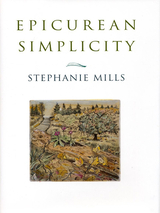 Epicurean Simplicity
Stephanie Mills
Island Press, 2003 "In this book, I relate the pleasures, as well as the virtues and difficulties of a perhaps simpler than average North American life." So begins ecological thinker and writer Stephanie Mills's Epicurean Simplicity, a thoughtful paean to living, like Thoreau, a deliberate life. Mills's account of the simple life reaches deep into classical sources of pleasure -- good food, good health, good friends, and particularly the endless delights of the natural world. Her musings about the life she desires -- and the life she has created -- ultimately led her to the third century Greek philosopher Epicurus, whose philosophy was premised on the trustworthiness of the senses, a philosophy that Mills wholeheartedly embraces. While later centuries have come to associate Epicurus's name with hedonism, Mills discovered that he extolled simplicity and prudence as the surest means to pleasure, and his thinking offers an important philosophical touchstone for the book. As the author explains, one of the primary motivations for her pursuit of simplicity is her concern about the impacts of a consumerist lifestyle on the natural world. Mills touches on broad range of topics relating to that issue -- social justice, biological extinctions, the global economy, and also more personal aspects such as friendship, the process of country living, the joys of physical exertion, the challenges of a writer's life, and the natural history and seasonal delights of a life lived close to nature. An overarching theme is the destructiveness of consumerism, and how even a simple life affects a wide range of organisms and adds strain to the earth's systems. The author uses her own experience as an entry point to the discussion with a self-effacing humor and lyrical prose that bring big topics to a personal level. Epicurean Simplicity is beautifully crafted, fluid, inspiring, and enlightening, examining topics of critical importance that affect us all. It celebrates the pleasures, beauty, and fulfillment of a simple life, a goal being sought by Americans from all walks of life, from harried single parents to corporate CEOs. For fans of natural history or personal narrative, for those concerned about social justice and the environment, and for those who have come to know and love Stephanie Mills through her speaking and writing, Epicurean Simplicity is a rare treasure.
Epicurus and His Philosophy
Norman Wentworth DeWitt
University of Minnesota Press, 1954 Epicurus and His Philosophy was first published in 1954. Minnesota Archive Editions uses digital technology to make long-unavailable books once again accessible, and are published unaltered from the original University of Minnesota Press editions. In this volume, the first comprehensive book in English about Epicurus, existing data on the life of the ancient philosopher is related to the development of his doctrine. The result is a fascinating account that challenges traditional theories and interpretations of Epicurean philosophy. Professor DeWitt demonstrates the fallacy of centuries of abuse of Epicurus and the resulting distortion of most discussions of Epicureanism that appear in standard philosophical works. Of major significance to students of philosophy and theology are the findings that show the importance of Epicureanism as a source of numerous Christian beliefs.
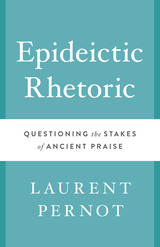 Epideictic Rhetoric: Questioning the Stakes of Ancient Praise
By Laurent Pernot
University of Texas Press, 2015 Speeches of praise and blame constituted a form of oratory put to brilliant and creative use in the classical Greek period (fifth to fourth century BC) and the Roman imperial period (first to fourth century AD), and they have influenced public speakers through all the succeeding ages. Yet unlike the other classical genres of rhetoric, epideictic rhetoric remains something of a mystery. It was the least important genre at the start of Greek oratory, but its role grew exponentially in subsequent periods, even though epideictic orations were not meant to elicit any action on the part of the listener, as judicial and deliberative speeches attempted to do. So why did the ancients value the oratory of praise so highly? In Epideictic Rhetoric, Laurent Pernot offers an authoritative overview of the genre that surveys its history in ancient Greece and Rome, its technical aspects, and its social function. He begins by defining epideictic rhetoric and tracing its evolution from its first realizations in classical Greece to its eloquent triumph in the Greco-Roman world. No longer were speeches limited to tribunals, assemblies, and courts—they now involved ceremonies as well, which changed the political and social implications of public speaking. Pernot analyzes the techniques of praise, both as stipulated by theoreticians and as practiced by orators. He describes how epideictic rhetoric functioned to give shape to the representations and common beliefs of a group, render explicit and justify accepted values, and offer lessons on new values. Finally, Pernot incorporates current research about rhetoric into the analysis of praise.
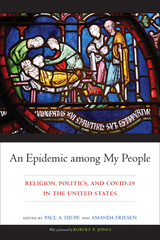 An Epidemic among My People: Religion, Politics, and COVID-19 in the United States
Edited by Paul A. Djupe and Amanda Friesen
Temple University Press, 2023 The pandemic presented religion as a paradox: faith is often crucial for helping people weather life’s troubles and make difficult decisions, but how can religion continue to deliver these benefits and provide societal structure without social contact? The topical volume, An Epidemic among My People explains how the COVID-19 pandemic stress tested American religious communities and created a new politics of religion centered on public health. The editors and contributorsconsider how the virus and government policy affected religion in America. Chapters examine the link between the prosperity gospel and conspiracy theories, the increased purchase of firearms by evangelicals, the politics of challenging public health orders as religious freedom claims, and the reactions of Christian nationalists, racial groups, and female clergy to the pandemic (and pandemic politics). As sharp lines were drawn between people and their governments during this uncertain time, An Epidemic among My People provides a comprehensive portrait of religion in American public life.
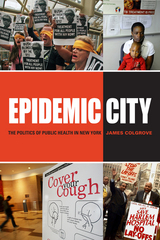 Epidemic City: The Politics of Public Health in New York
James Colgrove
Russell Sage Foundation, 2011 An insightful chronicle of the changing public health demands in New York City. The first permanent Board of Health in the United States was created in response to a cholera outbreak in New York City in 1866. By the mid-twentieth century, thanks to landmark achievements in vaccinations, medical data collection, and community health, the NYC Department of Health had become the nation's gold standard for public health. However, as the city's population grew in number and diversity, the department struggled to balance its efforts between the treatment of diseases—such as AIDS, tuberculosis, and West Nile Virus—and the prevention of illness-causing factors like lead paint, heroin addiction, homelessness, smoking, and unhealthy foods. In Epidemic City, historian of public health James Colgrove chronicles the challenges faced by the health department since New York City's mid-twentieth-century "peak" in public health provision. This insightful volume draws on archival research and oral histories to examine how the provision of public health has adapted to the competing demands of diverse public needs, public perceptions, and political pressure. Epidemic City analyzes the perspectives and efforts of the people responsible for the city's public health from the 1960s to the present—a time that brought new challenges, such as budget and staffing shortages, and new threats like bioterrorism. Faced with controversies such as needle exchange programs and AIDS reporting, the health department struggled to maintain a delicate balance between its primary focus on illness prevention and the need to ensure public and political support for its activities. In the past decade, after the 9/11 attacks and bioterrorism scares partially diverted public health efforts from illness prevention to threat response, Mayor Michael Bloomberg and Health Commissioner Thomas Frieden were still able to pass New York's Clean Indoor Air Act restricting smoking and significant regulations on trans-fats used by restaurants. This legislation—preventative in nature much like the department's original sanitary code—reflects a return to the nineteenth century roots of public health, when public health measures were often overtly paternalistic. The assertive laws conceived by Frieden and executed by Bloomberg demonstrate how far the mandate of public health can extend when backed by committed government officials. Epidemic City provides a compelling historical analysis of the individuals and groups tasked with negotiating the fine line between public health and political considerations. By examining the department's successes and failures during the ambitious social programs of the 1960s, the fiscal crisis of the 1970s, the struggles with poverty and homelessness in the 1980s and 1990s, and in the post-9/11 era, Epidemic City shows how the NYC Department of Health has defined the role and scope of public health services for the entire nation.
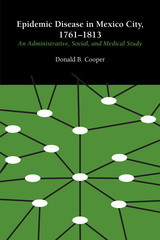 Epidemic Disease in Mexico City, 1761–1813: An Administrative, Social, and Medical Study
By Donald B. Cooper
University of Texas Press, 1965 Five deadly epidemics, chiefly typhus and smallpox, struck Mexico City in the years between 1761 and 1813, claiming a minimum of fifty thousand lives. Mexico City was at that time the major metropolis of the New World and the capital of New Spain—by far the richest and most sophisticated city in that vast empire. It had the best medicines, the best doctors, and the best hospitals of the New World. What caused these devastating epidemics? Donald B. Cooper here makes a thorough study of the problem. Based almost entirely on unpublished manuscript materials from the national archives of Mexico and the municipal archives of Mexico City, his work represents the first detailed study of the impact of epidemic disease on the history of New Spain, primarily of its capital. The course of each epidemic, its inclusive dates, the mortality it caused, and its effect upon the community are fully described. At the time a major epidemic was in progress, the author says, all levels of government, national and local, secular and ecclesiastical, became involved in varying degrees in providing resources and leadership. The Church, wealthy corporations, and private citizens contributed the main funds. During the actual time of crisis, an outbreak could be prosecuted with remarkable success and cooperation. Once an epidemic was over, however, little was done to prevent another. No single person or agency in Mexico City was sufficiently cognizant of the diverse problems involved to cope with them within a national or regional range—not even the viceroy. Such vital public works as aqueducts, waterlines, roads, and canals were inadequately maintained. Such essential municipal services as cleaning streets and canals, collecting garbage and refuse, and caring for the muddy, shallow cemeteries were poor if not nonexistent. Government officials, as well as the populace, were insufficiently concerned with the relation between sanitation and disease. The practice of medicine in eighteenth-century Mexico had few scientific or professional aspects. The close relation of medicine and theology tended to inhibit experimentation that might have effectively broadened the frontiers of medical knowledge. Traditionalism acted as a barrier to the adoption of innovations. In the epidemic of 1779, for instance, inoculation—which could have saved innumerable lives—was totally rejected; in the outbreak of 1797 it was accepted only by the small upper class; when vaccination came to Mexico in 1803 it met the same militant opposition. The wonder, then, is not that so many died of disease, but that so many lived.
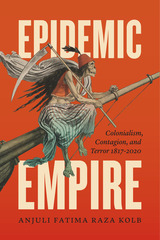 Epidemic Empire: Colonialism, Contagion, and Terror, 1817–2020
Anjuli Fatima Raza Kolb
University of Chicago Press, 2021 Terrorism is a cancer, an infection, an epidemic, a plague. For more than a century, this metaphor has figured insurgent violence as contagion in order to contain its political energies. In Epidemic Empire, Anjuli Fatima Raza Kolb shows that this trope began in responses to the Indian Mutiny of 1857 and tracks its tenacious hold through 9/11 and beyond. The result is the first book-length study to approach the global War on Terror from a postcolonial literary perspective. Raza Kolb assembles a diverse archive from colonial India, imperial Britain, French and independent Algeria, the postcolonial Islamic diaspora, and the neoimperial United States. Anchoring her book are studies of four major writers in the colonial-postcolonial canon: Rudyard Kipling, Bram Stoker, Albert Camus, and Salman Rushdie. Across these sources, she reveals the tendency to imagine anticolonial rebellion, and Muslim insurgency specifically, as a virulent form of social contagion. Exposing the long history of this broken but persistent narrative, Epidemic Empire is a major contribution to the rhetorical history of our present moment.
 Epidemic Invasions: Yellow Fever and the Limits of Cuban Independence, 1878-1930
Mariola Espinosa
University of Chicago Press, 2009 In the early fall of 1897, yellow fever shuttered businesses, paralyzed trade, and caused tens of thousand of people living in the southern United States to abandon their homes and flee for their lives. Originating in Cuba, the deadly plague inspired disease-control measures that not only protected U.S. trade interests but also justified the political and economic domination of the island nation from which the pestilence came. By focusing on yellow fever, Epidemic Invasions uncovers for the first time how the devastating power of this virus profoundly shaped the relationship between the two countries.
Yellow fever in Cuba, Mariola Espinosa demonstrates, motivated the United States to declare war against Spain in 1898, and, after the war was won and the disease eradicated, the United States demanded that Cuba pledge in its new constitution to maintain the sanitation standards established during the occupation. By situating the history of the fight against yellow fever within its political, military, and economic context, Espinosa reveals that the U.S. program of sanitation and disease control in Cuba was not a charitable endeavor. Instead, she shows that it was an exercise in colonial public health that served to eliminate threats to the continued expansion of U.S. influence in the world.
 An Epidemic of Rumors: How Stories Shape Our Perception of Disease
Jon D. Lee
Utah State University Press, 2014 In An Epidemic of Rumors, Jon D. Lee examines the human response to epidemics through the lens of the 2003 SARS epidemic. Societies usually respond to the eruption of disease by constructing stories, jokes, conspiracy theories, legends, and rumors, but these narratives are often more damaging than the diseases they reference. The information disseminated through them is often inaccurate, incorporating xenophobic explanations of the disease’s origins and questionable medical information about potential cures and treatment. Folklore studies brings important and useful perspectives to understanding cultural responses to the outbreak of disease. Through this etiological study Lee shows the similarities between the narratives of the SARS outbreak and the narratives of other contemporary disease outbreaks like AIDS and the H1N1 virus. His analysis suggests that these disease narratives do not spring up with new outbreaks or diseases but are in continuous circulation and are recycled opportunistically. Lee also explores whether this predictability of vernacular disease narratives presents the opportunity to create counter-narratives released systematically from the government or medical science to stymie the negative effects of the fearful rumors that so often inflame humanity. With potential for practical application to public health and health policy, An Epidemic of Rumors will be of interest to students and scholars of health, medicine, and folklore.
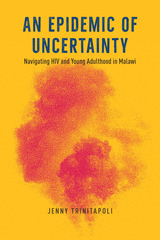 An Epidemic of Uncertainty: Navigating HIV and Young Adulthood in Malawi
Jenny Trinitapoli
University of Chicago Press, 2023 A decade-long study of young adulthood in Malawi that demonstrates the impact of widespread HIV status uncertainty, laying bare the sociological implications of what is not known.
An Epidemic of Uncertainty advances a new framework for studying social life by emphasizing something social scientists routinely omit from their theories, models, and measures–what people know they don’t know. Taking Malawi’s ongoing AIDS epidemic as an entry point, Jenny Trinitapoli shows that despite admirable declines in new HIV infections and AIDS-related mortality, an epidemic of uncertainty persists; at any given point in time, fully half of Malawian young adults don’t know their HIV status. Reckoning with the impact of this uncertainty within the bustling trading town of Balaka, Trinitapoli argues that HIV-related uncertainty is measurable, pervasive, and impervious to biomedical solutions, with consequences that expand into multiple domains of life, including relationship stability, fertility, and health. Over the duration of a groundbreaking decade-long longitudinal study, rich survey data and poignant ethnographic vignettes vividly depict how individual lives and population patterns unfold against the backdrop of an ever-evolving epidemic. Even as HIV is transformed from a progressive, fatal disease to a chronic and manageable condition, the accompanying epidemic of uncertainty remains fundamental to understanding social life in this part of the world.
Insisting that known unknowns can and should be integrated into social-scientific models of human behavior, An Epidemic of Uncertainty treats uncertainty as an enduring aspect, a central feature, and a powerful force in everyday life.
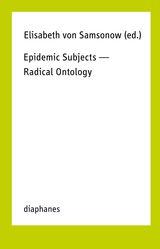 Epidemic Subjects - Radical Ontology
Edited by Elisabeth von Samsonow
Diaphanes, 2016 Modern philosophy continues to grapple with the idea of subjectivity—and, as the concept of subjectivity has consequently been repeatedly refined and redefined, the struggle has spread to the ways we conceive of sovereignty, collectivity, nationality, and identity as a result. Yet, in the absence of an authoritative account of these central philosophical concepts, exciting new ways of thinking have emerged which continue to develop and evolve.
Epidemic Subjects—Radical Ontology brings together a renowned team of contributors, including Levi Bryant, Angela Melitopoulos, and Susan Stryker, who together forge a radically inclusive definition of subjectivity. Drawing on Gilles Deleuze and Félix Guattari’s concept of the “girl” as a heuristic device for examining modern society and its foundations, they tie together recent trends in philosophy and offer a concrete way forward from the conception of the “thing” or “object” privileged by new materialism, speculative realism, and other theories of subjectivity.
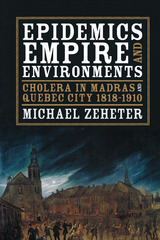 Epidemics, Empire, and Environments: Cholera in Madras and Quebec City, 1818–1910
Michael Zeheter
University of Pittsburgh Press, 2015 Throughout the nineteenth century, cholera was a global scourge against human populations. Practitioners had little success in mitigating the symptoms of the disease, and its causes were bitterly disputed. What experts did agree on was that the environment played a crucial role in the sites where outbreaks occurred. In this book, Michael Zeheter offers a probing case study of the environmental changes made to fight cholera in two markedly different British colonies: Madras in India and Quebec City in Canada.
The colonial state in Quebec aimed to emulate British precedent and develop similar institutions that allowed authorities to prevent cholera by imposing quarantines and controlling the disease through comprehensive change to the urban environment and sanitary improvements. In Madras, however, the provincial government sought to exploit the colony for profit and was reluctant to commit its resources to measures against cholera that would alienate the city’s inhabitants. It was only in 1857, after concern rose in Britain over the health of its troops in India, that a civilizing mission of sanitary improvement was begun. As Zeheter shows, complex political and economic factors came to bear on the reshaping of each colony's environment and the urgency placed on disease control.
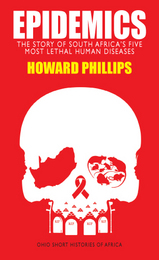 Epidemics: The Story of South Africa’s Five Most Lethal Human Diseases
Howard Phillips
Ohio University Press, 2012 This is the first history of epidemics in South Africa, lethal episodes that significantly shaped this society over three centuries. Focusing on five devastating diseases between 1713 and today—smallpox, bubonic plague, “Spanish influenza,” polio, and HIV/AIDS—the book probes their origins, their catastrophic courses, and their consequences in both the short and long terms. The impacts of these epidemics ranged from the demographic—the “Spanish flu,” for instance, claimed the lives of six percent of the country’s population in six weeks—to the political, the social, the economic, the spiritual, the psychological, and the cultural. Moreover, as each of these epidemics occurred at crucial moments in the country’s history—such as during the South African War and World War I—the book also examines how these processes affected and were affected by the five epidemics. To those who read this book, history will not look the same again.
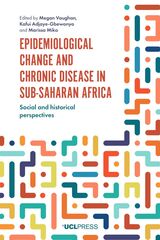 Epidemiological Change and Chronic Disease in Sub-Saharan Africa: Social and Historical Perspectives
Edited by Megan Vaughan, Kafui Adjaye-Gbewonyo, and Marissa Mika
University College London, 2020 New perspectives on the changing epidemiology of sub-Saharan Africa.
Epidemiological Change and Chronic Disease in Sub-Saharan Africa offers new and critical perspectives on the causes and consequences of recent epidemiological changes in sub-Saharan Africa, with a special focus on the increasing incidence of “non-communicable” and chronic conditions. In this book, historians, social anthropologists, public health experts, and social epidemiologists present important insights into epidemiological change in Africa beyond theories of “transition.” The volume covers a broad thematic range, including the trajectory of maternal mortality in East Africa, the smoking epidemic, the history of sugar consumption in South Africa, the causality between infectious and non-communicable diseases in Ghana and Belize, the complex relationships between adult hypertension and pediatric HIV in Botswana, and stories of cancer patients and their families in Kenya. In all, the volume provides insights drawn from historical perspectives and from the African social and clinical experience that are of value to students and researchers in global health, medical anthropology, public health, and African studies.
Epidemiology of Neurologic and Sense Organ Disorders
Leonard T. Kurland, John F. Kurtzke, and Irving D. Goldberg
Harvard University Press, 1973 This is the first book-length treatment of the frequency and distribution of neurologic and sense disorders. It is based primarily on special tabulations of mortality data for 1959–1961 applied to the U.S. census of 1960. Information on incidence, prevalence, and survivorship is provided for each major disorder and a summary chapter considers the frequency and geographic distribution of neurologic disorders in terms of age, sex, color, and demographic characteristics.
The Epidemiology of Oral Health
Walter J. Pelton, John B. Dunbar, Russell S. McMillan, Palmi Moller, and Albert E. Wolff
Harvard University Press The authors here present a compendium of essential information on dental diseases. The volume focuses on statistical data accumulated since the earliest efforts to quantify the dental caries problem in the 1930s. The five main topics are “Dental Caries” by John B. Dunbar, Director of the Urban Institute, University of Alabama at Birmingham; “Periodontal Disease” by Russell S. McMillan, Associate Professor, University of Southern California and Albert E. Wolff, Associate Professor, University of Alabama Medical Center and School of Dentistry; “Oral Cancer” by Walter J. Pelton, Professor, University of Alabama School of Dentistry; and “Malocclusion” and “Cleft Lip and Palate” by Palmi Moller, Associate Professor, University of Alabama School of Dentistry.
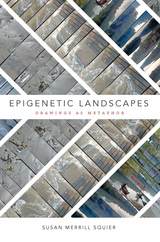 Epigenetic Landscapes: Drawings as Metaphor
Susan Merrill Squier
Duke University Press, 2017 Devised in the 1940s by the biologist C. H. Waddington, the epigenetic landscape is a metaphor for how gene regulation modulates cellular development. As a scientific model, it fell out of use in the late 1960s but returned at the beginning of the twenty-first century with the advent of big-data genomic research because of its utility among scientists across the life sciences to think more creatively about and to discuss genetics. In Epigenetic Landscapes Susan Merrill Squier follows the model’s cultural trail, from its first visualization by the artist John Piper to its use beyond science. Squier examines three cases in which the metaphor has been imaginatively deployed to illustrate complex systems that link scientific and cultural practices: graphic medicine, landscape architecture, and bioArt. Challenging reductive understandings of epigenetics, Squier boldly reclaims the broader significance of the epigenetic landscape as a figure at the nexus of art, design, and science.
 Epigrams, Volume I: Spectacles. Books 1–5
Martial
Harvard University Press, 1993 Poetic concision in abundance.
It was to celebrate the opening of the Roman Colosseum in AD 80 that Martial published his first book of poems, “On the Spectacles.” Written with satiric wit and a talent for the memorable phrase, the poems in this collection record the broad spectacle of shows in the new arena. The great Latin epigrammist’s twelve subsequent books capture the spirit of Roman life—both public and private—in vivid detail. Fortune hunters and busybodies, orators and lawyers, schoolmasters and street hawkers, jugglers and acrobats, doctors and plagiarists, beautiful slaves, and generous hosts are among the diverse characters who populate his verses.
Martial is a keen and sharp-tongued observer of Roman society. His pen brings into crisp relief a wide variety of scenes and events: the theater and public games, life in the countryside, a rich debauchee’s banquet, lions in the amphitheater, the eruption of Vesuvius. The epigrams are sometimes obscene, in the tradition of the genre, sometimes warmly affectionate or amusing, and always pointed. Like his contemporary Statius, though, Martial shamelessly flatters his patron Domitian, one of Rome’s worst-reputed emperors.
D. R. Shackleton Bailey’s translation of Martial’s often difficult Latin eliminates many misunderstandings in previous versions. The text is mainly that of his highly praised Teubner edition of 1990.
 Epigrams, Volume II: Books 6–10
Martial
Harvard University Press, 1993 Poetic concision in abundance.
It was to celebrate the opening of the Roman Colosseum in AD 80 that Martial published his first book of poems, “On the Spectacles.” Written with satiric wit and a talent for the memorable phrase, the poems in this collection record the broad spectacle of shows in the new arena. The great Latin epigrammist’s twelve subsequent books capture the spirit of Roman life—both public and private—in vivid detail. Fortune hunters and busybodies, orators and lawyers, schoolmasters and street hawkers, jugglers and acrobats, doctors and plagiarists, beautiful slaves, and generous hosts are among the diverse characters who populate his verses.
Martial is a keen and sharp-tongued observer of Roman society. His pen brings into crisp relief a wide variety of scenes and events: the theater and public games, life in the countryside, a rich debauchee’s banquet, lions in the amphitheater, the eruption of Vesuvius. The epigrams are sometimes obscene, in the tradition of the genre, sometimes warmly affectionate or amusing, and always pointed. Like his contemporary Statius, though, Martial shamelessly flatters his patron Domitian, one of Rome’s worst-reputed emperors.
D. R. Shackleton Bailey’s translation of Martial’s often difficult Latin eliminates many misunderstandings in previous versions. The text is mainly that of his highly praised Teubner edition of 1990.
 Epigrams, Volume III: Books 11–14
Martial
Harvard University Press, 1993 Poetic concision in abundance.
It was to celebrate the opening of the Roman Colosseum in AD 80 that Martial published his first book of poems, “On the Spectacles.” Written with satiric wit and a talent for the memorable phrase, the poems in this collection record the broad spectacle of shows in the new arena. The great Latin epigrammist’s twelve subsequent books capture the spirit of Roman life—both public and private—in vivid detail. Fortune hunters and busybodies, orators and lawyers, schoolmasters and street hawkers, jugglers and acrobats, doctors and plagiarists, beautiful slaves, and generous hosts are among the diverse characters who populate his verses.
Martial is a keen and sharp-tongued observer of Roman society. His pen brings into crisp relief a wide variety of scenes and events: the theater and public games, life in the countryside, a rich debauchee’s banquet, lions in the amphitheater, the eruption of Vesuvius. The epigrams are sometimes obscene, in the tradition of the genre, sometimes warmly affectionate or amusing, and always pointed. Like his contemporary Statius, though, Martial shamelessly flatters his patron Domitian, one of Rome’s worst-reputed emperors.
D. R. Shackleton Bailey’s translation of Martial’s often difficult Latin eliminates many misunderstandings in previous versions. The text is mainly that of his highly praised Teubner edition of 1990.
 Epilepsy and the Family: A New Guide
Richard Lechtenberg M.D.
Harvard University Press, 2002 Epilepsy and the Family: A New Guide updates Richard Lechtenberg’s classic handbook for people with seizure disorders and those closest to them. It offers coping strategies for the wide range of practical and emotional challenges that epilepsy can introduce into the family: marital and sexual difficulties, concerns about pregnancy and inheritance, drug compliance and abuse among teenagers, personality changes and suicide. This new guide addresses the personal questions that adults with epilepsy may be reluctant to ask their physician, and it offers chapters tailored to the special stresses of spouses, parents, and siblings who, like the patient, must live with a seizure disorder.
As many as two and a half million Americans have epilepsy. Thirty percent of them are children under the age of 18. And there are 125,000 newly diagnosed cases each year. A practicing neurologist with decades of clinical experience, Lechtenberg clearly and concisely explains the biology behind this complex and relatively widespread class of diseases. He discusses the various medical conditions that can cause seizures in children and adults and points out that the cause of many seizure disorders is never discovered. Patients and those who care about them will find authoritative but accessible advice on various medications and surgical approaches and the information they need to ask informed questions of their doctors. For the medical professional, this book offers important information on how to better treat the patient with epilepsy by recognizing the needs of the entire family.
This revised edition addresses:
— New drugs and surgical techniques that have been developed in the past 15 years
— Pharmaceutical and non-pharmaceutical treatment strategies
— New clinical data on drug combinations and side effects
— Up-to-date statistics for mortality, reproduction, violent behavior, divorce, and suicide
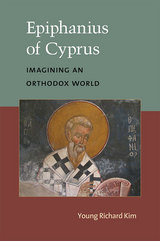 Epiphanius of Cyprus: Imagining an Orthodox World
Young Richard Kim
University of Michigan Press, 2015 Epiphanius of Cyprus offers the first complete biography in English of Epiphanius, lead bishop of Cyprus in the late fourth century CE and author of the Panarion, a massive encyclopedia of heresies. Imagining himself a defender of orthodoxy, he became an active heresy-hunter, involving himself in the most significant theological and ecclesiastical debates of his day. Young Richard Kim studies the bishop as a historical person and a self-constructed persona, as mediated within the pages of the Panarion. Kim’s “micro-readings” of the Panarion present a close look at autobiographical anecdotes, situated in historical contexts, that profoundly shaped both Epiphanius’ character and how he wanted his readers to perceive him. “Macro-readings” examine portions of the Panarion that reflected how Epiphanius imagined his world, characterized by an orthodoxy that had existed since Creation and was preserved through the generations. In the final chapter, Kim considers Epiphanius’ life after the publication of the Panarion and how he spent years “living” the pages of his heresiology. Kim brings a more balanced perspective to a controversial figure, recognizing shortcomings but also understanding them in light of Epiphanius’ own world. The bishop appears not as a buffoon, but as someone who knew how to use the power of the rhetoric of orthodoxy to augment his own authority. Quintessentially late antique, he embodied the contentious transition from the classical past to the medieval and Byzantine worlds. This book will be of broad interest to students and scholars of ancient history, classics, and religious studies.
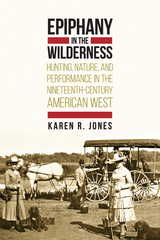 Epiphany in the Wilderness: Hunting, Nature, and Performance in the Nineteenth-Century American West
Karen R. Jones
University Press of Colorado, 2016 Whether fulfilling subsistence needs or featured in stories of grand adventure, hunting loomed large in the material and the imagined landscape of the nineteenth-century West. Epiphany in the Wilderness explores the social, political, economic, and environmental dynamics of hunting on the frontier in three “acts,” using performance as a trail guide and focusing on the production of a “cultural ecology of the chase” in literature, art, photography, and taxidermy. Using the metaphor of the theater, Jones argues that the West was a crucial stage that framed the performance of the American character as an independent, resourceful, resilient, and rugged individual. The leading actor was the all-conquering masculine hunter hero, the sharpshooting man of the wilderness who tamed and claimed the West with each provident step. Women were also a significant part of the story, treading the game trails as plucky adventurers and resilient homesteaders and acting out their exploits in autobiographical accounts and stage shows. Epiphany in the Wilderness informs various academic debates surrounding the frontier period, including the construction of nature as a site of personal challenge, gun culture, gender adaptations and the crafting of the masculine wilderness hero figure, wildlife management and consumption, memorializing and trophy-taking, and the juxtaposition of a closing frontier with an emerging conservation movement.
The University Press of Colorado gratefully acknowledges the generous support of the Charles Redd Center for Western Studies at Brigham Young University toward the publication of this book.
 Epiploke: Rhythmical Continuity and Poetic Structure in Greek Lyric
Thomas Cole
Harvard University Press, 1988 Ancient metricians saw Greek verse in essentially paradigmatic terms, as a mosaic of discrete feet or phrases, each with its own name and each conforming, within a permitted range of variation, to some fixed model. The syntagmatic alternative to this view offered here represents the first attempt since the early nineteenth century to make a decisive break with inherited metrical categories and assumptions. It argues that feet and phrases, to the extent that they exist at all in Greek lyric verse, tend to be present at the level of parole rather than langue—constituting one of a number of possible ways of articulating some larger rhythmical continuum. These larger rhythmical structures, comparable to the movements of a piece of Classical Western music but allowing for a more fluid bar structure, a greater variety of basic time signatures, and more frequent modulation, are the minimal independent utterances in lyric discourse.
Recognition of their existence and character allows a reduction of the bewildering multiplicity of rhythmical nomenclature to something much more simple and manageable, as well as a clearer view both of the architectonics of the Greek stanza and of the main lines of its development during the three centuries (700–400 B.C.) when rhythmical innovation and experimentation were at their height. The organization of the book is partially by genres, partially historical; its use in the study of individual passages is facilitated by a full index locorum.
Episcopal Conferences: Historical, Canonical, and Theological Studies
Thomas J. Reese, SJ, Editor
Georgetown University Press These studies, by a group of outstanding American theologians, canonists, and church historians, provide a great deal of evidence for the historical basis and continuing importance of bishops' conferences in the life of the church.
 Episcopal Power and Florentine Society, 1000–1320
George W. Dameron
Harvard University Press, 1991 This first detailed study of the bishops of Florence tells the story of a dynamic Italian lordship during the most prosperous period of the Middle Ages. Drawing upon a rich base of primary sources, George Dameron demonstrates that the nature of the Florentine episcopal lordship results from the tension between seigneurial pressure and peasant resistance. Implicit throughout is the assumption that episcopal lordship relied upon both the bishop’s jurisdictional power and his spiritual or sacramental power.
The story of the Florentine bishops illuminates important moments in Italian history. The development of the Florentine elite, for example, is closely tied to the political and economic privileges they derived from their access to ecclesiastical property. A study of the bishopric’s vast holdings in the major river valleys surrounding Florence also provides valuable insight into the nature of the interrelation between city and countryside. Comparisons with lordships in other Italian cities contrast with and define the nature of medieval lordship.
This economic, social, and political history addresses issues of concern to a wide audience of historians: the emergence of the commune, the social development of the nobility, the nature of economic change before the Black Death, and the transition from feudalism to capitalism.
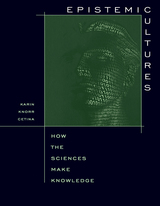 Epistemic Cultures: How the Sciences Make Knowledge
Karin Knorr Cetina
Harvard University Press, 1999 How does science create knowledge? Epistemic cultures, shaped by affinity, necessity, and historical coincidence, determine how we know what we know. In this book, Karin Knorr Cetina compares two of the most important and intriguing epistemic cultures of our day, those in high energy physics and molecular biology. Her work highlights the diversity of these cultures of knowing and, in its depiction of their differences--in the meaning of the empirical, the enactment of object relations, and the fashioning of social relations--challenges the accepted view of a unified science.
By many accounts, contemporary Western societies are becoming "knowledge societies"--which run on expert processes and expert systems epitomized by science and structured into all areas of social life. By looking at epistemic cultures in two sample cases, this book addresses pressing questions about how such expert systems and processes work, what principles inform their cognitive and procedural orientations, and whether their organization, structures, and operations can be extended to other forms of social order.
The first ethnographic study to systematically compare two different scientific laboratory cultures, this book sharpens our focus on epistemic cultures as the basis of the knowledge society.
Epistemic Logic: A Survey of the Logic of Knowledge
Nicholas Rescher
University of Pittsburgh Press, 2005
Epistemic logic is the branch of philosophical thought that seeks to formalize the discourse about knowledge. Its object is to articulate and clarify the general principles of reasoning about claims to and attributions of knowledge. This comprehensive survey of the topic offers the first systematic account of the subject as it has developed in the journal literature over recent decades.
Rescher gives an overview of the discipline by setting out the general principles for reasoning about such matters as propositional knowledge and interrogative knowledge. Aimed at graduate students and specialists, Epistemic Logic elucidates both Rescher's pragmatic view of knowledge and the field in general.
Epistemic Modality in Standard Spoken Tibetan: Epistemic Verbal Endings and Copulas
Zuzana Vokurková
Karolinum Press, 2017 The Sino-Tibetan language family is the second largest in the world, and standard Tibetan is the most widely spoken language in the Tibetic group. A comprehensive introduction to epistemicity in standard spoken Tibetan, this book examines the grammatical expression of a variety of epistemic modalities—rather, the myriad ways in which a speaker indicates their confidence in the knowledge on which their statement is based—through numerous examples of epistemic types. It elucidates the complex system of epistemic verbal endings and epistemic copulas, or connecting words, employed in the spoken language, analyzing them from semantic, syntactic, and pragmatic viewpoints.
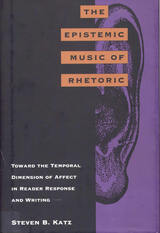 The Epistemic Music of Rhetoric: Toward the Temporal Dimension of Affect in Reader Response and Writing
Steven B. Katz
Southern Illinois University Press, 1996 Arguing for an oral theory of Reader Response Criticism, Steven B. Katz conducts a philosophical investigation into the possibility and desirability of teaching reading and writing as rhetorical music. In the course of this investigation, Katz deals with New Physics, the sophists, Cicero, orality, epistemology, voice, writing, temporality, and sound. He demonstrates that Reader Response Criticism—as part of a new sophistic that has entered the mainstream of pedagogy and practice in our culture—parallels the philosophy of science engendered by the Copenhagen school of New Physics, which theoretically holds that knowledge of subatomic phenomena is probable, relative, contingent, and uncertain, thus requiring more nonformalistic, nonrationalistic methods in understanding and reconstructing it; Katz shows how the same methods are required in the study of affect in reading and writing. Katz also demonstrates that, like New Physics, Reader Response Criticism, in its commitment to interpretation as the primary function and goal of writing about literature, must remain somewhat committed to the formalistic, rationalistic epistemology it seeks to redress. Basing his oral theory of Reader Response Criticism on notions of language as physical, sensuous, and musical and understanding reception as participatory performance rather that interpretation, Katz suggests a way to reconceptualize Reader Response Criticism. He accounts for "voice," "felt sense," "dissonance," and aesthetic response generally as it is created by the temporal, musical patterns of language, noting that the physical, musical dimension of language has been relatively neglected in contemporary movements in rhetoric, composition, and literature. Thus, set against the relationship between literature and science, especially between Reader Response Criticism and the philosophy of science engendered by New Physics, Katz examines the sophistic and Ciceronian conceptions of rhetoric. He reinterprets Cicero’s rhetorical theory in light of recent revisionist scholarship on the sophists and reevaluates his assigned position in rhetorical history as neo-Aristotelian by focusing on his oral notions of style as epistemic music. In so doing, Katz offers a new interpretation of Cicero within the sophistic tradition. Discussing the relationship between sophistic and Ciceronian conceptions of style as an oral, physical, nonrational, indirect form of knowledge and viewing philosophical conceptions of language as sensuous, temporal gestalten or "shapes" in consciousness, Katz suggests that response to and performance of the epistemic music of language can supplement analysis and interpretation in the teaching of reading and writing and can provide less formalistic, less rationalistic foundation for a reader response criticism as a new sophistic.
 Epistemic Practices and Plant Classification in Premodern European Botanical Knowledge: An Interdisciplinary Treatment
Fabrizio Baldassarri
Amsterdam University Press, 2025 This volume aims to uncover the diverse approach to plants in the Renaissance and seventeenth century that paved the way for a definition of botany as a fully-fledged discipline. Its scope expands beyond the natural historical interest in collections and the fabrication of materia medica: moving from Varchi, Matthioli and Bauhin to Locke, Pinelli, and Linnaeus, among others, the contributions collected here connect practical and theoretical features, dealing with the challenges that characterized any involvement with plants. The authors focus on the linguistic shortcomings, problems in authenticating specimens, and efforts to establish new botanical geographies to favour trades, as well as the pursuits of new methodologies, artisanal technologies, and chymical experiments with plants. Botany thus emerges as a suitable discipline to disclose the complexities and challenges of early modern science in general.
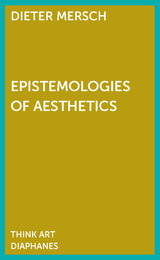 Epistemologies of Aesthetics
Dieter Mersch
Diaphanes, 2015 The ideas of “art as research” and ”research as art” have risen over the past two decades as important critical focuses for the philosophy of media, aesthetics, and art. Of particular interest is how the methodologies of art and science might be merged to create a better conceptual understanding of art-based research.
In Epistemologies of Aesthetics, Dieter Mersch deconstructs and displaces the terminology that typically accompanies the question of the relationship between art and scientific truth. Identifying artistic practices as modes of thought that do not make use of language in a way that can easily be translated into scientific discourse, Mersch advocate for an aesthetic mode of thought beyond the “linguistic turn,” a way of thinking that cannot be substituted by any other disciplinary system. A sophisticated reflection on the epistemological status of the aesthetic by one of Germany’s leading philosophers, Epistemologies of Aesthetics will be of great interest within this growing field of study.
 Epistemology and Cognition
Alvin I. Goldman
Harvard University Press, 1986 Whatever the target of our effort to know—whether we probe the origin of the cosmos, the fabric of man-made symbols and culture, or simply the layout of our immediate environment—all knowledge is grounded in natural cognitive capacities. Philosophers of knowledge must therefore make use of the science of cognition. So argues a leading epistemologist in this work of fundamental importance to philosophical thinking.
Against the traditional view, Alvin Goldman argues that logic, probability theory, and linguistic analysis cannot by themselves delineate principles of rationality or justified belief. The mind’s operations must be taken into account. Part I of his book lays the foundations of this view by addressing the major topics of epistemology: skepticism, knowledge, justification, and truth. Drawing parallels with ethical theory, it provides criteria for evaluating belief formation, problem solving, and probability judgment. Part II examines what cognitive scientists have learned about the basic processes of the mind-brain: perception, memory, representational constraints, internal codes, and so on. Looking at reliability, power, and speed, Goldman lays the groundwork for a balanced appraisal of the strengths and weaknesses of human mental processes.
In establishing a theoretical framework for the link between epistemology and cognitive science, Alvin Goldman does nothing less than redirect the entire field of study.
 Epistemology and Inference
Henry E. Kyburg, Jr.
University of Minnesota Press, 1983 Epistemology and Inference was first published in 1983. Minnesota Archive Editions uses digital technology to make long-unavailable books once again accessible, and are published unaltered from the original University of Minnesota Press editions. Henry Kyburg has developed an original and important perspective on probabilistic and statistical inference. Unlike much contemporary writing by philosophers on these topics, Kyburg's work is informed by issues that have arisen in statistical theory and practice as well as issues familiar to professional philosophers. In two major books and many articles, Kyberg has elaborated his technical proposals and explained their ramifications for epistemology, decision-making, and scientific inquiry. In this collection of published and unpublished essays, Kyburg presents his novel ideas and their applications in a manner that makes them accessible to philosophers and provides specialists in probability and induction with a concise exposition of his system.
The Epistemology of G. E. Moore
E. D. Klemke
Northwestern University Press, 1969 The Epistemology of G. E. Moore is an examination of the philosophy of G. E. Moore, one of the foremost Anglo-American, analytic philosophers of the twentieth century.This book, together with Reinhardt Grossmann’s Reflections on Frege’s Philosophy and Moltke Gram’s Kant, Ontology, and the A Priori, seeks to redress an imbalance in analytic philosophy by making a case for the relevance of analytically oriented historical studies to contemporary problems. It focuses on Moore’s epistemological writings and aims to present an exhaustive overview of Moore’s work on this topic.
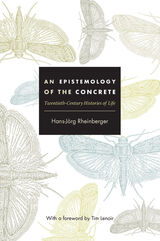 An Epistemology of the Concrete: Twentieth-Century Histories of Life
Hans-Jörg Rheinberger
Duke University Press, 2010 An Epistemology of the Concrete brings together case studies and theoretical reflections on the history and epistemology of the life sciences by Hans-Jörg Rheinberger, one of the world’s foremost philosophers of science. In these essays, he examines the history of experiments, concepts, model organisms, instruments, and the gamut of epistemological, institutional, political, and social factors that determine the actual course of the development of knowledge. Building on ideas from his influential book Toward a History of Epistemic Things, Rheinberger first considers ways of historicizing scientific knowledge, and then explores different configurations of genetic experimentation in the first half of the twentieth century and the interaction between apparatuses, experiments, and concept formation in molecular biology in the second half of the twentieth century. He delves into fundamental epistemological issues bearing on the relationship between instruments and objects of knowledge, laboratory preparations as a special class of epistemic objects, and the note-taking and write-up techniques used in research labs. He takes up topics ranging from the French “historical epistemologists” Gaston Bachelard and Georges Canguilhem to the liquid scintillation counter, a radioactivity measuring device that became a crucial tool for molecular biology and biomedicine in the 1960s and 1970s. Throughout An Epistemology of the Concrete, Rheinberger shows how assemblages—historical conjunctures—set the conditions for the emergence of epistemic novelty, and he conveys the fascination of scientific things: those organisms, spaces, apparatuses, and techniques that are transformed by research and that transform research in turn.
Epistle, Osprey
Geri Doran
Tupelo Press, 2019 In her third collection, Geri Doran continues to seek a quieter poem in a more natural form. Against the immediacy of troubled times, these poems retain a belief that long thought, solitude, restraint, and immersion in the world given to us (not made by us) are a means of passionate, even radical, devotion. And yet—what happens when a poet begins to doubt her singular reliance on poetry? When the only way to speak is in a language poised to evanesce? Modal, flexible, sonorous—the lines and tones of these meditative lyrics trace one route back.
 Epistle to Marguerite de Navarre and Preface to a Sermon by John Calvin
Marie Dentière
University of Chicago Press, 2004 Born to a noble family in Tournai, Marie Dentière (1495-1561) left her convent in the 1520s to work for religious reform. She married a former priest and with her husband went to Switzerland, where she was active in the Reformation's takeover of Geneva.
Dentière's Very Useful Epistle (1539) is the first explicit statement of reformed theology by a woman to appear in French. Addressed to Queen Marguerite of Navarre, sister of the French king Francis I, the Epistle asks the queen to help those persecuted for their religious beliefs. Dentière offers a stirring defense of women and asserts their right to teach the word of God in public. She defends John Calvin against his enemies and attacks the hierarchy of the Roman Catholic Church. Her Preface (1561) to one of Calvin's sermons criticizes immodesty and extravagance in clothing and warns the faithful to be vigilant. Undaunted in the face of suppression and ridicule, this outspoken woman persisted as an active voice in the Reformation.
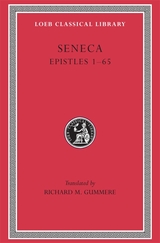 Epistles, Volume I: Epistles 1–65
Seneca
Harvard University Press Meditative missives.
Seneca, Lucius Annaeus, born at Corduba (Cordova) ca. 4 BC, of a prominent and wealthy family, spent an ailing childhood and youth at Rome in an aunt’s care. He became famous in rhetoric, philosophy, money-making, and imperial service. After some disgrace during Claudius’ reign he became tutor and then, in AD 54, advising minister to Nero, some of whose worst misdeeds he did not prevent. Involved (innocently?) in a conspiracy, he killed himself by order in 65. Wealthy, he preached indifference to wealth; evader of pain and death, he preached scorn of both; and there were other contrasts between practice and principle.
We have Seneca’s philosophical or moral essays (ten of them traditionally called Dialogues)—on providence, steadfastness, the happy life, anger, leisure, tranquility, the brevity of life, gift-giving, forgiveness—and treatises on natural phenomena. Also extant are 124 epistles, in which he writes in a relaxed style about moral and ethical questions, relating them to personal experiences; a skit on the official deification of Claudius, Apocolocyntosis (in LCL 15); and nine rhetorical tragedies on ancient Greek themes. Many epistles and all his speeches are lost.
The 124 epistles are collected in Volumes IV–VI of the Loeb Classical Library’s ten-volume edition of Seneca.
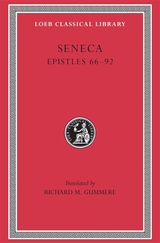 Epistles, Volume II: Epistles 66–92
Seneca
Harvard University Press Meditative missives.
Seneca, Lucius Annaeus, born at Corduba (Cordova) ca. 4 BC, of a prominent and wealthy family, spent an ailing childhood and youth at Rome in an aunt’s care. He became famous in rhetoric, philosophy, money-making, and imperial service. After some disgrace during Claudius’ reign he became tutor and then, in AD 54, advising minister to Nero, some of whose worst misdeeds he did not prevent. Involved (innocently?) in a conspiracy, he killed himself by order in 65. Wealthy, he preached indifference to wealth; evader of pain and death, he preached scorn of both; and there were other contrasts between practice and principle.
We have Seneca’s philosophical or moral essays (ten of them traditionally called Dialogues)—on providence, steadfastness, the happy life, anger, leisure, tranquility, the brevity of life, gift-giving, forgiveness—and treatises on natural phenomena. Also extant are 124 epistles, in which he writes in a relaxed style about moral and ethical questions, relating them to personal experiences; a skit on the official deification of Claudius, Apocolocyntosis (in LCL 15); and nine rhetorical tragedies on ancient Greek themes. Many epistles and all his speeches are lost.
The 124 epistles are collected in Volumes IV–VI of the Loeb Classical Library’s ten-volume edition of Seneca.
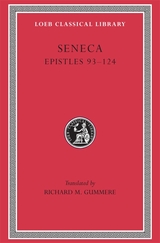 Epistles, Volume III: Epistles 93–124
Seneca
Harvard University Press Meditative missives.
Seneca, Lucius Annaeus, born at Corduba (Cordova) ca. 4 BC, of a prominent and wealthy family, spent an ailing childhood and youth at Rome in an aunt’s care. He became famous in rhetoric, philosophy, money-making, and imperial service. After some disgrace during Claudius’ reign he became tutor and then, in AD 54, advising minister to Nero, some of whose worst misdeeds he did not prevent. Involved (innocently?) in a conspiracy, he killed himself by order in 65. Wealthy, he preached indifference to wealth; evader of pain and death, he preached scorn of both; and there were other contrasts between practice and principle.
We have Seneca’s philosophical or moral essays (ten of them traditionally called Dialogues)—on providence, steadfastness, the happy life, anger, leisure, tranquility, the brevity of life, gift-giving, forgiveness—and treatises on natural phenomena. Also extant are 124 epistles, in which he writes in a relaxed style about moral and ethical questions, relating them to personal experiences; a skit on the official deification of Claudius, Apocolocyntosis (in LCL 15); and nine rhetorical tragedies on ancient Greek themes. Many epistles and all his speeches are lost.
The 124 epistles are collected in Volumes IV–VI of the Loeb Classical Library’s ten-volume edition of Seneca.
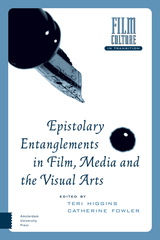 Epistolary Entanglements in Film, Media and the Visual Arts
Teri Higgins
Amsterdam University Press, 2023 This collection departs from the observation that online forms of communication—the email, blog, text message, tweet—are actually haunted by old epistolary forms: the letter and the diary. By examining the omnipresence of writing across a variety of media, the collection adds the category of Epistolary Screens to genres of self-expression, both literary (letters, diaries, auto-biographies) and screenic (romance dramas, intercultural cinema, essay films, artists’ videos and online media). The category Epistolary encapsulates an increasingly paradoxical relation between writing and the self: first, it describes selves that are written in graphic detail via letters, diaries, blogs, texts, emails and tweets; second, it acknowledges that absence complicates communication, bringing people together in an entangled rather than ordered way. The collection concerns itself with the changing visual/textual texture of screen media and examines what is at stake for our understanding of self-expression when it takes Epistolary forms.
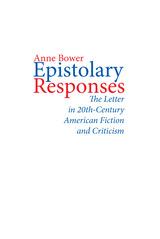 Epistolary Responses: The Letter in Twentieth-Century American Fiction and Criticism
Anne Bower
University of Alabama Press, 1996 Epistolary Responses explores the transformative nature of epistolary fiction and criticism in letter form from a largely feminist perspective. While most scholarly work to date has focused on 17th- and 18th-century manifestations of this genre, Bower's study concentrates on epistolary fiction by contemporary American writers published between 1912 and 1988. The novels discussed, all featuring women letter writers, include: Lee Smith's Fair and Tender Ladies, John Barth's LETTERS, Alice Walker's The Color Purple, John Updike's S., Jean Webster's Daddy-Long-Legs, Upton Sinclair's Another Pamela, and Ana Castillo's The Mixquiahuala Letters.
Bower explores the influence letters have on the act of writing and writing as act, their encoded desire for reply, their incompleteness as units of narrative information, their play on ideas of absence and presence, their apparently personal and private nature, and their foregrounding of the writer's agency and authority, all of which make letters a most useful genre both for novelists and for scholars. Several of the book's "fiction" chapters include a letter from the author of the text (sometimes a critic) that complements and supplements Bower's analysis. The final part of the book explores how seven scholars--men and women--have applied letters to their own critical writing, finding that this formal move allows them to question issues of public and private discourse, the authority of signature, and the "feminine" location.
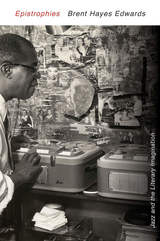 Epistrophies: Jazz and the Literary Imagination
Brent Hayes Edwards
Harvard University Press, 2017 In 1941 Thelonious Monk and Kenny Clarke copyrighted “Epistrophy,” one of the best-known compositions of the bebop era. The song’s title refers to a literary device—the repetition of a word or phrase at the end of successive clauses—that is echoed in the construction of the melody. Written two decades later, Amiri Baraka’s poem “Epistrophe” alludes slyly to Monk’s tune. Whether it is composers finding formal inspiration in verse or a poet invoking the sound of music, hearing across media is the source of innovation in black art.
Epistrophies explores this fertile interface through case studies in jazz literature—both writings informed by music and the surprisingly large body of writing by jazz musicians themselves. From James Weldon Johnson’s vernacular transcriptions to Sun Ra’s liner note poems, from Henry Threadgill’s arresting song titles to Nathaniel Mackey’s “Song of the Andoumboulou,” there is an unending back-and-forth between music that hovers at the edge of language and writing that strives for the propulsive energy and melodic contours of music.
At times this results in art that gravitates into multiple media. In Duke Ellington’s “social significance” suites, or in the striking parallels between Louis Armstrong’s inventiveness as a singer and trumpeter on the one hand and his idiosyncratic creativity as a letter writer and collagist on the other, one encounters an aesthetic that takes up both literature and music as components of a unique—and uniquely African American—sphere of art-making and performance.
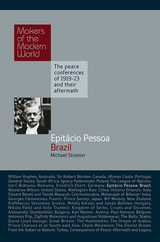 Epitacio Pessoa: Brazil
Michael Streeter
Haus Publishing, 2010 Brazil was one of the emerging world powers to be invited to the Paris Peace Conference in 1919. Having jettisoned her empire just thirty years before, the Portuguese-speaking nation was showed signs of becoming one of the financial powerhouses not just of Latin America, but of the world. Helped by abundant natural resources, cheap labour and large-scale immigration, Brazil’s economy had grown massively – and now it wanted to take its proper place in the society of world nations. In Paris, the country’s delegation was led by Epitacio Pessoa, a brilliant lawyer who had made his mark in national politics and was also a committed Europhile. It was a shrewd choice; helped by the Americans, Pessoa negotiated a deal to rescue Brazilian coffee from the German ports where it had languished since the middle of the war. He also helped win a place at the top table for Brazil in the new League of Nations. Pessoa was then rewarded by being elected president of Brazil – even though he was in Paris at the time. Yet even as Brazil enjoyed its moment of triumph on the international stage, the country’s political system was starting to unravel. Pessoa’s presidency ended in failure in 1922, its modest achievements overshadowed by bitter army revolts. And as Pessoa embarked on a new career as an international judge, his country slipped further into political infighting between elite oligarchies until the ageing republic finally folded in 1930. This, then, is the story of Epitacio Pessoa, the Treaty of Versailles and the rise and fall of Brazil’s tumultuous First Republic.
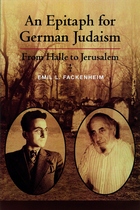 An Epitaph for German Judaism: From Halle to Jerusalem
Emil Fackenheim
University of Wisconsin Press, 2007 Emil Fackenheim’s life work was to call upon the world at large—and on philosophers, Christians, Jews, and Germans in particular—to confront the Holocaust as an unprecedented assault on the Jewish people, Judaism, and all humanity. In this memoir, to which he was making final revisions at the time of his death, Fackenheim looks back on his life, at the profound and painful circumstances that shaped him as a philosopher and a committed Jewish thinker. Interned for three months in the Sachsenhausen concentration camp after Kristallnacht, Fackenheim was released and escaped to Scotland and then to Canada, where he lived in a refugee internment camp before eventually becoming a congregational rabbi and then, for thirty-five years, a professor of philosophy. He recalls here what it meant to be a German Jew in North America, the desperate need to respond to the crisis in Europe and to cope with its overwhelming implications for Jewish identity and community. His second great turning point came in 1967, as he saw Jews threatened with another Holocaust, this time in Israel. This crisis led him on a pilgrimage to Jerusalem and ultimately back to Germany, where he continued to grapple with the question, How can the Jewish faith—and the Christian faith—exist after the Holocaust?
“An ‘epoch-making’ autobiography.”—Arnold Ages, Jewish Tribune
An Epitaph for Little Rock: A Fiftieth Anniversary Retrospective on the Central High Crisis
John A. Kirk
University of Arkansas Press, 2008 This collection of essays mines the Arkansas Historical Quarterly from the 1960s to the present to form a body of work that represents some of the finest scholarship on the crisis, from distinguished southern historians Numan V. Bartley, Neil R. McMillen, Tony A. Freyer, Roy Reed, David L. Chappell, Lorraine Gates Schuyler, John A. Kirk, Azza Salama Layton, and Ben F. Johnson III. A comprehensive array of topics are explored, including the state, regional, national, and international dimensions of the crisis as well as local white and black responses to events, gender issues, politics, and law. Introduced with an informative historiographical essay from John A. Kirk, An Epitaph for Little Rock is essential reading on this defining moment in America's civil rights struggle.
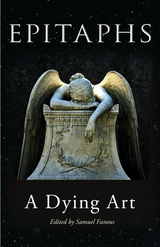 Epitaphs: A Dying Art
Edited by Samuel Fanous
Bodleian Library Publishing, 2016 Epitaphs are words to be remembered by, short poems or phrases literally written in stone. They can be practical, carrying some variation of the familiar “Here Lies,” but they can also be brilliantly creative with personally meaningful quotes or words written especially by or for the deceased. From the simple to the cleverly cryptic, epitaphs are meant to leave a lasting impression—and many certainly do.
Epitaphs brings together more than 250 epitaphs from cemeteries, churchyards, monuments, and historical records. Some announce the cause of death with a surprisingly macabre sense of humor: “Here lies John Ross. Kicked by a hoss.” Others wryly remind readers of their own impending mortality, such as a tombstone whose rhyming inscription reads “As I am now you will surely be. / Prepare thyself to follow me.” In death as in life, many of the most famous writers were not at a loss for words. Emily Dickinson’s concise wit is evident in her headstone’s inscription “Called Back.” Yeats encouraged the horsemen of the apocalypse to “pass by.” Shakespeare’s funerary monument at Stratford-upon-Avon carries the warning “Curst be he that moves my bones,” an inscription many believe the Bard himself wrote to prevent his corpse from being exhumed in the name of research, a common practice at the time.
As tribute to a form of expression that is very much alive, Epitaphs collects some of the most intriguing examples, many of which perfectly encapsulate the person buried beneath them.
Epithalamia
Erinn Batykefer
Autumn House Press, 2019 Inhabiting the claustrophobia of marriage and domestic life, Erinn Batykefer’s poems use the deeply personal as the lens through which she investigates larger cultural ideas. She reckons with feeling simultaneously large and small, finding ways to face herself, and the need to be seen while within the confines of intimate relationships. Honest and explorative, these poems lead us through moments of fluctuation and faltering.
 Epitome of Pompeius Trogus, Volume I: Books 1–20
Justin
Harvard University Press, 2024 A condensed Roman history of non-Roman civilizations.
To Justin (Marcus Junian(i)us Justinus), otherwise unknown, is attributed our abbreviated version of the lost Philippic History by (Gnaeus?) Pompeius Trogus, a massive account, in forty-four books, of the non-Roman world and its civilizations, from mythic beginnings through Alexander the Great, the Hellenistic kingdoms, and Parthia. Trogus’ work thus complemented the monumental history of Rome by his Augustan contemporary, Livy, and in high style traced similar moral themes: rulers and states that lack such virtues as moderation, justice, and piety bring harm or ruin on themselves, and often on their realms as well.
Justin, working at some time in the late second to the late fourth century AD, did not produce a strict epitome or summary but what he calls “a brief anthology”: not unlike Florus (LCL 231), who used Livy’s history as the primary source for a brief but original military history of Rome, Justin freely selected what suited his own purposes, favoring “what makes pleasurable reading or serves to provide a moral,” with an eye to the kind of emotive anecdotes that might be useful to orators. He also blends Trogus’ language with borrowings from literature of subsequent generations. Justin’s anthology became one of the most widely read and influential books in the Middle Ages and Renaissance, indeed the main authority on world history other than Roman, surviving in more than 200 manuscripts.
Also included in this edition are the “Prologues,” summaries of Trogus by some other compiler, which preserve many details that Justin omits or reports differently.
 Epitome of Pompeius Trogus, Volume II: Books 21–44
Justin
Harvard University Press, 2024 A condensed Roman history of non-Roman civilizations.
To Justin (Marcus Junian(i)us Justinus), otherwise unknown, is attributed our abbreviated version of the lost Philippic History by (Gnaeus?) Pompeius Trogus, a massive account, in forty-four books, of the non-Roman world and its civilizations, from mythic beginnings through Alexander the Great, the Hellenistic kingdoms, and Parthia. Trogus’ work thus complemented the monumental history of Rome by his Augustan contemporary, Livy, and in high style traced similar moral themes: rulers and states that lack such virtues as moderation, justice, and piety bring harm or ruin on themselves, and often on their realms as well.
Justin, working at some time in the late second to the late fourth century AD, did not produce a strict epitome or summary but what he calls “a brief anthology”: not unlike Florus (LCL 231), who used Livy’s history as the primary source for a brief but original military history of Rome, Justin freely selected what suited his own purposes, favoring “what makes pleasurable reading or serves to provide a moral,” with an eye to the kind of emotive anecdotes that might be useful to orators. He also blends Trogus’ language with borrowings from literature of subsequent generations. Justin’s anthology became one of the most widely read and influential books in the Middle Ages and Renaissance, indeed the main authority on world history other than Roman, surviving in more than 200 manuscripts.
Also included in this edition are the “Prologues,” summaries of Trogus by some other compiler, which preserve many details that Justin omits or reports differently.
Epitome of Roman History
Florus
Harvard University Press A very short introduction to Roman history.
Florus, born apparently in Africa, lived in Spain and in Rome during Hadrian’s time. He wrote, in succinct rhetorical style, a summary of Roman history (especially wars) in two books in order to show the early greatness and subsequent decline of Roman morals. It is based chiefly on Livy. Florus’ Epitome was perhaps planned to reach his own times, but the extant work ends with Augustus’ reign. Florus provides a useful rapid sketch of Roman military history.
Poetry by Florus is also available in the Loeb Classical Library, in Volume II of Minor Latin Poets (LCL 434).
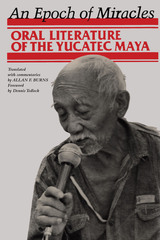 An Epoch of Miracles: Oral Literature of the Yucatec Maya
Translated with Commentaries by Allan F. Burns
University of Texas Press, 1983 “Mr. Allan Burns, I am here to tell you an example, the example of the Hunchbacks.” So said Paulino Yamá, traditionalist and storyteller, to Allan Burns, anthropologist and linguist, as he began one story that found its way into this book. Paulino Yamá was just one of several master storytellers from the Yucatán Peninsula of Mexico from whom Burns learned not only the Mayan language but also the style and performance of myths, stories, riddles, prayers, and other forms of speech of their people. The result is An Epoch of Miracles, a wonderfully readable yet thoroughly scholarly set of translations from the oral literature of the Yucatec Maya, an important New World tradition never before systematically described. An Epoch of Miracles brings us over thirty-five long narratives of things large, small, strange, and “regular” and as many delightful short pieces, such as bird lore, riddles, and definitions of anteaters, rainbows, and other commonplaces of the Mayan world. Here are profound narratives of the Feathered Serpent, the mighty Rain God Chac and his helpers, and the mysterious cult of the Speaking Cross. But because these are modern, “Petroleum Age” Maya, here too are a discussion with Cuba’s Fidel Castro and a greeting to former president Richard Nixon. All pieces are translated ethnopoetically; examples of several genres are presented bilingually. An especially valuable feature is the indication of performance style, such as pauses and voice quality, given with each piece.
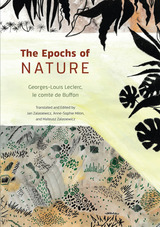 The Epochs of Nature
Georges-Louis Leclerc, le comte de Buffon
University of Chicago Press, 2018 Georges-Louis Leclerc, le comte de Buffon's The Epochs of Nature, originally published as Les Époques de la Nature in 1778, is one of the first great popular science books, a work of style and insight that was devoured by Catherine the Great of Russia and influenced Humboldt, Darwin, Lyell, Vernadsky, and many other renowned scientists. It is the first geological history of the world, stretching from the Earth’s origins to its foreseen end, and though Buffon was limited by the scientific knowledge of his era—the substance of the Earth was not, as he asserts, dragged out of the sun by a giant comet, nor is the sun’s heat generated by tidal forces—many of his deductions appear today as startling insights. And yet, The Epochs of Nature has never before been available in its entirety in English—until now.
In seven epochs, Buffon reveals the main features of an evolving Earth, from its hard rock substrate to the sedimentary layers on top, from the minerals and fossils found within these layers to volcanoes, earthquakes, and rises and falls in sea level—and he even touches on age-old mysteries like why the sun shines. In one of many moments of striking scientific prescience, Buffon details evidence for species extinction a generation before Cuvier’s more famous assertion of the phenomenon. His seventh and final epoch does nothing less than offer the first geological glimpse of the idea that humans are altering the very foundations of the Earth—an idea of remarkable resonance as we debate the designation of another epoch: the Anthropocene. Also featuring Buffon’s extensive “Notes Justificatives,” in which he offers further evidence to support his assertions (and discusses vanished monstrous North American beasts—what we know as mastodons—as well as the potential existence of human giants), plus an enlightening introduction by editor and translator Jan Zalasiewicz and historians of science Sverker Sörlin, Libby Robin, and Jacques Grinevald, this extraordinary new translation revives Buffon’s quite literally groundbreaking work for a new age.
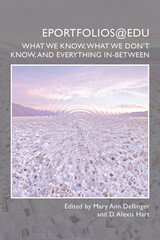 ePortfolios@edu: What We Know, What We Don’t Know, and Everything In-Between
Mary Ann Dellinger
University Press of Colorado, 2021 This edited collection offers a comprehensive examination of best practices in creating, implementing, and assessing an ePortfolio program. Contributors to the volume (ePortfolio practitioners/scholars from four continents) share triumphs and lessons learned from a first-person perspective. Designed as a go-to resource for ePortfolio novices, seasoned practitioners, and curious explorers alike, ePortfolios@edu allows readers to close the book and immediately apply whatever information they found most appropriate for their course, program, or institution. To that end, contributors embed screenshots and diagrams within their essays and addend their chapters with relevant timelines, prompts, rubrics, and other ready-for-use materials. Reflecting the emblematic interconnectedness of ePortfolio development, ePortfolios@edu complements other publications on ePortfolios by offering new perspectives and a collection of resources that will be of great value to the expanding network of ePortfolio practitioners/scholars. This book is also available as an open access ebook through the WAC Clearinghouse.
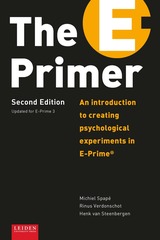 The E-Primer: An Introduction to Creating Psychological Experiments in E-Prime®
Michiel Verdonschot
Leiden University Press, 2019 "E-Prime® is the leading software suite by Psychology Software Tools for designing and running Psychology lab experiments. The E-Primer is the perfect accompanying guide: It provides all the necessary knowledge to make E-Prime accessible to everyone. You can learn the tools of Psychological science by following the E-Primer through a series of entertaining, step-by-step recipes that recreate classic experiments. The updated E-Primer expands its proven combination of simple explanations, interesting tutorials and fun exercises, and makes even the novice student quickly confident to create their dream experiment. Featuring: * Learn the basic and advanced features of E-Studio’s flexible user interface * 15 step-by-step tutorials let you replicate classic experiments from all Psychology fields * Learn to write custom code in E-Basic without having any previous experience in programming * Second edition completely revised for E-Prime 3 * Based on 10+ years of teaching E-Prime to undergraduates, postgraduates, and colleagues * Used by Psychology Software Tools to train their own staff!"
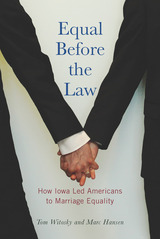 Equal Before the Law: How Iowa Led Americans to Marriage Equality
Tom Witosky, Marc Hansen
University of Iowa Press, 2015 “We’ve been together in sickness and in health, through the death of his mother, through the adoption of our children, through four long years of this legal battle,” Jason Morgan told reporters of himself and his partner, Chuck Swaggerty. “And if being together through all of that isn’t love and commitment or isn’t family or isn’t marriage, then I don’t know what is.” Just minutes earlier on that day, April 3, 2009, the justices of the Iowa Supreme Court had agreed.
The court’s decision in Varnum v. Brien made Iowa only the third state in the nation to permit same-sex couples to wed—moderate, midwestern Iowa, years before such left-leaning coastal states as California and New York. And unlike the earlier decisions in Massachusetts and Connecticut, Varnum v. Brien was unanimous and unequivocal. It catalyzed the unprecedented and rapid shift in law and public opinion that continues today.
Equal Before the Law tells the stories behind this critical battle in the fight for marriage equality and traces the decision’s impact. The struggle began in 1998 with the easy passage of Iowa’s Defense of Marriage Act and took a turn, surprising to many, in 2005, when six ordinary Iowa couples signed on to Lambda Legal’s suit against the law. Their triumph in 2009 sparked a conservative backlash against the supreme court justices, three of whom faced tough retention elections that fall.
Longtime, award-winning reporters Tom Witosky and Marc Hansen talked with and researched dozens of key figures, including opponent Bob Vander Plaats, proponents Janelle Rettig and Sharon Malheiro, attorneys Roger Kuhle, Dennis Johnson, and Camilla Taylor, and politicians Matt McCoy, Mary Lundby, and Tom Vilsack, who had to weigh their careers against their convictions. Justice Mark Cady, who wrote the decision, explains why the court had to rule in favor of the plaintiffs. At the center of the story are the six couples who sacrificed their privacy to demand public respect for their families.
Through these voices, Witosky and Hansen show that no one should have been surprised by the 2009 decision. Iowans have a long history of leadership on civil rights. Just a year after Iowa became a state, its citizens adopted as their motto the phrase, “Our liberties we prize and our rights we will maintain.” And they still do today.
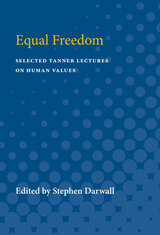 Equal Freedom
Stephen Darwall, Editor
University of Michigan Press, 1995 "Egalitarian" and "libertarian" are frequently seen as opposing political labels. These two views and their oppositions are the topic of this collection of important essays by an exceptionally distinguished group of thinkers.This collection of essays can be read as a critique of libertarianism. A libertarian, in contemporary discussion, is one who supports no more than a minimal state--a government that protects individuals from assault, murder, theft, and other invasions of their "Lockean" rights, but otherwise does not interfere with voluntary economic or personal activity. "Egalitarian," on the other hand, generally refers to someone who is prepared to favor such interference if it is necessary to reduce substantial inequalities of certain kinds and if, perhaps, it is democratically authorized.Several of the essays, those of John Rawls, T. M. Scanlon, G. A. Cohen, and Ronald Dworkin, advance different versions of this liberal egalitarian line of argument. Each maintains that the ideas of freedom and equality enter into moral and political philosophy at a more fundamental level than the substantive, rights-determining norms on which libertarianism makes its stand. Each proposes a distinctive vision of this fundamental role. And each argues, on this basis, for egalitarian moral or political principles. Amartya Sen's essay can also be placed within a broadly liberal egalitarian tradition, although it is less an argument for substantive equality (and against libertarianism) than a discussion of what form a reasonable egalitarianism might take. Finally, Quentin Skinner directly criticizes libertarianism in ways that arguably tend to support egalitarianism, although this is not his primary aim.This book offers deep thinking across one of the main fissures of current political debate. It will thus be of interest to all with a serious interest in the fundamentals of political beliefs and action.
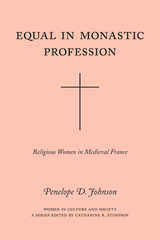 Equal in Monastic Profession: Religious Women in Medieval France
Penelope D. Johnson
University of Chicago Press, 1991 In this study of the manner in which medieval nuns lived, Penelope Johnson challenges facile stereotypes of nuns living passively under monastic rule, finding instead that collectively they were empowered by their communal privileges and status to think and act without many of the subordinate attitudes of secular women. In the words of one abbess comparing nuns with monks, they were "different as to their sex but equal in their monastic profession."
Johnson researched more than two dozen nunneries in northern France from the eleventh century through the thirteenth century, balancing a qualitative reading of medieval monastic documents with a quantitative analysis of a lengthy thirteenth-century visitation record which allows an important comparison of nuns and monks. A fascinating look at the world of medieval spirituality, this work enriches our understanding of women's role in premodern Europe and in church history.
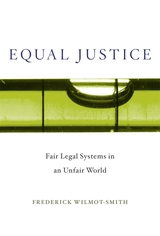 Equal Justice: Fair Legal Systems in an Unfair World
Frederick Wilmot-Smith
Harvard University Press, 2019 A philosophical and legal argument for equal access to good lawyers and other legal resources.
Should your risk of wrongful conviction depend on your wealth? We wouldn’t dream of passing a law to that effect, but our legal system, which permits the rich to buy the best lawyers, enables wealth to affect legal outcomes. Clearly justice depends not only on the substance of laws but also on the system that administers them.
In Equal Justice, Frederick Wilmot-Smith offers an account of a topic neglected in theory and undermined in practice: justice in legal institutions. He argues that the benefits and burdens of legal systems should be shared equally and that divergences from equality must issue from a fair procedure. He also considers how the ideal of equal justice might be made a reality. Least controversially, legal resources must sometimes be granted to those who cannot afford them. More radically, we may need to rethink the centrality of the market to legal systems. Markets in legal resources entrench pre-existing inequalities, allocate injustice to those without means, and enable the rich to escape the law’s demands. None of this can be justified. Many people think that markets in health care are unjust; it may be time to think of legal services in the same way.
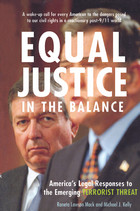 Equal Justice in the Balance: America's Legal Responses to the Emerging Terrorist Threat
Raneta Lawson Mack and Michael J. Kelly
University of Michigan Press, 2004 "We are in difficult times for the protection of our liberties. Nonetheless, citizens are showing an increased willingness to resist the erosion of the U.S. Constitution. . . . Lawson Mack and Kelly stress the importance of not giving up these fundamental rights and conclude with a message of optimism, noting an increased backlash against the administration's more draconian measures. Although the landscape is still quite bleak, change is in the air."
-Michael Ratner, President, Center for Constitutional Rights, from the foreword
"A compelling and sophisticated critique of the U.S. government's post-9/11 actions. Mack and Kelly set the stage with the historical perspective on America's response to terrorism and the assessment of terrorist threats, before launching into a comprehensive analysis of the USA Patriot Act. Their hard-hitting approach and easy-to-read style makes for a fascinating treatment of the government's legislative and executive response to the attacks."
-Michael P. Scharf, Case Western Reserve University School of Law
With its sweeping critique of the USA Patriot Act and the Bush administration's maneuvers in pursuit of terrorists, Equal Justice in the Balance is a sobering and exacting look at American legal responses to terrorism, both before and after 9/11.
The authors detail wide-ranging and persuasive evidence that American antiterrorism legislation has led to serious infringements of our civil rights. They show us how deviations from our fundamental principles of fairness and justice in times of heightened national anxiety-whether the Red Scare, World War II, or the War on Terrorism-have resulted in overreaction and excess, later requiring apologies and reparations to those victimized by a paranoia-driven justice system.
While terrorist attacks-especially on a large scale and on American soil-damage our national pride and sense of security, the authors offer powerful arguments for why we must allow our judicial infrastructure, imperfect as it is, to respond without undue interference from the politics of anger and vengeance.
Equal Opportunities and Ethnic Inequality in European Labour Markets: Discrimination, Gender and Policies of Diversity
Edited by Karen Kraal, Judith Roosblad, and John Wrench
Amsterdam University Press, 2009
Despite laws and policy measures being developed at the European, national, and local levels, job-seeking immigrants and ethnic minorities still suffer unequal access and ethnic discrimination. This important volume—divided into sections on discrimination, gender, equity policies, and diversity management—compares several European labor markets, recommends methods for conducting further research, and evaluates the actual effects of discrimination-combating policies.
 Equal Play: Title IX and Social Change
Nancy Hogshead-Makar
Temple University Press, 2007 One of the least-understood issues in federal sports policy, Title IX of the Educational Amendments of 1972 reflects the nation's aspirational belief that girls and boys, women and men, deserve equal educational opportunities in athletics. Equal Play shows how this ideal has been implemented-and thwarted-by actions in every branch of the federal government. This reader addresses issues in sports before Title IX and the backlash that has resulted from the policy being instituted. The editors have collected the best scholarly writing on the landmark events of the last four decades and couples these with new original essays, primary documents from court cases, administrative regulations, and relevant supporting sources. The result is the most comprehensive single-volume work on the subject. Equal Play includes essays by many well-known sports journalists who discuss how government actions have shaped, supported, and hindered the goal of gender equality in school athletics. They discuss the history of women in sports, analyze the meaning of "equal opportunity" for female athletes, and examine shifts in arguments for and against Title IX. Equal Play will interest anyone who is concerned with gender issues in American athletics and the growth of college sports. Contributors include: Susan Cahn, Donna de Varona, Julie Foudy, Jessica Gavora, Bil Gilbert, Christine Grant, Mariah Burton Nelson, Gary R. Roberts, Don Sabo, Larry Schwartz, Michael Sokolove, Welch Suggs, Nancy Williamson, and the editors.
 An Equal Share of Freedom: American Jews, Zionism, and World War I
Edited by Mark Raider, Zohar Segev, and Gary Phillip Zola
University of Minnesota Press, 2024 Essays illustrating the American Jewish experience during World War I.
An Equal Share of Freedom sheds new light on several important and interrelated dimensions of American, Jewish, and world history in the World War I era. Paying close attention to the Balfour Declaration as a hub around which to explore the period’s unfolding and turbulent social, cultural, and political developments, this collection of essays covers a diverse range of topics including Jewish doughboys, Zionist women authors, and political elites such as Golda Meir and Woodrow Wilson. The volume demonstrates the complex nature of Jewish ethnonational consciousness in the American setting and the impact of Zionism on US wartime and postwar activity.
The essays in this volume overturn timeworn assumptions that have long shaped the fields of American history and modern Jewish history. Taken as a whole, they demonstrate the war’s profound impact on American Jewish life and the transformation of American Jewry’s relationship with wider American society. These essays also illustrate the centrality of Zionism to the American Jewish experience and the extent to which American Jewry’s national consciousness and the future direction of the Zionist project were forged in the crucible of the Great War. An Equal Share of Freedom is the first volume in the Jacob Rader Marcus Series on the American Jewish Experience. In this series, Raider, Segev, and Zola highlight the myriad possibilities for expanding and deepening scholarly understanding of American Jews and the shared history of American society and the Jewish people in the twentieth century, starting with a look at World War I.
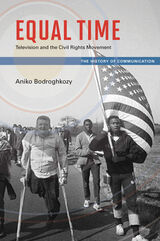 Equal Time: Television and the Civil Rights Movement
Aniko Bodroghkozy
University of Illinois Press, 2013 Equal Time: Television and the Civil Rights Movement explores the crucial role of network television in reconfiguring new attitudes in race relations during the civil rights movement. Due to widespread coverage, the civil rights revolution quickly became the United States' first televised major domestic news story. This important medium unmistakably influenced the ongoing movement for African American empowerment, desegregation, and equality. Aniko Bodroghkozy brings to the foreground network news treatment of now-famous civil rights events including the 1965 Selma voting rights campaign, integration riots at the University of Mississippi, and the March on Washington, including Martin Luther King's "I Have a Dream" speech. She also examines the most high-profile and controversial television series of the era to feature African American actors--East Side/West Side, Julia, and Good Times--to reveal how entertainment programmers sought to represent a rapidly shifting consensus on what "blackness" and "whiteness" meant and how they now fit together.
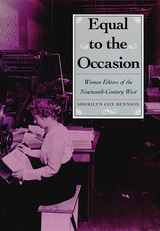 Equal To The Occasion: Women Editors On The Nineteenth-Century West
Sherilyn Cox Bennion
University of Nevada Press, 1990 Bennion provides in-depth portraits of nineteenth-century women editors of the West and their diverse publications. The book's title takes its name from an 1898 editorial in the Wasatch Wave which described Piute Pioneer editor Candace Alice De Witt as a "maiden fair, fully equal to the occasion."Equal to the Occasion delves into the lives, publications, and historical contexts in which approximately thirty-five female editors of newspapers and other periodicals worked in the nineteenth-century West. The book covers the period from 1854, when the West's first woman editor began her work, through the turn of the century; it includes research gathered from thirteen western states. With its in-depth portraits of pioneering women editors and its appendix listing more than two hundred women and the major repositories where their extant publications are kept, Equal to the Occasion rescues from obscurity a whole panoply of nineteenth-century western women.
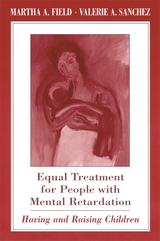 Equal Treatment for People with Mental Retardation: Having and Raising Children
Martha A. Field and Valerie A. Sanchez
Harvard University Press, 2001 Engaging in sex, becoming parents, raising children: these are among the most personal decisions we make, and for people with mental retardation, these decisions are consistently challenged, regulated, and outlawed. This book is a comprehensive study of the American legal doctrines and social policies, past and present, that have governed procreation and parenting by persons with mental retardation. It argues persuasively that people with retardation should have legal authority to make their own decisions.
Despite the progress of the normalization movement, which has moved so many people with mental retardation into the mainstream since the 1960s, negative myths about reproduction and child rearing among this population persist. Martha Field and Valerie Sanchez trace these prejudices to the eugenics movement of the late nineteenth and early twentieth centuries. They show how misperceptions have led to inconsistent and discriminatory outcomes when third parties seek to make birth control or parenting decisions for people with mental retardation. They also explore the effect of these decisions on those they purport to protect. Detailed, thorough, and just, their book is a sustained argument for reform of the legal practices and social policies it describes.
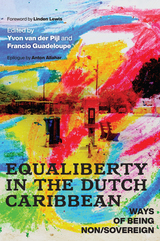 Equaliberty in the Dutch Caribbean: Ways of Being Non/Sovereign
Yvon van der Pijl
Rutgers University Press, 2022 Equaliberty in the Dutch Caribbean is a collection of essays that explores fundamental questions of equality and freedom on the non-sovereign islands of the Dutch Caribbean. Drawing on in-depth ethnographic research, historical and media analysis, the study of popular culture, and autoethnographic accounts, the various contributions challenge conventional assumptions about political non/sovereignty. While the book recognizes the existence of nationalist independence movements, it opens a critical space to look at other forms of political articulation, autonomy, liberty, and a good life. Focusing on all six different islands and through a multitude of voices and stories, the volume engages with the everyday projects, ordinary imaginaries, and dreams of equaliberty alongside the work of independistas and traditional social movements aiming for more or full self-determination. As such, it offers a rich and powerful telling of the various ways of being in and belonging to our contemporary postcolonial world.
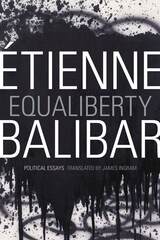 Equaliberty: Political Essays
Étienne Balibar
Duke University Press, 2014 First published in French in 2010, Equaliberty brings together essays by Étienne Balibar, one of the preeminent political theorists of our time. The book is organized around equaliberty, a term coined by Balibar to connote the tension between the two ideals of modern democracy: equality (social rights and political representation) and liberty (the freedom citizens have to contest the social contract). He finds the tension between these different kinds of rights to be ingrained in the constitution of the modern nation-state and the contemporary welfare state. At the same time, he seeks to keep rights discourse open, eschewing natural entitlements in favor of a deterritorialized citizenship that could be expanded and invented anew in the age of globalization. Deeply engaged with other thinkers, including Arendt, Rancière, and Laclau, he posits a theory of the polity based on social relations. In Equaliberty Balibar brings both the continental and analytic philosophical traditions to bear on the conflicted relations between humanity and citizenship.
 Equalities
Douglas Rae
Harvard University Press, 1981 Equality has always been the most powerful political idea in America, and it is becoming the most powerful idea in the world. Observers from Alexis de Tocqueville to the most recent social critics have commented upon the idea's great force. Yet, for all its influence upon popular ideology, the idea of equality becomes a bundle of contradictory impulses once it is applied to public policy and social institutions. As the title of this lively book suggests, equality becomes equalities.
Once inequality is established, there is a deep difference between equal policies and policies that lead to equality. Once people have different needs, there is a sharp difference between treating them equally and treating them in ways that serve them equally. Once people have unequal (or unequally developed) talents, then equal opportunity cannot mean both equal opportunity and an equal prospect of success. Once society is cleaved by differences of race, sex, income, and so on, there is an intense difference between policies and reforms that reduce racial, sexual, and economic inequality and policies that diminish equality among persons. Douglas Rae and his colleagues develop an ingenious “grammar of equality” to explain and explicate the main ways in which equality turns into equalities as it passes from the realm of ideas to the realm of practice.
The book's exciting new method of analysis, based on logic and theories of political economy and political science, is a valuable contribution. Equalities helps us answer such questions as: “Is equality possible?” “How, after so long a period of ostensible egalitarianism, can inequality still dominate so much of the social landscape?” The responses are bound to stir controversy among all those interested in political theory or in social policy or in the attainment of equality.
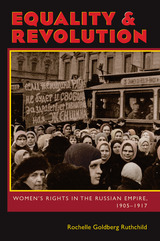 Equality and Revolution: Women’s Rights in the Russian Empire, 1905–1917
Rochelle Goldberg Ruthchild
University of Pittsburgh Press, 2010 On July 20, 1917, Russia became the world’s first major power to grant women the right to vote and hold public office. Yet in the wake of the October Revolution later that year, the foundational organizations and individuals who pioneered the suffragist cause were all but erased from Russian history. The women’s movement, when mentioned at all, is portrayed as meaningless to proletariat and peasant women, based in elitist and bourgeoisie culture of the tsarist era, and counter to socialist ideology. In this groundbreaking book, Rochelle Goldberg Ruthchild reveals that Russian feminists in fact appealed to all classes and were an integral force for revolution and social change, particularly during the monumental uprisings of 1905–1917.
Ruthchild offers a telling examination of the dynamics present in imperialist Russia that fostered a growing feminist movement. Based upon extensive archival research in six countries, she analyzes the backgrounds, motivations, methods, activism, and organizational networks of early Russian feminists, revealing the foundations of a powerful feminist intelligentsia that came to challenge, and eventually bring down, the patriarchal tsarist regime.
Ruthchild profiles the individual women (and a few men) who were vital to the feminist struggle, as well as the major conferences, publications, and organizations that promoted the cause. She documents political party debates on the acceptance of women’s suffrage and rights, and follows each party’s attempt to woo feminist constituencies despite their fear of women gaining too much political power. Ruthchild also compares and contrasts the Russian movement to those in Britain, China, Germany, France, and the United States. Equality and Revolution offers an original and revisionist study of the struggle for women’s political rights in late imperial Russia, and presents a significant reinterpretation of a decisive period of Russian—and world—history.
 Equality, Decadence, and Modernity: The Collected Essays of Stephen J. Tonsor
Gregory L. Schneider
Intercollegiate Studies Institute, 2005 Over the course of the past four decades Stephen J. Tonsor, professor emeritus of European intellectual history at the University of Michigan, has made a reputation within the conservative intellectual movement as a trenchant thinker, forceful writer, and witty, sometimes caustic, lecturer. But without a book to introduce his thought to the wider public, Tonsor has remained largely unknown outside conservative circles. For many readers, then, this generous collection, edited by historian Gregory Schneider, will serve as an enlightening introduction to the work of a man who is among the most penetrating of conservative thinkers. Equality, Decadence, and Modernity features substantial excerpts from Tonsor?s two book-length unpublished manuscripts, "Decadence" and "Equality," as well as insightful essays on conservative thought and politics. Among other pieces, this volume includes Tonsor?s controversial polemic, "Why I Too Am Not a Neoconservative." "Halfway from modernity is not far enough" , asserted Tonsor in this essay. Yet Tonsor?s critique of modernity, and much else, is complex and always intelligent. With the publication of Equality, Decadence, and Modernity, readers may now share in, and profit from, that intelligence.
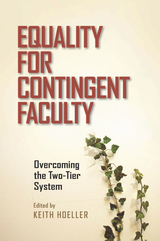 Equality for Contingent Faculty: Overcoming the Two-Tier System
Keith Hoeller
Vanderbilt University Press, 2014 Vice President Joseph Biden has blamed tuition increases on the high salaries of college professors, seemingly unaware of the fact that there are now over one million faculty who earn poverty-level wages teaching off the tenure track. The Chronicle of Higher Education ran a story entitled "From Graduate School to Welfare: The PhD Now Comes with Food Stamps." Today three-fourths of all faculty are characterized as "contingent instructional staff," a nearly tenfold increase from 1975.
Equality for Contingent Faculty brings together eleven activists from the United States and Canada to describe the problem, share case histories, and offer concrete solutions. The book begins with three accounts of successful organizing efforts within the two-track system. The second part describes how the two-track system divides the faculty into haves and have-nots and leaves the majority without the benefit of academic freedom or the support of their institutions. The third part offers roadmaps for overcoming the deficiencies of the two-track system and providing equality for all professors, regardless of status or rank.
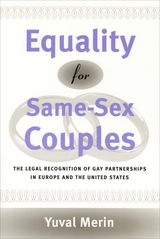 Equality for Same-Sex Couples: The Legal Recognition of Gay Partnerships in Europe and the United States
Yuval Merin
University of Chicago Press, 2002 During the past three decades, nations all over the world have been debating whether to allow same-sex couples to marry, or at least grant these couples various rights associated with marriage. In Equality for Same-Sex Couples, Yuval Merin presents the first comparative study of the legal regulation of same-sex partnerships worldwide, as well as a unique survey of the status of same-sex couples in Europe.
Merin begins by providing a historical overview of the transformation of marriage from antiquity to the present. He then identifies and critically compares four principal models for the legal regulation and recognition of same-sex partnerships: civil marriage, registered partnership, domestic partnership, and cohabitation. Merin concludes that all of the models except civil marriage discriminate against gays and lesbians just as the "separate but equal" doctrine discriminated against African Americans; thus, so-called alternatives to marriage, even if they provide the same rights and benefits as marriage, are inherently unequal and therefore unconstitutional.
 Equality in America: The View from the Top
Sidney Verba and Gary R. Orren
Harvard University Press, 1985 A model of meticulous and incisive scholarship, Equality in America dissects American attitudes toward equality by placing those beliefs in historical context and demonstrating a relationship between political and economic equality. The book is based on a study of leaders from all significant sectors of American society, including top business and labor leaders, those highest in the media and in political parties, and leaders from the feminist and civil rights movements.
The book takes on the thorny puzzle of how economic inequality, which is the inevitable result of a free economy, coexists with political equality, which is a necessary ingredient of democracy. In the course of their argument, the authors take issue with free market economists and Marxist analysts, both of whom treat self-interest as the driving force behind individual and collective behavior, leaving little place for the role of beliefs and values.
Equality in the City: Imaginaries of the Smart Future
Edited by Susan Flynn and Graham Cairns
Intellect Books, 2022 A compelling critique of “smart city” rhetoric.
Equality in the City engenders a timely debate about what future cities might look like and what their concerns should be. Using a multi-disciplinary perspective, it features acclaimed scholars whose work investigates the proposed networked, digital technologies that ostensibly affect planning policies, control infrastructures, and deliver and manage city services and systems. The contributors offer insights into how future cities might be envisaged, planned, and executed in order to be more equal.
Equality in the Nordic World
Carsten Jensen
University of Wisconsin Press, 2021 By most measures, the Nordic countries regularly rank among the best in terms of equality and business friendliness. Political scientist Carsten Jensen delves into what is exceptional about equality in the region, and outlines “the four equalities” that set it apart: economic, intergenerational, gender, and health.
The four types of equality have their origins in unique political compromises made in the twentieth century. The resulting social market economies of these countries affect their growth and levels of equality even today.
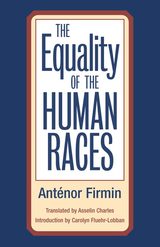 The Equality of Human Races: Positivist Anthropology
Anténor Firmin, Translated from the French by Asselin Charles. Introduction by Carolyn Fluehr-Lobban
University of Illinois Press, 2000 Rediscovering an early scientific challenge to racism This is the first paperback edition of the only English-language translation of the Haitian scholar Anténor Firmin's The Equality of the Human Races, a foundational text in critical anthropology first published in 1885 when anthropology was just emerging as a specialized field of study. Marginalized for its "radical" position that the human races were equal, Firmin's lucid and persuasive treatise was decades ahead of its time. Arguing that the equality of the races could be demonstrated through a positivist scientific approach, Firmin challenged racist writings and the dominant views of the day. Translated by Asselin Charles and framed by Carolyn Fluehr-Lobban's substantial introduction, this rediscovered text is an important contribution to contemporary scholarship in anthropology, pan-African studies, and colonial and postcolonial studies.
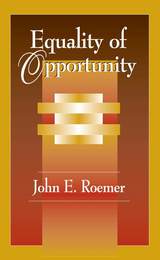 Equality of Opportunity
John E. Roemer
Harvard University Press, 1998 John Roemer points out that there are two views of equality of opportunity that are widely held today. The first, which he calls the nondiscrimination principle, states that in the competition for positions in society, individuals should be judged only on attributes relevant to the performance of the duties of the position in question. Attributes such as race or sex should not be taken into account. The second states that society should do what it can to level the playing field among persons who compete for positions, especially during their formative years, so that all those who have the relevant potential attributes can be considered.
Common to both positions is that at some point the principle of equal opportunity holds individuals accountable for achievements of particular objectives, whether they be education, employment, health, or income. Roemer argues that there is consequently a "before" and an "after" in the notion of equality of opportunity: before the competition starts, opportunities must be equalized, by social intervention if need be; but after it begins, individuals are on their own. The different views of equal opportunity should be judged according to where they place the starting gate which separates "before" from "after." Roemer works out in a precise way how to determine the location of the starting gate in the different views.
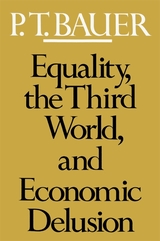 Equality, the Third World, and Economic Delusion
P. T. Bauer
Harvard University Press Even in impoverished countries lacking material and human resources, P. T. Bauer argues, economic growth is possible under the right conditions. These include a certain amount of thrift and enterprise among the people, social mores and traditions which sustain them, and a firm but limited government which permits market forces to work. Challenging many views about development that are widely held, Bauer takes on squarely the notion that egalitarianism is an appropriate goal. He goes on to argue that the population explosion of less-developed countries has on the whole been a voluntary phenomenon and that each new generation has lived better than its forebears. He also critically examines the notion that the policies and practices of Western nations have been responsible for third world poverty. In a major chapter, he reviews the rationalizations for foreign aid and finds them weak; while in another he shows that powerful political clienteles have developed in the Western nations supporting the foreign aid process and probably benefiting more from it than the alleged recipients. Another chapter explores the link between the issue of Special Drawing Rights by the International Monetary Fund on the one hand and the aid process on the other.
Throughout the book, Bauer carefully examines the evidence and the light it throws on the propositions of development. Although the results of his analysis contradict the conventional wisdom of development economics, anyone who is seriously concerned with the subject must take them into account.
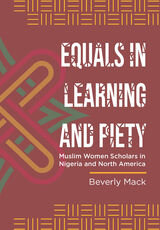 Equals in Learning and Piety: Muslim Women Scholars in Nigeria and North America
Beverly Mack
University of Wisconsin Press, 2023 Equals in Learning and Piety is an intellectual history of the ‘Yan Taru (Associates) movement, a women-led Islamic educational organization that continues to this day in both northern Nigeria and in the United States. Drawing on extensive scholarship across disciplines including history, Islamic studies, anthropology, gender and women’s studies, and literary studies—and alongside rigorous ethnographic research and interviews with leading Nigerian Muslim scholars—Beverly Mack argues that this formidable Muslim women’s movement consolidated the religious and social order established by the Sokoto Jihad in the early nineteenth century.
Mack shows how women scholars instructed rural Hausa and Fulani women in Muslim ethics, doctrine, traditions, and behavior that followed and replaced the traumatic experience of warfare unleashed by the Jihad. She shows that these unique social engagements shaped people’s agency in the dynamic process of social change throughout the nineteenth century. Women imaginatively reconciled Muslim reformist doctrines and traditional practices in Nigeria, and these doctrines have continued to be influential in the diaspora, especially among Black American Muslims in the United States in the twenty-first century. With this major investigation of a little-studied phenomenon, Mack demonstrates the importance of women to the religious, political, and social transformation of Nigerian Muslim society.
 An Equation That Changed the World: Newton, Einstein, and the Theory of Relativity
Harald Fritzsch
University of Chicago Press, 1994 Fritzsch offers readers the opportunity to listen in on a meeting of Isaac Newton, Albert Einstein, and a present-day physicist. While he introduces the theory of relativity, Fritzsch teaches its sources, its workings, and the ways it has revolutionized our view of the physical world. An Equation That Changed the World dramatizes the importance of relativity, for the human race, and the survival of our planet.
"Fritzsch could not give the modern reader a more memorable introduction to the personalities and science of Isaac Newton and Albert Einstein unless somehow he could find the keys to H. G. Wells' time machine. . . . Many readers will applaud Fritzsch for this lively but profoundly insightful book." —Booklist, starred review
"[Fritzsch] has dreamed up a dialogue between the two great physicists, helped along by a fictional modern physicist. . . . The conversation builds up to an explanation of E=mc2, and on the way illuminates the important points where Newtonian and Einsteinian theory diverge." —David Lindley, New York Times Book Review
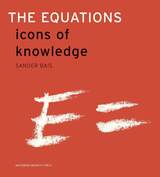 The Equations: Icons of knowledge
Sander Bais
Amsterdam University Press, 2005 For thousands of years mankind has tried to understand nature. Exploring the world on all scales with instruments of ever more ingenuity, we have been able to unravel some of the great mysteries that surround us. While collecting an overwhelming multitude of observational facts, we discovered fundamental laws that govern the structure and evolution of physical reality. We know that nature speaks to us in the language of mathematics. In this language most of our basic understanding of the physical world can be expressed in an unambiguous and concise way. The most artificial language turns out to be the most natural of all. The laws of nature correspond to equations. These equations are the icons of knowledge that mark crucial turning points in our thinking about the world we happen to live in. They form the symbolic representation of most of what we know, and as such constitute an important and robust part of our culture. Publication coincides with the World Year of Physics: www.wyp2005.nl“This beautifully designed book deserves a place on the coffee table .[..] Sander Bais confides the reader in the exciting secrets of the laws of nature, and does so in a clear, surprisingly poetic language.” “ The Equations is a catalogue. A catalogue that belongs to an exhibition of 17 typographic works of art – which gallery will frame them and hang them on the wall? The formulas, displayed in white symbols on a bright red background, are of an untouchable beauty .” ‘Untouchable icons’ - NRC Handelsblad “ The Equations is an absolute feast for everyone who is interested in what physicists have to say about the structure of the world and the beauty that emanates from this. It is a jewel of knowledge, written with love for the field but also with a great compassion for the reader.” ‘Knowledge smoothly surpasses the fear of formulas’ - de Volkskrant
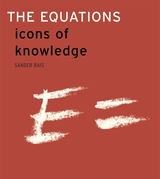 The Equations: Icons of Knowledge
Sander Bais
Harvard University Press, 2005 The mysteries of the physical world speak to us through equations--compact statements about the way nature works, expressed in nature's language, mathematics. In this book by the renowned Dutch physicist Sander Bais, the equations that govern our world unfold in all their formal grace--and their deeper meaning as core symbols of our civilization.
Trying to explain science without equations is like trying to explain art without illustrations. Consequently Bais has produced a book that, unlike any other aimed at nonscientists, delves into the details--historical, biographical, practical, philosophical, and mathematical--of seventeen equations that form the very basis of what we know of the universe today. A mathematical objet d'art in its own right, the book conveys the transcendent excitement and beauty of these icons of knowledge as they reveal and embody the fundamental truths of physical reality.
These are the seventeen equations that represent radical turning points in our understanding--from mechanics to electrodynamics, hydrodynamics to relativity, quantum mechanics to string theory--their meanings revealed through the careful and critical observation of patterns and motions in nature. Mercifully short on dry theoretical elaborations, the book presents these equations as they are--with the information about their variables, history, and applications that allows us to chart their critical function, and their crucial place, in the complex web of modern science.
Reading The Equations, we can hear nature speaking to us in its native language.
Equatorial Guinean Literature in its National and Transnational Contexts
Marvin A. Lewis
University of Missouri Press, 2017 This is the first book to interpret the African dimension of contemporary Hispanic literature.
Equatorial Guinea, a former Spanish colony, is the only African country in which Spanish is an official language and which has a tradition of literature in Spanish. This is a study of the literature produced by the nation’s writers from 2007 to 2013. Since its independence in 1968, Equatorial Guinea has been ruled by dictators under whom ethnic differences have been exacerbated, poverty and violence have increased, and critical voices have been silenced. The result has been an exodus of intellectuals—including writers who express their national and exile experiences in their poems, plays, short stories, and novels. The writers discussed include Juan Tomás Ávila Laurel, Donato Ndongo-Bidyogo, and Guillermina Mekuy, among others.
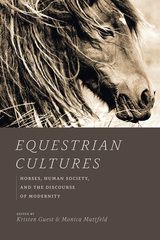 Equestrian Cultures: Horses, Human Society, and the Discourse of Modernity
Edited by Kristen Guest and Monica Mattfeld
University of Chicago Press, 2019 As much as dogs, cats, or any domestic animal, horses exemplify the vast range of human-animal interactions. Horses have long been deployed to help with a variety of human activities—from racing and riding to police work, farming, warfare, and therapy—and have figured heavily in the history of natural sciences, social sciences, and the humanities. Most accounts of the equine-human relationship, however, fail to address the last few centuries of Western history, focusing instead on pre-1700 interactions. Equestrian Cultures fills in the gap, telling the story of how prominently horses continue to figure in our lives, up to the present day.
Kristen Guest and Monica Mattfeld place the modern period front and center in this collection, illuminating the largely untold story of how the horse has responded to the accelerated pace of modernity. The book’s contributors explore equine cultures across the globe, drawing from numerous interdisciplinary sources to show how horses have unexpectedly influenced such distinctively modern fields as photography, anthropology, and feminist theory. Equestrian Cultures boldly steps forward to redefine our view of the most recent developments in our long history of equine partnership and sets the course for future examinations of this still-strong bond.
 Equilibrium in Solutions and Surface and Colloid Chemistry
George Scatchard
Harvard University Press, 1976 This volume brings together two previously unpublished works by the late George Scatchard. One of the most eminent physical chemists of this century, Scatchard, in collaboration with Edwin Cohn, had enormous influence on the development of protein chemistry. The “Scatchard Plot,” a device for evaluating the interaction of proteins with smaller molecules, is today a ubiquitous feature of articles on biochemistry, immunology, and endocrinology.
These two monographs concern the laws of thermodynamics and the Oebye-Huckel theory as they are applied to the physical chemistry of inorganic and organic systems in solution. A unique feature of both works is their detailed extension of thermodynamic principles to the interactions of dissolved proteins with each other and with small molecules. They represent one of the most important links between the classical physical chemistry of the first four decades of this century and the contemporary science of protein chemistry.
Known previously only to a limited audience of Scatchard's students and colleagues, these remarkable treatises deserve much wider circulation today. Succinct, comprehensive, and systematic, they will stand as useful guides to one of the central sciences of our time.
 Equine Poetics
Ryan Platte
Harvard University Press, 2017 Equine Poetics is a literary analysis of horses and horsemanship in early Greek epic and lyric poetry, especially those facets that reflect the prehistory of Greek language and culture.
The book begins with Ryan Platte’s analysis of Homeric formulas for horses, proposing a model by which most such formulas may be understood as members of a single verbal network, with roots in preliterate antiquity. He then considers the poetic relationship between horses and humans, leading to an analysis of the figure of the metapoetic charioteer. Finally, the work compares myths featuring chariot races and bridal contests, focusing on the supposed mythological inventiveness of Pindar’s Olympian 1.
Platte develops a methodology rooted in oral verse mechanics to understand contest-based mythical parallels that have defied easy historical explanations—in Greece and beyond. Drawing from the fields of comparative poetics and historical linguistics, Equine Poetics sheds new light on fascinating and puzzling aspects of these central figures in early Greek verbal art.
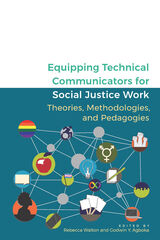 Equipping Technical Communicators for Social Justice Work: Theories, Methodologies, and Pedagogies
Rebecca Walton
Utah State University Press, 2021 Equipping Technical Communicators for Social Justice Work provides action-focused resources and tools—heuristics, methodologies, and theories—for scholars to enact social justice. These resources support the work of scholars and practitioners in conducting research and teaching classes in socially just ways. Each chapter identifies a tool, highlights its relevance to technical communication, and explains how and why it can prepare technical communication scholars for socially just work.
For the field of technical and professional communication to maintain its commitment to this work, how social justice intersects with inclusivity through UX, technological, civic, and legal literacies, as well as through community engagement, must be acknowledged. Equipping Technical Communicators for Social Justice Work will be of significance to established scholar-teachers and graduate students, as well as to newcomers to the field.
Contributors: Kehinde Alonge, Alison Cardinal, Erin Brock Carlson, Oriana Gilson, Laura Gonzales, Keith Grant-Davie, Angela Haas, Mark Hannah, Kimberly Harper, Sarah Beth Hopton, Natasha Jones, Isidore Kafui Dorpenyo, Liz Lane, Emily Legg, Nicole Lowman, Kristen Moore, Emma Rose, Fernando Sanchez, Jennifer Sano-Franchini, Adam Strantz, Cana Uluak Itchuaqiyaq, Josephine Walwema, Miriam Williams, Han Yu
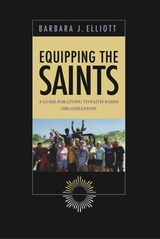 Equipping The Saints
Barbara Elliott
Templeton Press, 2004 For any individual donor or foundation giving money to a faith-based organization, this guide is indispensable. Equipping the Saints offers sage advice on recognizing the qualities of good leaders, effective programs, and the methods of evaluating outcomes. Based on hundreds of interviews with donors and civic leaders, this guide provides a candid look at the unique strengths and weaknesses of these groups. Equipping the Saints is packed with useful tools like a donor's interest inventory, a checklist for making a site visit, tips on reading nonprofit financial statements, and hands-on recommendations for making grants that are both effective and prudent. "An excellent guide for philanthropists seeking to unleash the power of faith in healing troubled souls and transforming troubled neighborhoods." —Adam Meyerson, president, Philanthropy Roundtable "Most donors quickly learn how all that glitters is not gold. Some go on to learn how all that is gold does not glitter. In this book Barbara Elliott provides the lessons in discernment and the tools for evaluation that donors need. Take advantage of her understanding by making it your own." —Marvin Olasky, ditor of World magazine, author of Compassionate Conservatism and The Tragedy of American Compassion "Any donor with even a hint of interest in exploring investments in the work of faith-based organizations (FBOs) needs this book. It is packed with practical information about how to understand and assess FBOs. Its numerous examples of real-life donors making real-life differences through partnerships with faith-inspired community healers ought to stimulate much creative brainstorming among philanthropists." —Dr. Amy L. Sherman, senior fellow and director, Faith in Communities Initiative of the Foundation for American Renewal "From the perspective of a local foundation giving to faith-based ministries, we have found Barbara Elliott's work to be inspiring, practical and instructive to us as we think through our priorities and principles for funding decisions…I have extraordinary respect for Barbara's scope of understanding, ability to communicate with passion and reason, and her deep understanding of a very complex field. She gives all of us—ministries and funders—genuine hope and invaluable insight." —Fred Smith, president, The Gathering
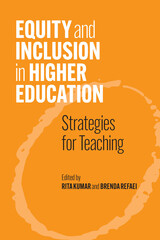 Equity and Inclusion in Higher Education: Strategies for Teaching
Edited by Rita Kumar and Brenda Refaei
University of Minnesota Press, 2020 Americans’ perception of college students does not correlate with the reality of the rich diversity seen on university campuses. Over 60% of Americans believe the average age of a college student is 20 years old but, in fact, it’s 26.4 years old. Demographics in the classroom are shifting and instructors bear a responsibility to adjust their teaching style and curriculum to be inclusive for all students. Equity and Inclusion for Higher Education Strategies for Teaching, edited by Rita Kumar and Brenda Refaei, details the necessity for an inclusive curriculum with examples of discipline-specific activities and modules. The intersectionality of race, age, socioeconomic status, and ability all embody the diversity college instructors encounter in their classrooms. Through the chapters in this book, the contributors make apparent the "hidden curriculum," which is taught implicitly instead of explicitly. The editors focus on learner-centered environments and accessibility of classroom materials for traditionally marginalized students; a critical part of the labor needed to create an inclusive curriculum. This text provides instructors with resources to create equity-based learning environments. It challenges instructors to see beyond Eurocentric curriculums and expand their pedagogy to include intercultural competence. The contributors challenge the student/instructor dichotomy and embrace collaboration between the two to construct a curriculum that fits all students' needs. The resources and examples in this book demonstrate the importance of inclusion and equity in the classroom. A companion community page provides examples and tools from the editors and contributing authors, which allows for readers to add materials from their own classrooms. This book and collaborative toolkit allow instructors to begin intentional practice of an inclusive curriculum and implement changes to promote respect for diversity.
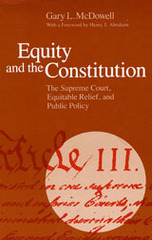 Equity and the Constitution: The Supreme Court, Equitable Relief, and Public Policy
Gary L. McDowell
University of Chicago Press, 1982 Since the landmark desegregation decisions in the Brown vs. Board of Education cases, the proper role of the federal judiciary has been hotly debated. Has the federal judiciary, in its attempt to legislate social policy, overstepped its constitutional boundaries?
In this volume, Gary McDowell considers the equity power created by Article III of the Constitution, on which the most controversial decisions of the Supreme Court have rested. He points out the equity was originally understood as an extraordinary means of offering relief to individuals in cases of fraud, accident, mistake, or trust and as a means of "confining the operation of unjust and partial laws." It has now been stretched to offer relief to broadly defined social classes. This "sociological" understanding, in McDowell's view, has undermined equity as a substantive body of law. He urges a return to the former definition as a means of restraining the reach of federal jurisdiction.
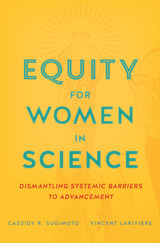 Equity for Women in Science: Dismantling Systemic Barriers to Advancement
Cassidy R. Sugimoto and Vincent Larivière
Harvard University Press, 2023 The first large-scale empirical analysis of the gender gap in science, showing how the structure of scientific labor and rewards—publications, citations, funding—systematically obstructs women’s career advancement.
If current trends continue, women and men will be equally represented in the field of biology in 2069. In physics, math, and engineering, women should not expect to reach parity for more than a century. The gender gap in science and technology is narrowing, but at a decidedly unimpressive pace. And even if parity is achievable, what about equity?
Equity for Women in Science, the first large-scale empirical analysis of the global gender gap in science, provides strong evidence that the structures of scientific production and reward impede women’s career advancement. To make their case, Cassidy R. Sugimoto and Vincent Larivière have conducted scientometric analyses using millions of published papers across disciplines. The data show that women are systematically denied the chief currencies of scientific credit: publications and citations. The rising tide of collaboration only exacerbates disparities, with women unlikely to land coveted leadership positions or gain access to global networks. The findings are unequivocal: when published, men are positioned as key contributors and women are relegated to low-visibility technical roles. The intersecting disparities in labor, reward, and resources contribute to cumulative disadvantages for the advancement of women in science.
Alongside their eye-opening analyses, Sugimoto and Larivière offer solutions. The data themselves point the way, showing where existing institutions fall short. A fair and equitable research ecosystem is possible, but the scientific community must first disrupt its own pervasive patterns of gatekeeping.
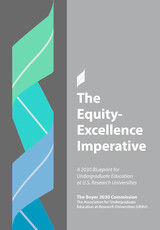 The Equity/Excellence Imperative: A 2030 Blueprint for Undergraduate Education at U.S. Research Universities
The Boyer 2030 Commission
University Press of Colorado, 2022 In 2021, The Association for Undergraduate Education at Research Universities (UERU)—with over 100 research university members and hosted at Colorado State University since 2013—recruited The Boyer 2030 Commission. This group was co-chaired by AAU’s Barbara R. Snyder and APLU’s Peter McPherson and included 14 additional distinguished higher ed leaders. The Boyer 2030 Commission sought to update the1998 Boyer Report, the landmark publication that inspired UERU’s founding in 2000 and helped spur nearly a quarter century of progress. Upon a year of research and reflection, the Boyer 2030 Commission issued The Equity/Excellence Imperative: A Blueprint for Undergraduate Education at U.S. Research Universities, reiterating the vital importance of undergraduate education at research universities and the need to invest in meeting what they name as the equity/excellence imperative. From the Report:
"Research university presidents/chancellors, provosts, and their senior colleagues are today called upon to lead in a challenging world of deeply entrenched inequities laid bare by a deadly pandemic; a long-overdue racial reckoning; fractured democratic institutions and frayed democratic norms; an existential planetary climate emergency; a mental health crisis affecting all ages, including and especially traditional-aged undergraduate students; and growing public disaffection with and distrust of higher education. College-going and the prestige of a college degree are in decline, and, despite efforts to recruit and retain low-income undergraduate students, new data show that research universities were serving even fewer of them prior to the pandemic, let alone as a result. The Boyer 2030 Commission Report is organized around what the Commission has termed the ‘equity/excellence imperative,’ a belief that excellence and equity are inextricably entwined, such that excellence without equity (privilege reproducing privilege) is not true excellence, and equity (mere access) without excellence is unfulfilled promise. At this pivotal moment, the Boyer 2030 Commission poses these fundamental questions: - How can US research universities embrace the equity/excellence imperative?
- Can we commit to equity as a necessary and defining precondition of excellence?
- Can we conceive, prioritize, and invest in equitable undergraduate achievement?
- Can we educate and support undergraduates for 21st-century world readiness?
Meeting the equity/excellence imperative offers a leadership opportunity. Recognizing that diversity of mission, identity, organization, and culture is a long-standing strength of U.S. higher education, the Boyer 2030 Commission offers 11 provocations to catalyze the multiple actions needed for a research university to realize the equity/excellence imperative. This report will aid leaders as they work to meet this imperative, and millions of undergraduate students, their alma maters and broader human society will meaningfully and measurably benefit as a result." This book is also available as an open access ebook through the UERU.
Co-Chairs: Barbara R. Snyder, President, AAU and Peter McPherson, President Emeritus, APLU Commission Members: Michael Crow, President, Arizona State University; Andrew Delbanco, President, Teagle Foundation; Roger Ferguson, former President, TIAA-CREF; Kathleen Fitzpatrick, Director of Digital Humanities, Michigan State University; Kevin Kruger, President and CEO, NASPA–Student Affairs Administrators in Higher Education; Gary May, Chancellor, University of California, Davis; Sarah Newman, Director of Art and Education at metaLAB, Harvard University; Lynn Pasquerella, President, American Association of Colleges & Universities; Deborah Santiago, Co-Founder and CEO, Excelencia in Education; Claude Steele, Lucie Stern Professor in the Social Sciences, Emeritus, Stanford University; Holden Thorp, Editor-in-Chief, Science; Eric Waldo, Founding Executive Director of Michelle Obama’s Reach Higher; Mary Wright, Associate Provost for Teaching and Learning, Brown University; Ex officio: Elizabeth Loizeaux, Boston University; Former President, UERU Staff: Liz Bennett, Associate Director, UERU; Steven Dandaneau, Executive Director, UERU; Howard Gobstein, Senior Vice President, APLU; Ken Goldstein, Senior Vice President, AAU; Tara King, Education Program and Evaluation Manager, AAU; Emily Miller, Deputy Vice President, AAU; Mariah Pursley, Senior Coordinator, UERU; Kacy Redd, Associate Vice President, APLU; Liz Wasden, Research Assistant, University of Maryland, College Park
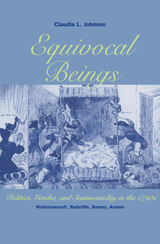 Equivocal Beings: Politics, Gender, and Sentimentality in the 1790s--Wollstonecraft, Radcliffe, Burney, Austen
Claudia L. Johnson
University of Chicago Press, 1995 In the wake of the French Revolution, Edmund Burke argued that civil order depended upon nurturing the sensibility of men—upon the masculine cultivation of traditionally feminine qualities such as sentiment, tenderness, veneration, awe, gratitude, and even prejudice. Writers as diverse as Sterne, Goldsmith, Burke, and Rousseau were politically motivated to represent authority figures as men of feeling, but denied women comparable authority by representing their feelings as inferior, pathological, or criminal. Focusing on Mary Wollstonecraft, Ann Radcliffe, Frances Burney, and Jane Austen, whose popular works culminate and assail this tradition, Claudia L. Johnson examines the legacy male sentimentality left for women of various political persuasions.
Demonstrating the interrelationships among politics, gender, and feeling in the fiction of this period, Johnson provides detailed readings of Wollstonecraft, Radcliffe, and Burney, and treats the qualities that were once thought to mar their work—grotesqueness, strain, and excess—as indices of ideological conflict and as strategies of representation during a period of profound political conflict. She maintains that the reactionary reassertion of male sentimentality as a political duty displaced customary gender roles, rendering women, in Wollstonecraft's words, "equivocal beings."
Equivocal Oaths and Ordeals in Medieval Literature
Ralph J. Hexter
Harvard University Press, 1975 The use of ordeals and sworn oaths to prove one's innocence invites trickery. The guilty trickster cannot influence the judgment of the divine powers, but he can—by disguise or by equivocation in wording the oath—create a presumption of innocence. Ralph Hexter surveys the varieties of such stories in a number of folk literatures and looks at the use of this motif in three important medieval story cycles, with special attention to the way Christian writers handled story material based on a pre-Christian act of truth.
|
|

